new posts in all blogs
Viewing: Blog Posts Tagged with: NYCC 14, Most Recent at Top [Help]
Results 1 - 25 of 65
How to use this Page
You are viewing the most recent posts tagged with the words: NYCC 14 in the JacketFlap blog reader. What is a tag? Think of a tag as a keyword or category label. Tags can both help you find posts on JacketFlap.com as well as provide an easy way for you to "remember" and classify posts for later recall. Try adding a tag yourself by clicking "Add a tag" below a post's header. Scroll down through the list of Recent Posts in the left column and click on a post title that sounds interesting. You can view all posts from a specific blog by clicking the Blog name in the right column, or you can click a 'More Posts from this Blog' link in any individual post.
Independent Sources is a local to NYC show that spotlights ethnic and local news. Hosted by Zyphus Lebrun, it’s put together by CUNY (City University of New York ) and runs on their cable station. Last week’s episode, covers various aspects of diversity in comics, with thoughtful interviews with Marvel’s Sana Amanat, Image’s David Brothers, Morgan Dubin from Abrams Comic Arts, Jonathan Gray, Assistant Professor of English, John Jay College, artist Dexter Vines and yours truly. Aside from my having to terrifyingly reënect walking into a comic shop, it’s a sprightly look at the basic issues of diversity and the widening audience for comics. There’s also a nice segment on a cosplayer who designed a Rita Repulsa costume and others for curvier women.
Amanat does I nice job, I think of putting the recent changes into perspective—it’s always on their minds, she says, but it has to be balanced against business realities. Luckily, business realities now are favoring diversity of material.


By:
Heidi MacDonald,
on 10/28/2014
Blog:
PW -The Beat
(
Login to Add to MyJacketFlap)
JacketFlap tags:
Politics,
Culture,
Commentary,
Fandom,
NYCC,
Tor books,
Indie Comics,
Top News,
LeSean Thomas,
The Boondocks,
Black Dynamite,
I.W. Gregorio,
NYCC '14,
Daniel Jose Older,
Alice Meichi Li,
Diana Pho,
Geeks of Color Go Pro,
Half-Resurrection Blues,
Tracey J. John,
News,
Webcomics,
Conventions,
Add a tag
by Edie Nugent
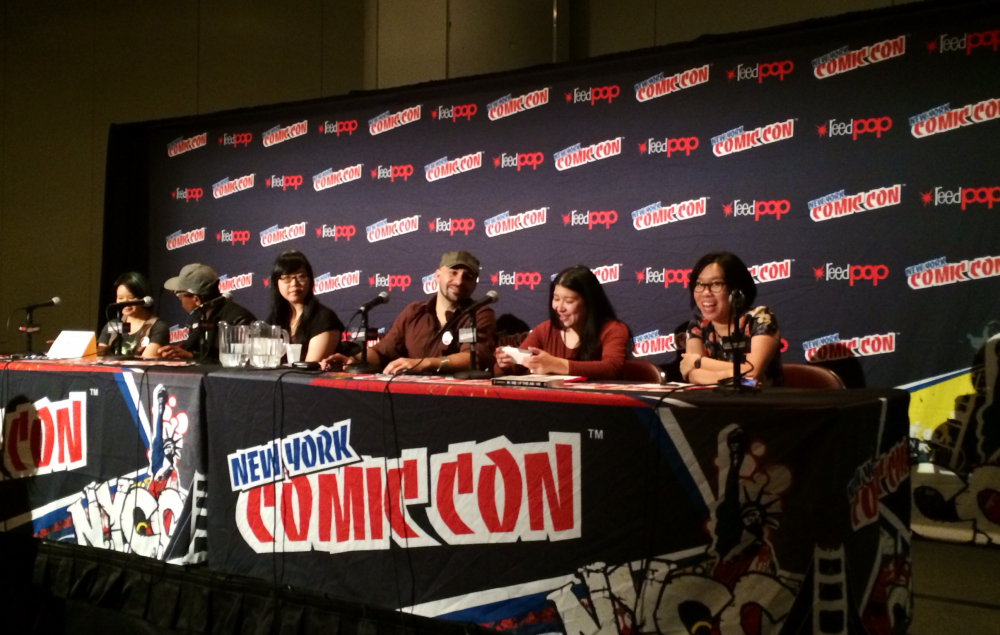
From L to R: Diana Pho, LeSean Thomas, Alice Meichi Li, Daniel Jose Older, I.W. Gregorio and Tracey J. John
The main stage spectacles of NYCC saw panels filled with celebrity actors and moderators alike, whipping thousands of screaming audience members into a frenzy. No less intense or enthusiastic, however, were the panels scheduled towards the end of the night in the smaller conference rooms at the Javits Center. Once such panel —Geeks of Color Go Pro —filled its room to capacity with a diverse audience of fans and comic book industry hopefuls cheering just as passionately as fans in the rooms twice its size.
“Don’t be afraid to challenge the status quo,” declared Tracy J. John, writer for such marquee video game franchises as Oregon Trail and My Little Pony: Friendship is Magic. This comment, which came later in the proceedings, proved to be a kind of mission statement for the panel as a whole. Moderated by Tor Books editor Diana Pho, the panel participants represented a diversity of gender, race, and sexual orientation.
Pho opened by asking the panel to tell their “origin stories,” referring to how they arrived at their current careers within an industry that has long suffered from a dearth of diversity. Tracey J. John kicked things off, saying: “a long long time ago in a galaxy far, far away…I went to NYU and got a bachelor’s degree in Communication Studies.” She went on to say that she garnered an internship at MTV News, which led to a job working for MTV.com. “We wrote about these things called ‘music videos,’” she joked. This job placed her in the perfect spot to capitalize on her World of Warcraft addiction when MTV looked to launch a video game focused section of its website. She recalled thinking, “whoa, I can get paid to write about video games?” She later turned to freelance work for Wired, NY Post, and Playstation Magazine. Desirous of a more stable paycheck, she turned to a job at Gameloft and worked in game development. Recently she decided to shake things up again, and has returned to freelance work.
I.W. Gregorio, who claims she’s still getting used to being addressed by the pen name her day job requires, opened by speaking the question on the minds of many an audience member: “How did a urologist end up being a YA author?” She went on to explain she felt the better question to be “why would an aspiring author become a doctor?” She spoke of her racially isolated childhood where she knew immediately she wanted to be a writer, but felt family pressure “like a lot of kids of color” to enter either law or medicine to be deemed a ‘success’ culturally. Her talents in math and science led her to choose the path of medicine, “enough people had told me that I wanted to be a doctor that I ended up being one.” She did attempt, in her words, to “try to have my cake and eat it too” also studying English while in college. She went on to pursue medicine and take a 10 year break from writing before her passion was reignited during her residency. She is, however, grateful to be a doctor because it “enables my writing career…and gives me a lot of stories.” She described how her new book None of the Above was inspired by an intersex teenager she treated during her residency.
Daniel Jose Older, author of the upcoming Half-Resurrection Blues, the first book in what is to be an ongoing urban fantasy series for Penguin Book’s Roc imprint, began by saying that Gregorio’s story “actually really connects to mine. In 2009 I was a paramedic and community organizer doing work on gender violence and intersections of racism. I was trying how to figure out how to have a voice and what that meant as a writer.” He explained that he loved Star Wars and Harry Potter, but that he and the kids of color he was working work didn’t see themselves in those stories, “and there was a disconnect.” This inspired him to “sit down and write Shadowshaper which got picked up by the folks at Scholastic that put out Harry Potter, so it was this really big dream come true.” He went on to explain that the process of publishing that first work took over 6 years and that “publishing will make you learn patience” which drew a big laugh from the crowd. He continued to work on stories during that time, and work on adult fiction, which led him to Half-Resurrection Blues, due out in 2015. He explained that his background as a paramedic directed inspired the new book, saying: “a lot of this comes from being on the front lines…dealing with life and death.”
Author Alice Meichi Li knew she wanted to be an artist since the age of five. “I grew up in a Chinese restaurant in a really rough part of Detroit,” she said. She explained how this kept her indoors for her own safety, drawing on the back of the placemats of her parents’ restaurant. She also felt pushed towards a career in more economically dependable fields like law, medicine, or IT technologies. “When faced with the prospect of applying for college, all I could think about was arts school. I was in Army Junior ROTC and my Staff Sargent saw some of my art and he said: what are you doing here? You should be taking art class, you should be pursuing this.” She eagerly took his advice, worrying her family regarding her future. As she graduated High School at the top of her class, they told her she should be making “six-figures somewhere”—not becoming a starving artist. She conceded that’s “pretty much what happened” to the amusement of the audience, “I did have to end up balancing a day job,” with her art career, working at the well-known comic book store Forbidden Planet. “But I was doing Artist’s Alleys and that’s how I made a lot of my connections. If you’re trying to be an artist in comics that’s pretty much your best bet.”
“Everybody’s got all these cool stories,” remarked Black Dynamite producer and director LeSean Thomas. “I was born and raised in the South Bronx, John Adams projects at 152nd Street,” some in the crowd applauded at this mention—then laughed as Thomas joked that he was in the part of the Bronx that exists “past Yankee Stadium” where most New Yorkers’ familiarity with the Bronx begins and ends. “I grew up watching Saturday morning cartoons, reading comics books, “ he recalled, saying that he felt comic books was a more realistic career path for him, as the tools used to produce comics were more affordable than that of cartoon animation: “they don’t sell light-boxes at the bodegas,” he quipped.
Thomas ended up in a High School arts program called Talent Unlimited. Following High School he took a job at a sporting goods store to make ends meet. While working there, he was spotted sketching by his store manager whose wife worked at a children’s accessories company. The company quickly employed him to work on designs for accessories featuring licensed characters. Through his work there, he met Joe Rodgers who mentored the young artist and eventually Thomas “became a flash artist/storyboard artist on this web-cartoon called WorldGirl, and it got picked up by Showtime, I think it was the first cartoon to get picked up by a major network.” His success there led to his meeting Carl Jones, who moved to Los Angeles and teamed with The Boondocks creator Aaron MacGruder on the now famous Cartoon Network series based on MacGruder’s comic strip of the same name. “He needed people who could understand Hip-Hop culture, Anime, and social political racial satire, and it was very hard to find that kind of talent in Hollywood,” he paused as the crowd laughed before putting it bluntly: “let alone somebody who could draw a black person.” This led him to move to Los Angeles to work on the show, which he feared would soon be canceled due to its controversial and sometimes “wildly inappropriate” content.
The series proved a critical and ratings success for Cartoon Network, and Thomas felt liberated by the mostly black racial makeup of The Boondocks’ creative team. “I grew up in a society where the White male was the dominant character…to be able to work on a show where my boss was Black, the characters we were creating were Black and we were saying the things we wanted to say without caring what other people thought, Black or White, was really liberating and was one of the best experiences for me.” He went on to comment that his experience working on The Boondocks “catapulted his career,” gave him the chance to move overseas, and opened many career opportunities for him-not the least of which was his teaming up producer Carl Jones to produce the Adult Swim series Black Dynamite. He noted how rare it was to have three shows in a row to his credit that found him working under Black people, on shows starting Black characters: The Boondocks, Legend of Korra, and Black Dynamite.
“I guess I should pitch in about myself, and I thought: oh, I’m the moderator—just sit here and look pretty,” joked Diana Pho, before continuing: “I grew up in New England, in a very White town. I was always the only Asian girl in my class and my family is from Vietnam: no one knew where Vietnam was, because actually in my High School they never talked about the Vietnam War.” This statement elicited shocked sounds from the assembled crowd, but also some knowing murmurs that appeared to understand all too well the sort of erasure her statement described. Pho explained that she found escape from her outsider status through books, especially science fiction and fantasy novels. While studying English at college, she knew felt her options for employment were limited to work as a teacher, continuing her studies of Russian-her minor field-in order to obtain her Master’s Degree in it, or something else. “I chose something else,” she said, “and that was publishing.”
She explained she felt publishing to be a small field, insular in nature-and a field where it “has to do with the connections you make, that’s what I learned” and mentioned that her first job involved editing test books for college admissions for a summer. “What it did provide me was internship experience in marketing,” Pho remarked, explaining that this led to her getting a job with Hachette Press. She worked there in sales and marketing for several years before a colleague recommended her for a position at the Science Fiction Book Club making catalogues. She ended up following this with a Master’s in Performance Studies-doing her thesis in Steampunk performance-and graduated to assume her current role at Tor Books.
The panel then opened up for questions from the audience where Pho asked that the questions be “tweet-sized” to try and get to everyone’s question , but the line for the microphone grew long enough that the panel was forced to wrap up with audience members still on line. When asked: “what was one thing that you wish you knew when you started out that you know now?” Gregorio explained that as a representative of the We Need Diverse Books campaign (weneeddiversebooks.tumblr.com) “I’d be remiss if I didn’t say that there are obviously challenges for diverse authors, the first book I wrote had and Asian-American multicultural protagonist-and three different editors said: oh, it’s too similar to another book with an Asian-American character.” She explained that she knew other authors of color who had run into enough of the same problem that they feared they might have to only write about White characters going forward. “The We Need Diverse Books campaign is most effective because it’s been showing the gatekeepers that they are wrong. Fifty percent of children in schools today are children of color, but only ten percent of books have minority protagonists.” She also called upon the audience to open up their wallets and support works by authors of color and/or featuring main characters of color.
John added on to Gregorio’s comments by telling the audience to not be afraid of the status quo, and gave an example of her work in gaming journalism. “Things that I did…aside from asking the questions I needed to do my job, I’d throw in some poignant questions, I’ve asked Shigeru Miyamoto: why does Princess Peach need saving again? Didn’t she get some self-defense classes by then? Or the developer of a family game why there wasn’t an option to be a Black person, they just had different tans? Ask those kinds of questions. It can be intimidating: Oh I have this opportunity to interview a game developer, I don’t want to screw it up. I’d say ask the normal questions and then save those for the end.”
“When you’re starting out as a writer there’s a lot of advice given out to you, like: you have to build your platform, you have to network! And there’s this very common, very White Western narrative of breaking out as an author. Where you’re that singular rocket ship that flies away to become famous overnight…what it requires us to do, especially as writers and creators of color, is to really reimagine what success means to us anytime we’re entering into any kind of project or career.” He went on to emphasize the need to build community, outside of a “putting points on your resume” style of thinking. “What will sustain you is unity. That’s what will have your back when things are hard, and things will be hard.” He noted that more than fans, writers need people who will tell them the truth-people who will give them the “hard critique.” He also said he wanted to shout-out to: fanbros.com, nerdgasmnoire.net as well as blackgirlnerds.com, saying of the organizations: “these groups are collectives of people of color, proudly nerds, proudly of color, talking about racism, talking about Sleepy Hollow. We need to talk about these things because that’s community” to many loud cheers.
Li wished to add “a piece of advice I hear a lot: you are the average of the five people you interact with most in life. So if you have a bunch of people who are ambitious, who are trying to do what you’re trying to do you’re going to kind of automatically get lifted up with them. So you want at least three of them to be in a place where you aspire to be. I add that you should look for someone who is: 1) an older mentor, to get advice from, 2) an equal, that you can be a comrade-at-arms with and share you career path with and 3) someone you can mentor, because you can learn a lot from teaching.”
“The thing that I wish I’d known before getting into animation, that I do now is that all the animation jobs are in California,” said Thomas, to the laughter of the crowd. Thomas clearly meant the comment seriously, adding: “I wouldn’t have stayed in New York as long if I’d have known there were no real animation jobs in New York the way there are in California…I probably would’ve made my pilgrimage a lot sooner.”
Another attendee asked how the artists dealt with accusations of racism. “I just got called racist the other day, so that was fun,” recounted Older, saying that because the bad guys in a recent story were White he had the accusation leveled at him. “There’s no easy answer, but you have to go with your gut and trust your instincts because when the shit flies, you have to be able to stand up for your work. I know what I did in that story—and I have much worse stories about White people than that,” he said, laughing.
Gregorio added: “publishing is a team sport, you’re going to have editors and marketing people-they’ll catch anything really bad. And also you have to realize we’re all going to get criticism. Haters are gonna’ hate, it’s alright!”
A reporter asked if the panel felt any responsibility towards social justice storylines. Thomas replied, “You know on Black Dynamite me and Carl Jones, the executive producer, always used to joke that we were like social workers in animation, not to belittle social work, but we liked to joke that because we were one of the few [shows] that touched on those issues. The most important thing for us is that it has to be funny, that’s the golden rule. The second rule is that it has to be genuine. If it’s honest, if it comes from a good place there’s always humor in it….and the third is to make people uncomfortable, not in a negative way but to make them think outside what they normally expect.”
The final question came from a Bleeding Cool reporter who asked, “Why are we still having this conversation? I feel like we’re constantly having the same conversation: do you see an end to it, do you think? Where we’re not going to need to have ‘Geeks of Color’ in the corner at 8:00pm?”
“So you’re saying Geeks of Color needs to be at noon, is what you’re saying? I agree I think it should be much earlier.” Thomas joked.
Pho added: “we’re going to keep having this conversation until we hit critical mass,” she explained that critical mass was not when people stopped asking questions, but rather that “we need a critical mass of answers from all over the place, not just from us but from you guys—not just from you guys but from everyone at this convention, and not just this convention—about how pop culture functions, how media functions…we all have to hit that critical mass point and that’s when the conversation stops.”
“I feel your point a lot,” Older added, indicating the reporter, “we do need this and part of the reason is the industry is still very racist, still very White, and so we need to have these conversations…the job and the struggle and the challenge for us is to push the conversation forward so it’s not so circular. So that’s why we need diverse books, which is such an important way to get everyone together. We need to talk about power analysis.” Older also stressed that he felt there were necessary conversations that weren’t had before this generation of creators and it was important to recognize: “we’re here because the folks before us fought their fight, so we’re fighting our fight for the next generation of artist of color, writers of color…and that involves getting together and having ‘geeks of color’ panels which makes people uncomfortable, which is good, as it should.”
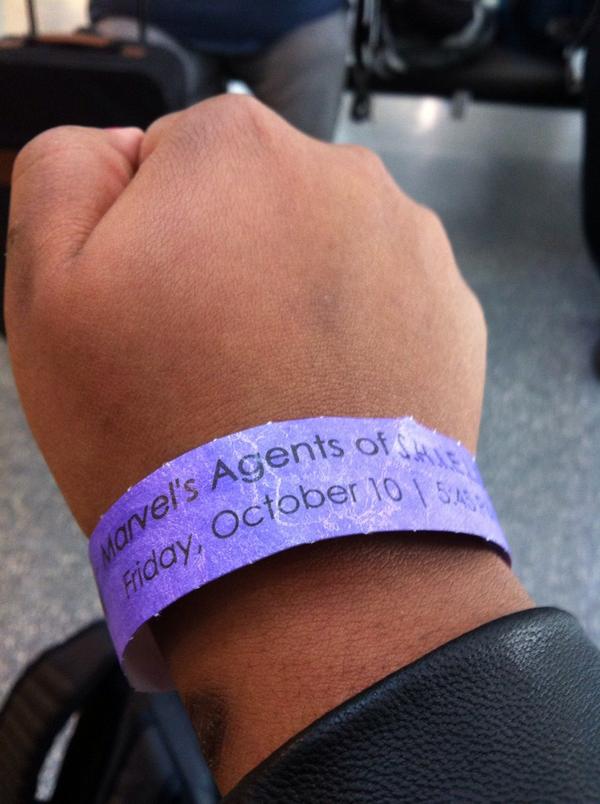
Photo by Angel of Girls Read Comics
I know there are a few panel wrap ups still coming down the pike here and there, but I wanted to essentially wrap up my NYCC coverage with a look a two issues which seem to catch everyone’s attention: the announced attendance of 151,000 and the brand new practice of clearing rooms between panels in the Main Stage.
§ First off, when it was announce NYCC had sold 151,000 tickets, it was quickly assumed by everyone that NYCC was bigger than SDCC, which has an attendance of 130,000. But is this true? In a piece called New York Comic Con Probably Isn’t Bigger Than San Diego Comic-Con Kerry Dixon talks to NYCC showrunner Lance Fensterman who reveals that they count a ticket as a ticket; while SDCC uses the member ID and counts a person as a person. Thus at NYCC a person could buy two tickets and be two people.
“If someone bought a single day Friday and single day Sunday that would be 2 tickets sold,” Fensterman said.
This means, essentially, that New York Comic Con sold 151,000 tickets all combined, but the number of actual, unique attendees is less than that. After all, if even 1,000 attendees purchased two single day tickets, they would be counted as 2,000 people, even though this isn’t Orphan Black and attendees aren’t being cloned left and right.
If even 10,000 people purchased two single day badges (and that number is likely significantly higher)? The system is counting them at 20,000 people.
Fensterman goes on to say
“We have no way to determine who is using those tickets [nor] does it really make any material difference,” Fensterman said. “We theoretically could parse that data in any number of ways depending on how much time and effort and resource we want to put into it. But ultimately the unique ticket sold metric seems to balance giving the most accurate representation of the size of the audience without us going nuts parsing data that really does not add that much value to the customers.”
That’s fair enough, given the way ReedPOP runs shows—they have never been interested in using visible ways to attach a person to a badge—only exhibitors even have an area to WRITE THEIR NAME on their badge—and instead invested in a costly RFID system. For any Kremlinologists out there, I want to point out that when I interviewed Fensterman after the show, he was very careful not to claim that NYCC is larger than SDCC, and while we didn’t get into it as clearly as the USDCCB folks did, he did point out that the number represented “announced tickets sold.”
This is one reason why I have never updated my “biggest cons” chart—some shows use the one person method, some use the one ticket method…and others use a phony method. It’s apple oranges and kumquats. As far as I know, the San Diego folks and the ReedPOP folks have always been very consistent and upfront about their number reporting…it is just a different kind of number being reported.
That said, while it is pretty obvious to anyone who goes to both that more people go to San Diego in and around their Comic-Con, the media narrative will now be that New York’s show is the biggest. I don’t think the CCI folks will lose too much sleep over this, as their show is still the biggest entertainment event in the US.
§ BUT WHAT ABOUT THE ROOM CLEARING???? Was this the last blow against a free society or a new path to enlightenment for people who don’t like to sleep out on the concrete like a homeless person?
As you may recall. this year for the first time at a comic-con, the room where the big showbiz events—Walking Dead, Disney—took place was cleared between each panel. In order to get in you had to line up every morning and get a wristband for your desired panel and then come back later. ReedPOP has used room clearing between panels at some of their Star Wars events so that emboldened them to try it at NYCC, and from all accounts, it went okay. There was one ReedPOP employee caught selling wristbands by a stringer for Bleeding Cool, and that is maybe a bigger issue even as it shows a lack of staff integrity:
Not sure if anyone heard but they caught a volunteer selling wristbands for the walking dead panel on Saturday. Well Reed Pop didn’t catch them it was reported to them by a reporter and they eventually identified who it was but that was after the panel was already over. I think that only actual paid staff should be giving out and allowed access to the wristbands especially for the big crazy panels like the walking dead. Now paid staff could i guess do the same thing but I think someone is less likely to risk their job over making a few bucks selling wristbands then a volunteer would be since really the only thing that happened to the volunteer that got caught is they were banned. The problem wasn’t wide spread but could become so it does show they do need to have a little more controlled access to the wristbands and to who has access and distributes them for next year.
The main improvement over the room clearing system is that you line up in the morning (or overnight) and by noon you know if you are getting in or not and are free to go spend the rest of the day doing fun things. The Unofficial SDCC blog has a discussion of the matter, and commenters seem to think that the more policies you put in place about getting into Hall H, the earlier people will camp out—in fact, someone is camped out for the 2015 TeenWolf panel right now! The logistical problems of having (in theory) some 30,000 people sleep out over night for six or seven panels in HALL H each day would seem to indicate that room clearing is not a no brainer for San Diego. But it did work for NYCC, where crowd control is a work in progress.
There’s more discussion on the room clearing matter at Girls Read Comics:
However, the system isn’t without its flaws. It doesn’t prevent people lining up in the middle of the night to be the first inside the convention center for wristbands. If the success that NYCC had with this year gives Comic Con International the idea to implement a similar system in San Diego, camping out all night for Hall H will just become camping out all night for Hall H wristbands. Yes, the problem of having to room-sit could be solved, but that still means that fans not willing to wait outside at four in the morning will be completely out of luck. That turned out to be the case with the Walking Dead panel at NYCC this year– some convention-goers got in line as early as 5 a.m. to be first in line for wristbands when the Javits Center opened its doors at 10. There were also reports of volunteers offering to sell wristbands to popular panels. There’s also the problem of wanting to see two popular panels on the same day. With NYCC’s current system, you can’t grab a wristband for someone else, so the current system has the advantage there. It’s a win/lose situation, either way you look at it.
§ One last thing, which I’ve mentioned before and in podcasts about NYCC, but the one complaint I heard from many exhibitors was NOT ENOUGH SECURITY ON THE FLOOR. As cons have gotten more crowded, I’ve observed that a visible and active security force is necessary to give an idea of structure and keep crowds in a docile state. NYCC autograph lines are insane, no one knows’ where it’s safe to line up, and it’s a testament to the generally genial nature of the crowd that no one gets hurt. This does need to change, however and the show floor needs to be run in a more strict fashion. Robert Kirkman as signing at the Image Booth on saturday and there was a huge unruly eyebrow of a crowd that needed to be waxed into shape. (The other biggest line I personally saw was for Tiny Rooster Teeth — those guys are huge!)
I also suggested on the PW Comics World More to Come podcast that if NYCC needs to raise revenue, they could raise ticket prices. A four day pass, if you could get one was $95, which seems like a lot of money but really is pretty reasonable. I know that for someone who hasn’t paid to get into a con in 20 years to suggest raising ticket prices is a bit cavalier of me, but the show has as many people as it can handle at the horrific Javits. We’re not dumb here, we know that show is expensive, and the way to increase revenue is NOT to sell more tickets.
All that said, this show had reached a nadir of dread anticipation among almost every pro of my acquaintance, and it turned out…it was pretty good. People had a way better time than they expected. The panels I did went GREAT and the journalism panel was better attended than the San Diego one, with a more engaged audience. If there is one thing that NYCC needs more of it is programming! The panels took a decided turn upwards this year, and seemed to be very well attended. There may well be no place to put more panels, as all the empty space at Javits is used to queue people up—people can’t be lined up outside because of the potential for rain, etc. But where there is a will there is a way.
Finally, there is one problem that I heard addressed only on the show floor—the horrible lines for the ladies restrooms. There are generally way too few bathrooms at the Javits to begin with, but it’s especially bad as female cosplayers use the stalls to change. The ones I was in line with apologized for taking up stalls and time, but said there is no changing room. I did hear that there IS a changing room, but was never able to confirm this one way or another. I understand that setting aside an area for people to change clothes may not be possible from a logistical standpoint, but if there is anyway to free up the immense piddle lines at NYCC, that would be great. That said, don’t wait until the last minute.
And with that, we’re outta here.
§ Congrats to Fantagraphics publisher Gary Groth for winning the Stranger’s Genius Award for Literature. Many would say Gary is strange, many a genius so it all cosmically came together. The Stranger is Seattle’s resident culture paper, and each year it gives out its Genius Awards. Groth prevailed over Ms. Marvel’s G. Willow Wilson and poet Shin Yu Pai.
§ Retailer Brian Hibbs is fretting over the standard attrition that Big Two events are subject to
As this market has shown again and again over the decades, consumer interest in “events” is a fickle thing. Sooner or later every publisher hits a few foul balls, or the public gets tired of oversaturation, or the story just doesn’t work, or whichever of the myriad of reasons… and the retailer is the one left holding the bag. It used to be that when, say, “Secret Wars II” turned out to be a pile of lox, we weren’t that over-extended with orders in the pipeline — 2-3 issues out, sure, but that’s very different from “order forty-six different comics and tie-ins before you’ve had any real amount of time to judge how the first one did.”
People have been saying events are done for as long as there have been events. This also applies to variant covers. Normally I would just say it was ever thus and move on, but this is a changing industry. Where are we going? Damned if I know.
§ Zainab Akhtar and Steve Morris both went to the Lakes Festival this weekend, and they both blogged about it. I understand The Lakes is held in a small picturesque town and the goal is to make it a sort of Angouleme type fest were comics take over the town. I sounds adorable, but read on. Steve had A Quick Nip Round The Lakes Comic Art Festival and noted the many comics themed displays around the town:
Having captured several strongpoints across the city centre, the Festival had not only won a battle of occupation – but one of propaganda. Everywhere you walk (not that there are MANY places to walk in Kendal, which is a teeny tiny nice little place) the shops had transformed themselves
Zainab had a more mixed time:
Foremostly, my whole experience was coloured by people’s reaction toward me. Kendal, and the Lake District by large, is a very white, very middle class region. We saw -I think- maybe 6 people of colour in the time we were there (yes, I counted), and the festival, being located in the town center, on a Saturday with bright, dry weather- was busy, as was the surrounding area. I got stared at a LOT, and if you’re visibly ethnic minority, you will instantly understand the hostile, open up-and-down hard stares of which I speak although some people prefer a eye-contact off. We went into a fish and chip shop for lunch at one point, and people turned their chairs around to simply gawp/glower. As far as I could tell, it seemed to be the headscarf and being overtly Muslim, because the few poc I did briefly pass didn’t seem to be under the same scrutiny, but I could easily be wrong about that. It was deeply unpleasant.
The comics part of the visit was welcoming and tolerant, she notes, but she doesn’t plan to go back either.
§ Grant Morrison was interviewed for Interview magazine and said many Grant Morrison like things.
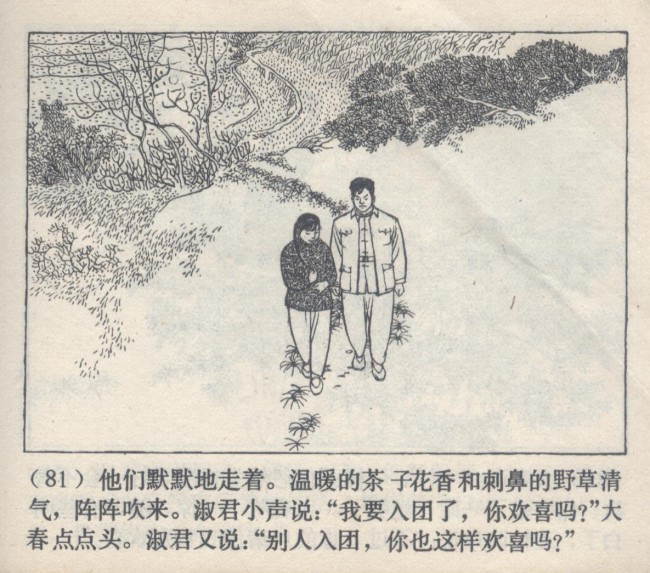
§ R. Orion Martin has a look at another facet of the vast and unknowable world of comcis culture with a history of Lianhuanhua: China’s Pulp Comics. You probably didn’t know that China had a comics culture but of course, they do.
In 1985, there were 8.1 billion pulp comics (lianhuanhua) printed in mainland China. Most lianhuanhua were black and white paperbacks with a single illustration and a few lines of text on each page. They looked similar to the Big Little Books published in the United States from the 1930s to 1950s, but they were published in quantities that make the US comics market look tiny. Brian Hibbs analyzed the 2012 BookScan report and found that there were about 9.5 million comics sold in the US throughout the year. In the mid-80s, some lianhuanhua titles had single printing runs of more than 1 million copies. We usually don’t think of China as having a rich tradition of making comics, and discussions of Chinese comics focus on manhua, the Chinese comics that were inspired by Japanese manga. While it’s true that most of the comics being produced now are manhua, this was not the case for much of the 20th century. From their beginnings in the 1920s until their popularity bottomed out in the 1990s, lianhuanhua were some of the most widely read literature in the country.
§ Speaking of world comics, someone sent me this link, which is in Turkish, but Google Translate tells me it’s about the Turkish comics festival being held in December.
§ Okay cleaning up the last bits of New York Comic-Con here. You can not get a more overview-like overview of ay event than those written by Augie DeBlieck. Here’s a profile of Lance Fensterman. And a survey of expensive things you could have bought at the con. And here are photos from the Multiveristy/Image party. BTW in case yu didn’t figure it out, the parties a this year’s NYCC were as packed, vibrant and friend filled as other years. So much so that it’s taken me week to be able to sit upright again.
Mashable looked at some of the issues surrounding cosplay and harassment:
Partly, the issue is the characters themselves. Many of the revealing costumes are based off characters who were originally designed, at least in part, to be sexually provocative, for example, princesses, superheroes in spandex and sexualized anime school girls. As a result, many onlookers view them as the sexy characters they emulate rather than individuals wearing costumes, who should be treated with respect. But most real-life cosplayers are more concerned with the authenticity of the costume than sexual attention.
Hm. I’m not sure that de-sexualizing cosplay is any better than the reverse. It’s pretty obvious that many cosplayers (of all genders) are sexy and they know it. That doesn’t mean they should be touched, catcalled or made fun of, of course. I’m sure someone else has written way more wisely than myself about this, so I’ll leave it at that for now.
§ Matt D Wilson looks at how Southern Bastards captures its southern setting.
But, you might say, there are lots of crime comics out there. Heck, Jason Aaron, the writer of Southern Bastards, has penned a good many himself. Scalped and his Punisher run, to name a couple. Southern Bastards is something really special, though, because of the way Aaron and artist Jason Latour embrace its setting so deeply and wholeheartedly. Specifically, the book takes place in Craw County, Alabama, but it also serves as a deep dive into the culture of the South as a whole. There are aspects of the story that could only occur in a the setting of a small, Southern town. The creators, both Southerners themselves, do an amazing job of presenting a story that could be compelling to anyone but hit exactly the right notes for people who have lived in or near places like Craw County.
§ This gallery of Comics Journal covers brought back many memories.
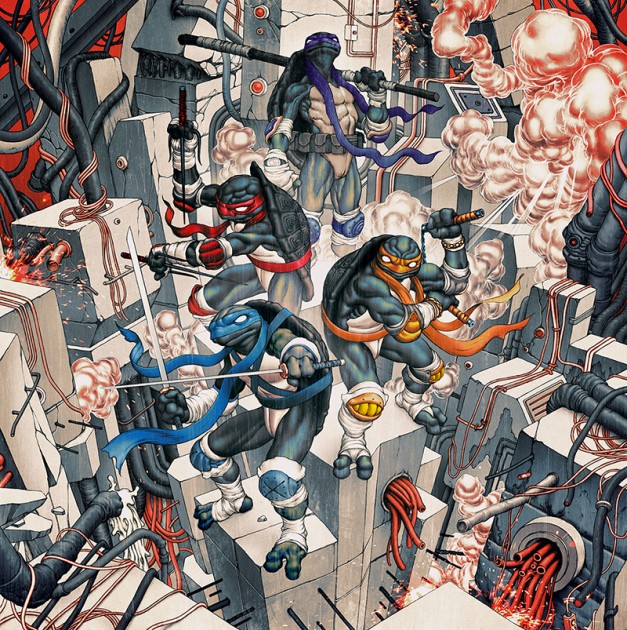
§ Finally, James Jean does the Teenage Mutant Ninja Turtles and you can buy the toys. Nuff said.
Okay… I’m slowly getting back to “normal”. I still have a huge backlog of posts to work on, here’s my con diary, mostly in picture form.
Photos were taken with my Samsung Galaxy S Epic 4G Touch 5MP camera, at high resolution. Which means you see the crapiness in HD!
Tuesday
Yes, I started my “super week” on Tuesday, at Columbia University. You can read and see what I did here.
After the library, many of us ventured across the street to Ollies. Normally, I avoid any eatery with a B grade (21 points! Temperature control, food contamination!), but ate here in the spirit of camaraderie. (Misery loves company!) The food was tasty, and the conversation lively.
Wednesday
I slept well, then headed to Javits. The ICV2 conference was that afternoon, and I had to type up the Columbia report, as well as take pictures of setup. I tried posting them via the WordPress app on my phone, but was stymied.
 A common site to New Yorkers. If you see these, you’ll probably want to avoid the area for the next few ideas.
A common site to New Yorkers. If you see these, you’ll probably want to avoid the area for the next few ideas.
 Later, this will be the exit. You’ll see Starfire in the background.
Later, this will be the exit. You’ll see Starfire in the background.

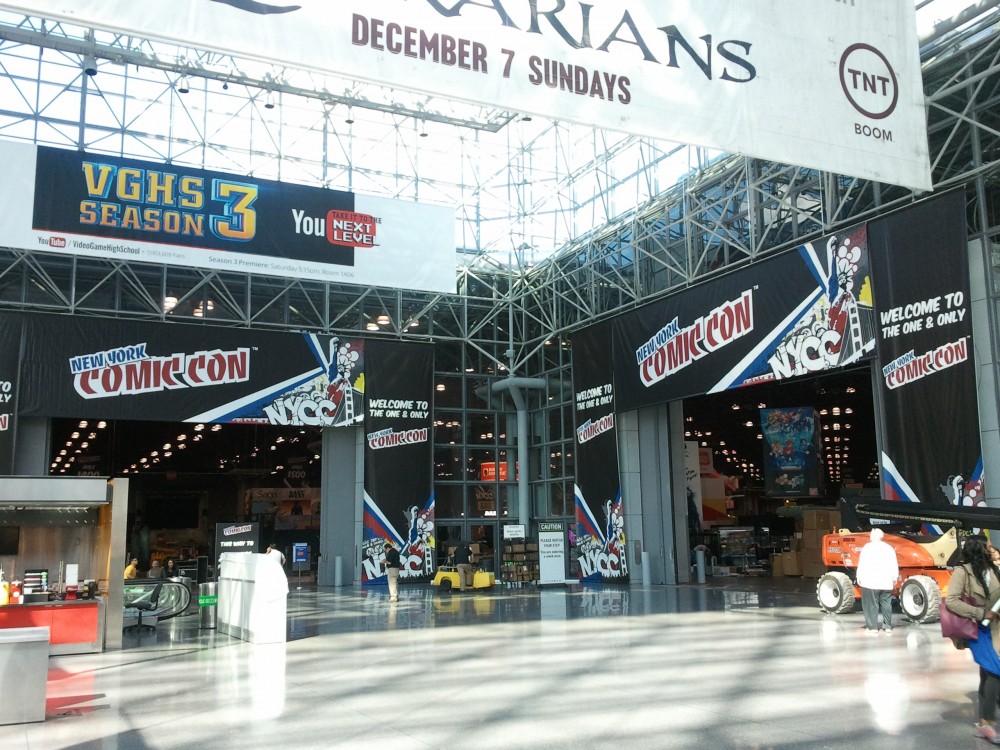

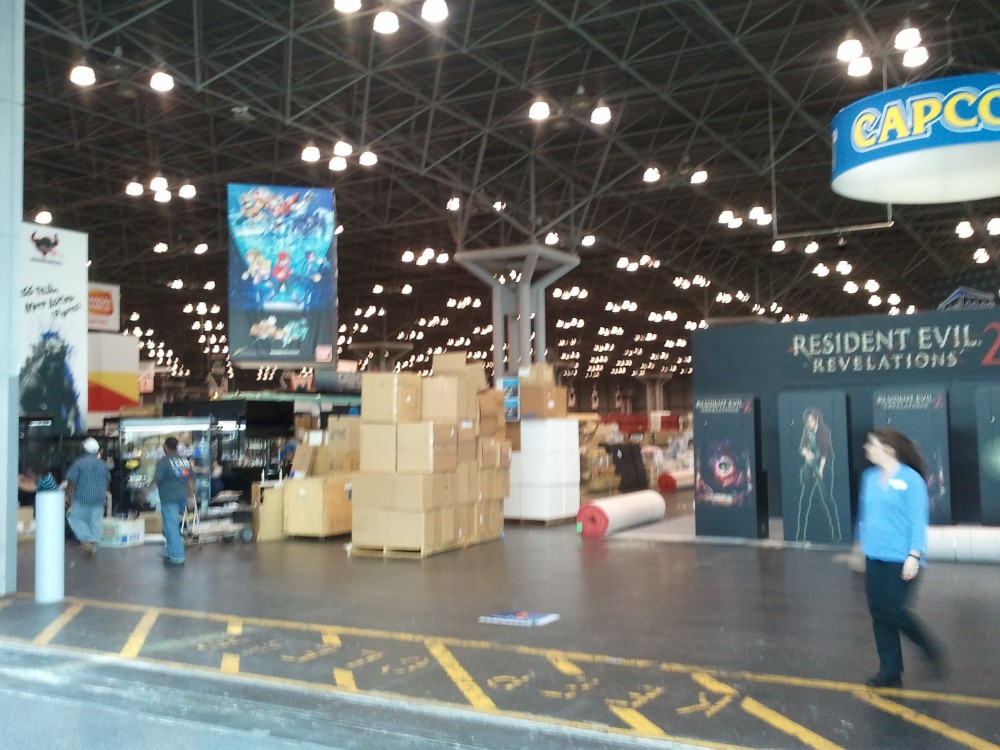

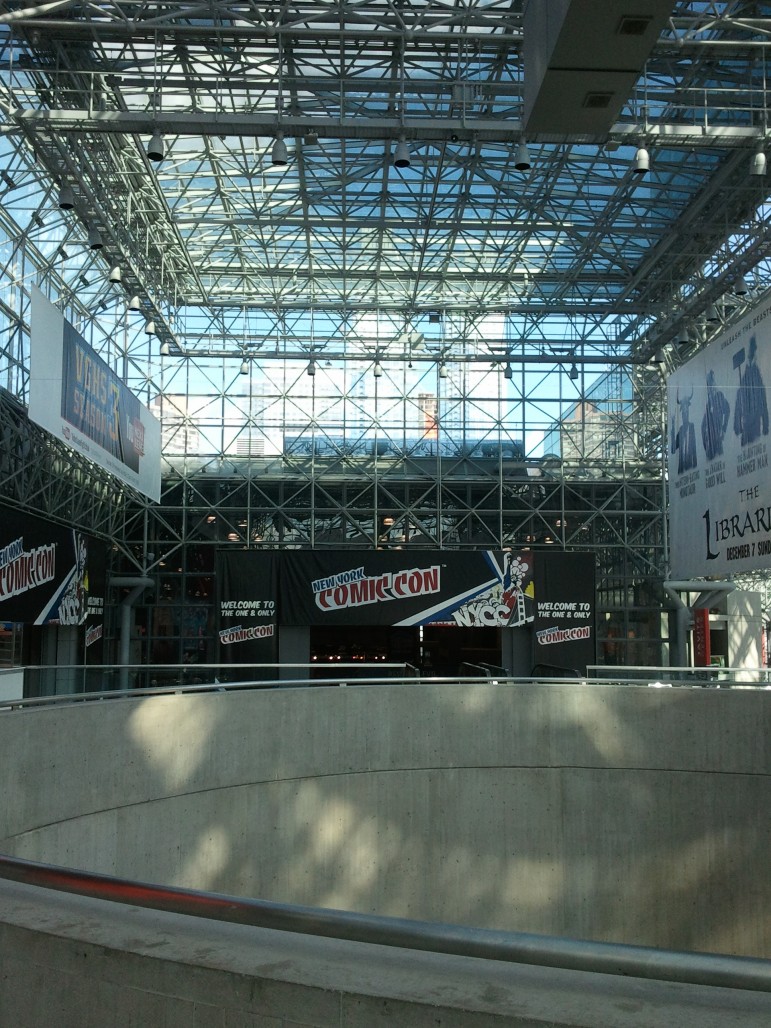
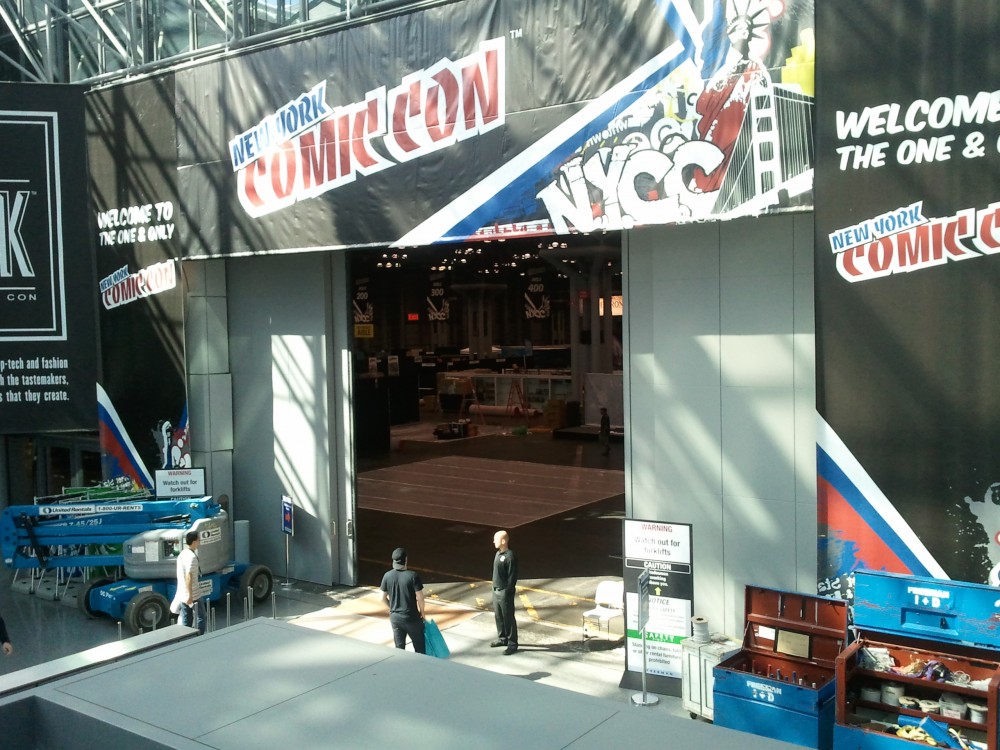

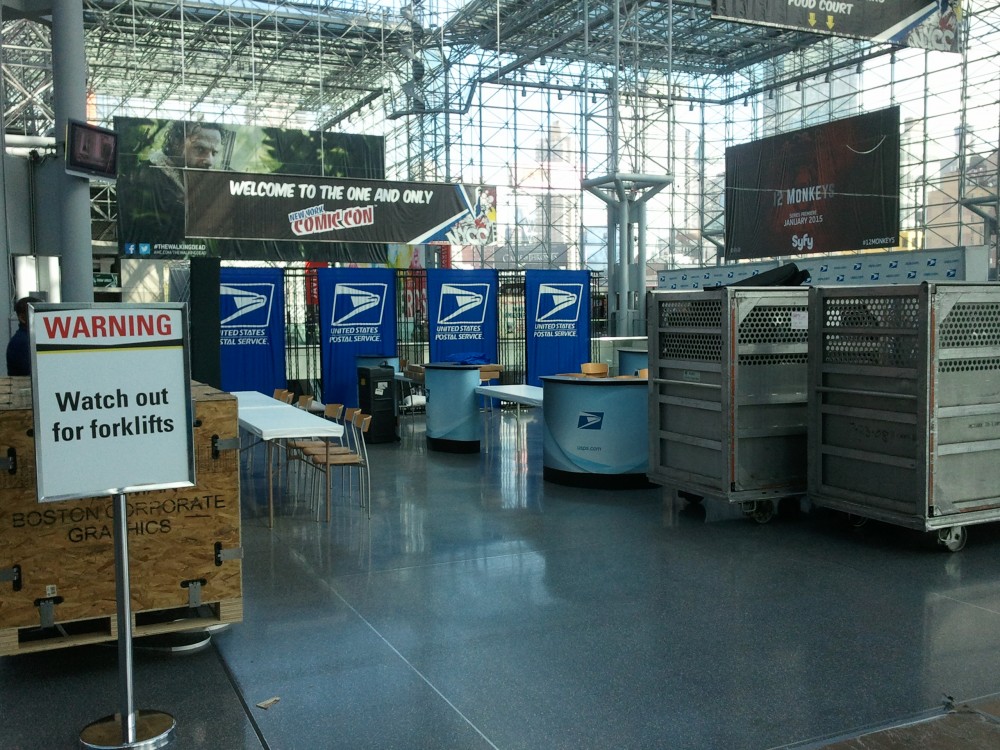 Have you bought your Batman Forever stamps? (No… not THAT “Batman Forever“!)
Have you bought your Batman Forever stamps? (No… not THAT “Batman Forever“!) “In my day, we called it “Nickelodeon”. And when they signed off at 8 PM, we switched over and watched the scrambled Playboy Channel feed.”
“In my day, we called it “Nickelodeon”. And when they signed off at 8 PM, we switched over and watched the scrambled Playboy Channel feed.”
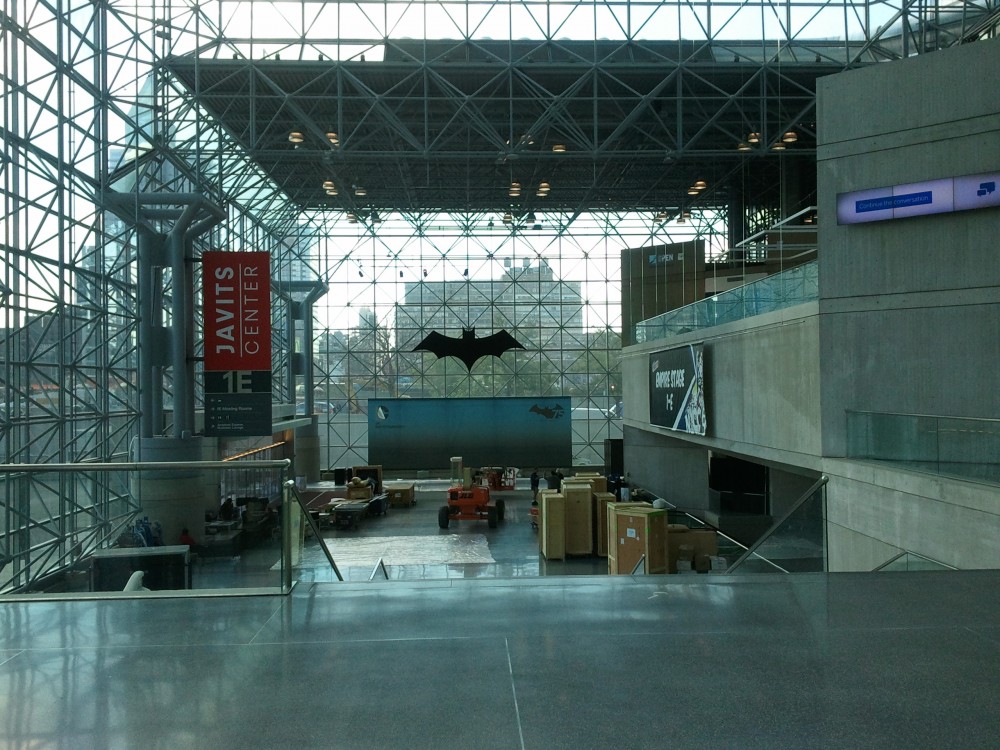 Gotham South.
Gotham South.
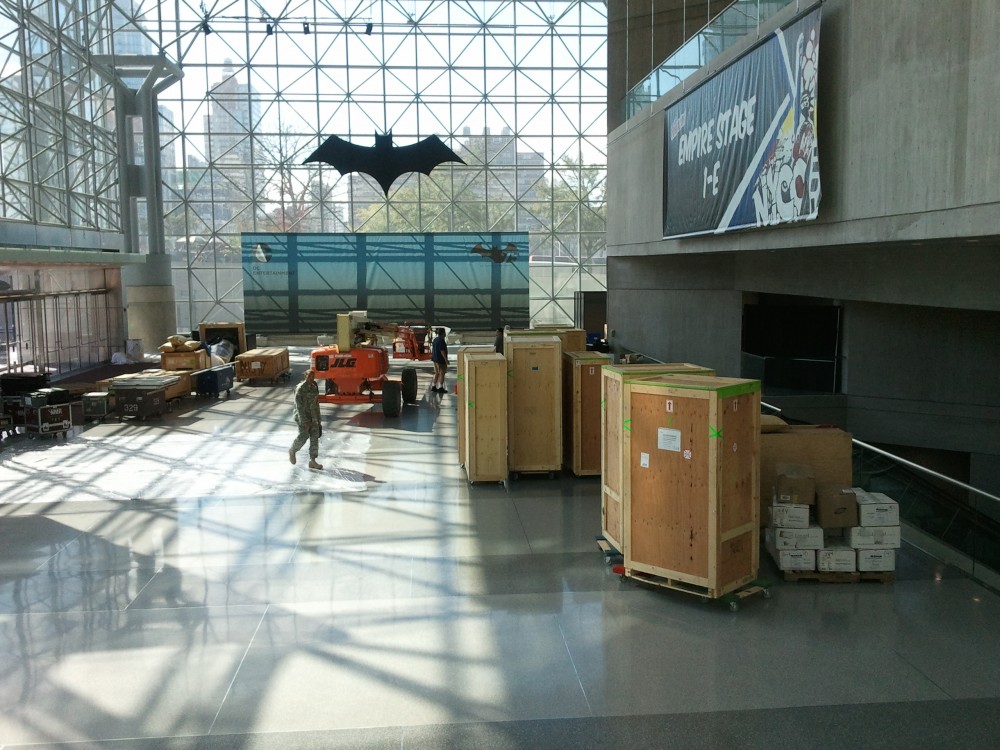
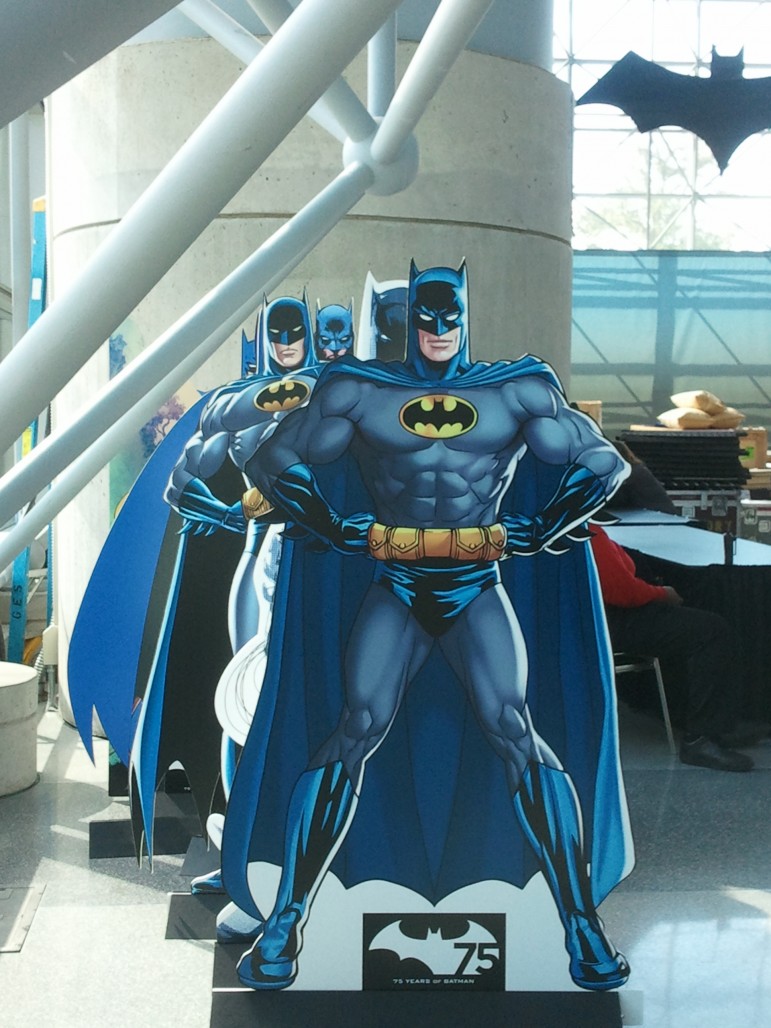 The line for the Empire Stage forms early…
The line for the Empire Stage forms early…
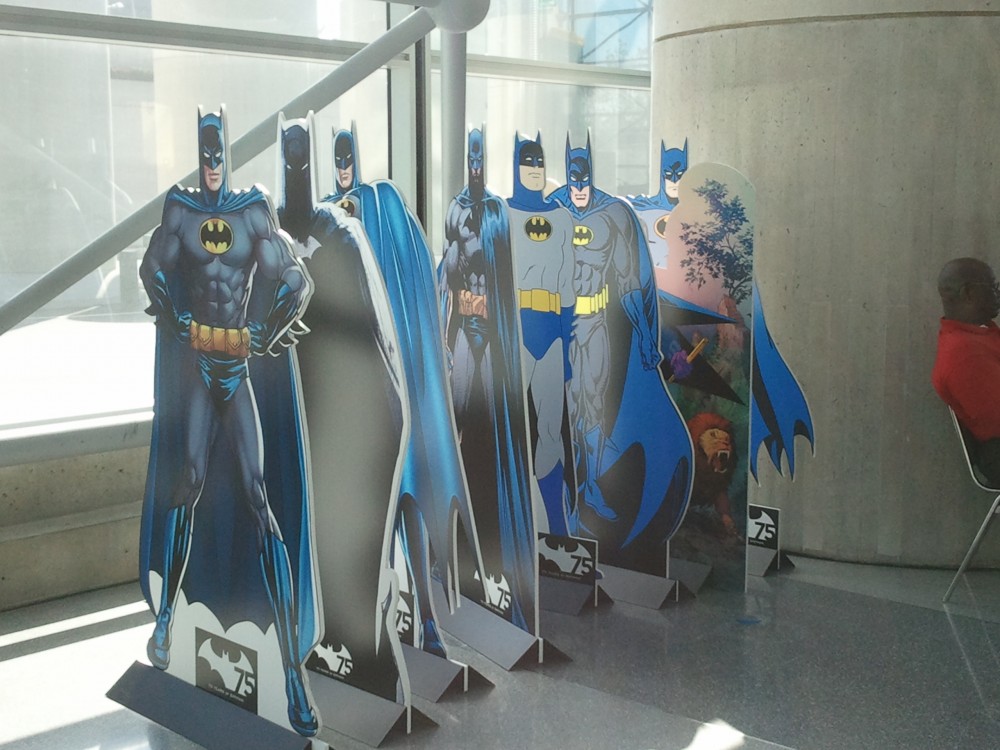

 The view from the second floor, which is one level below Eleventh Avenue.
The view from the second floor, which is one level below Eleventh Avenue.

 The big picture. Note the smaller number of panel rooms in 1A.
The big picture. Note the smaller number of panel rooms in 1A.
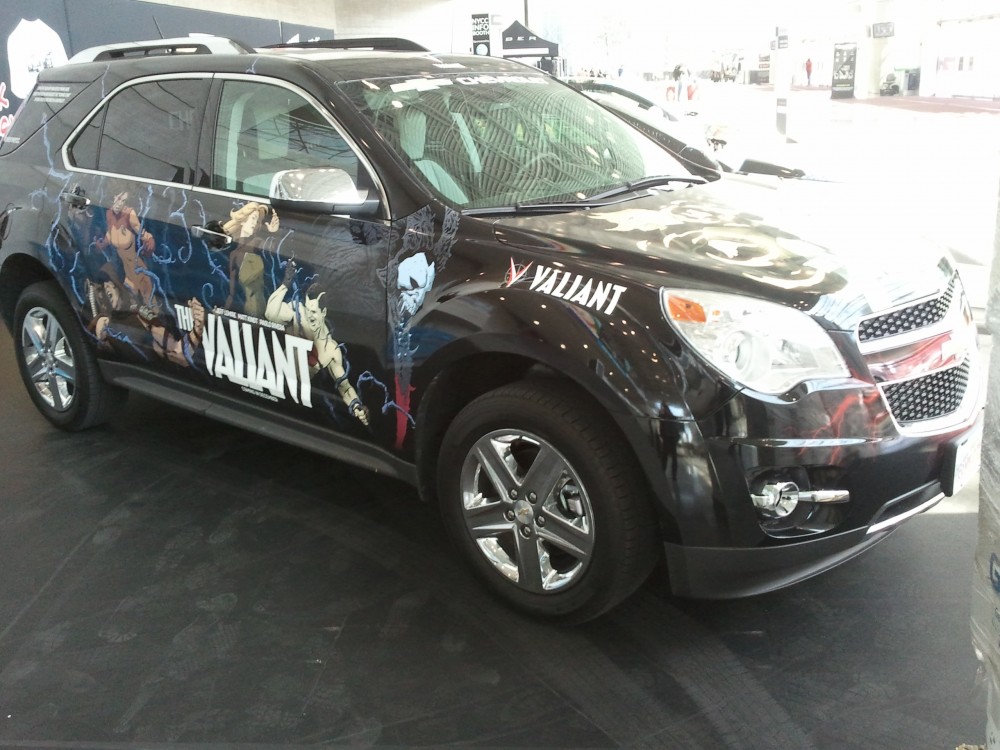
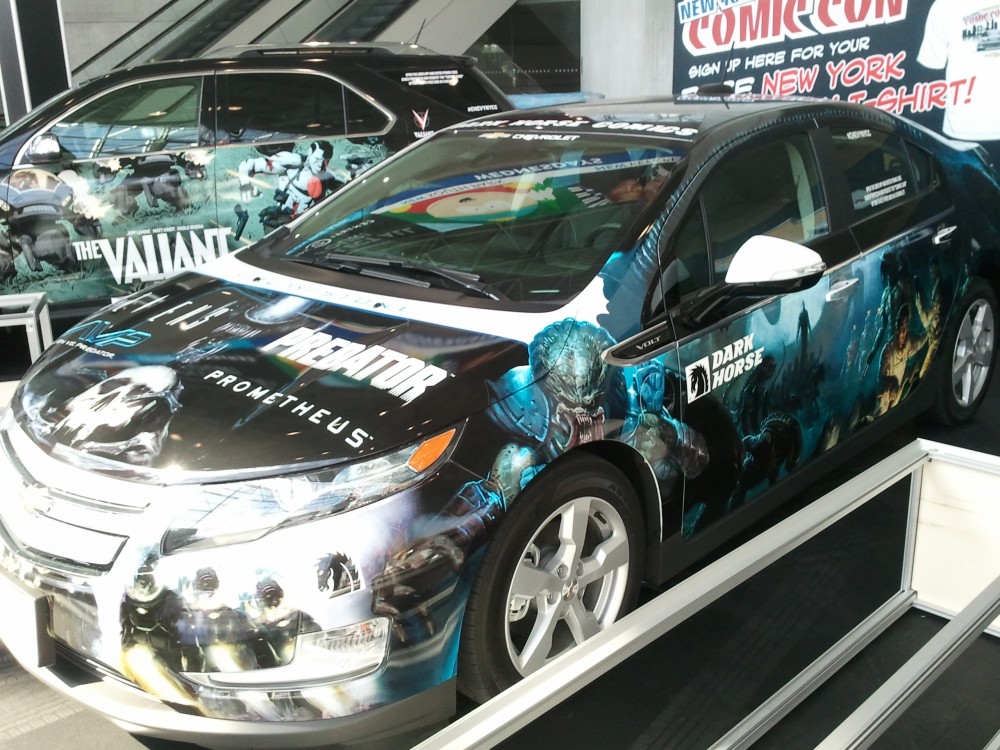
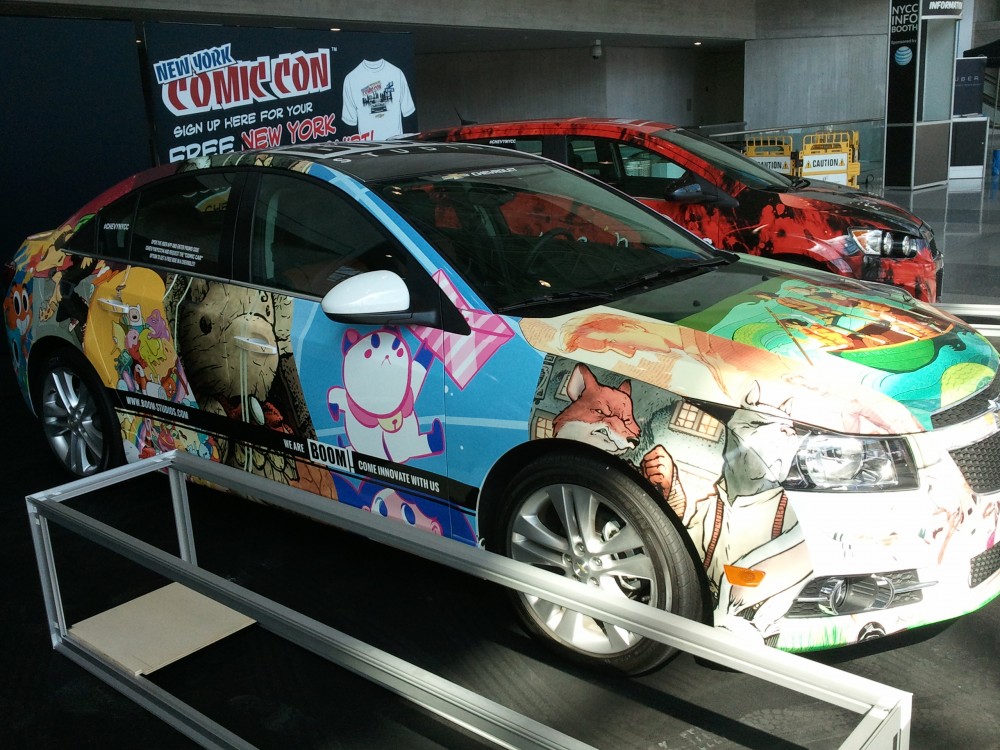
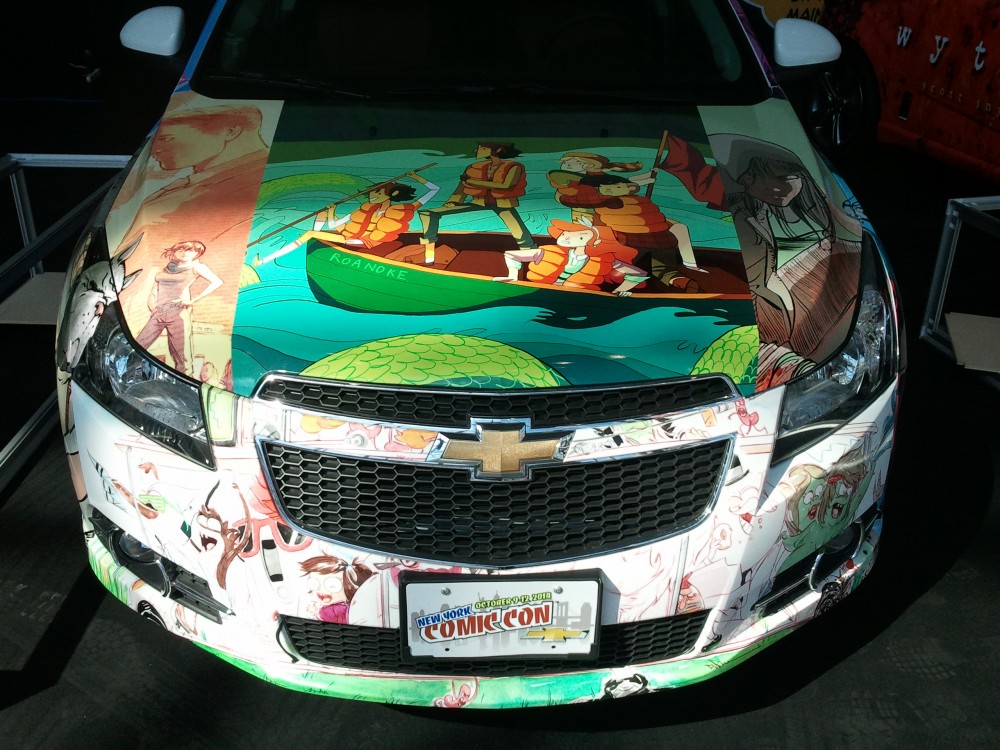
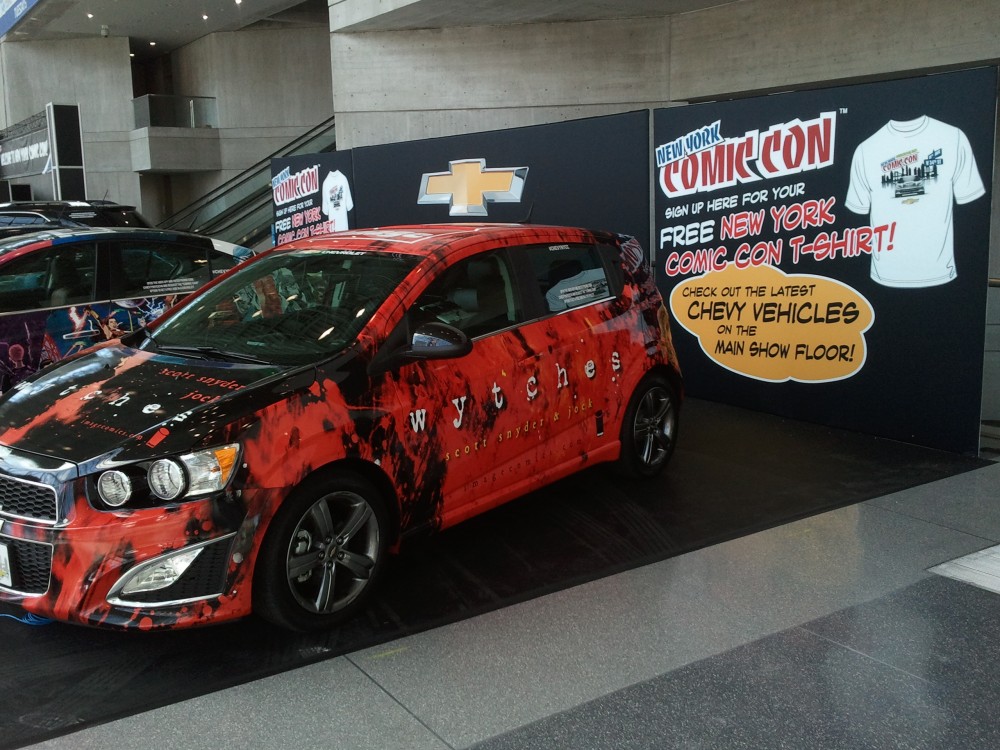
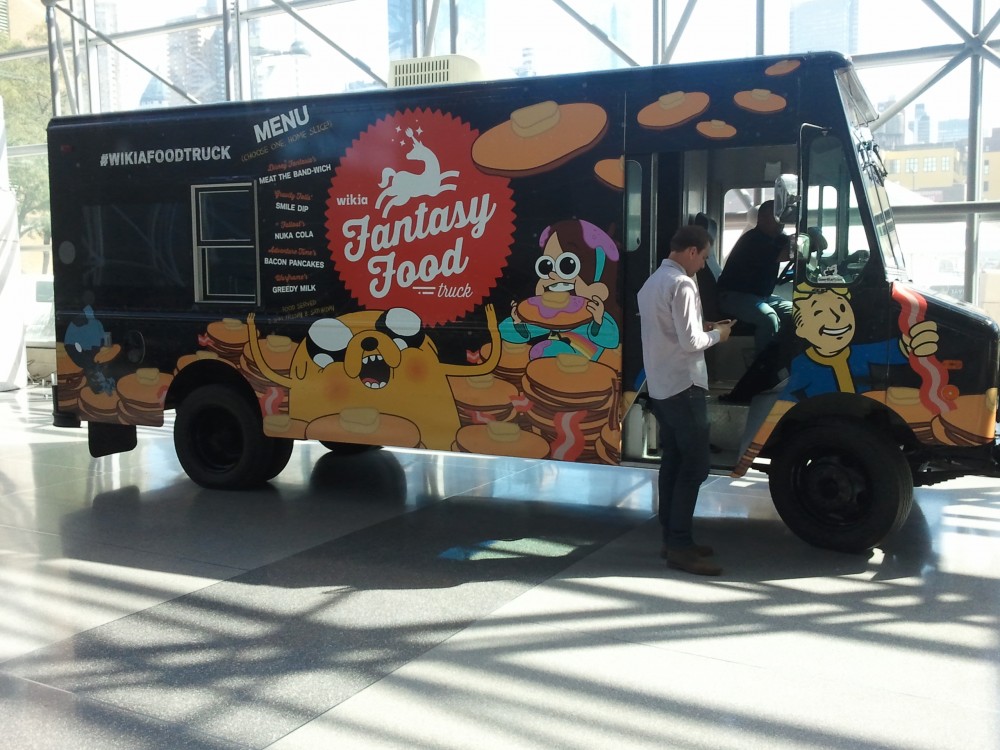 God… I wonder if they got tired of people singing in the Bacon Pancake song?
God… I wonder if they got tired of people singing in the Bacon Pancake song? 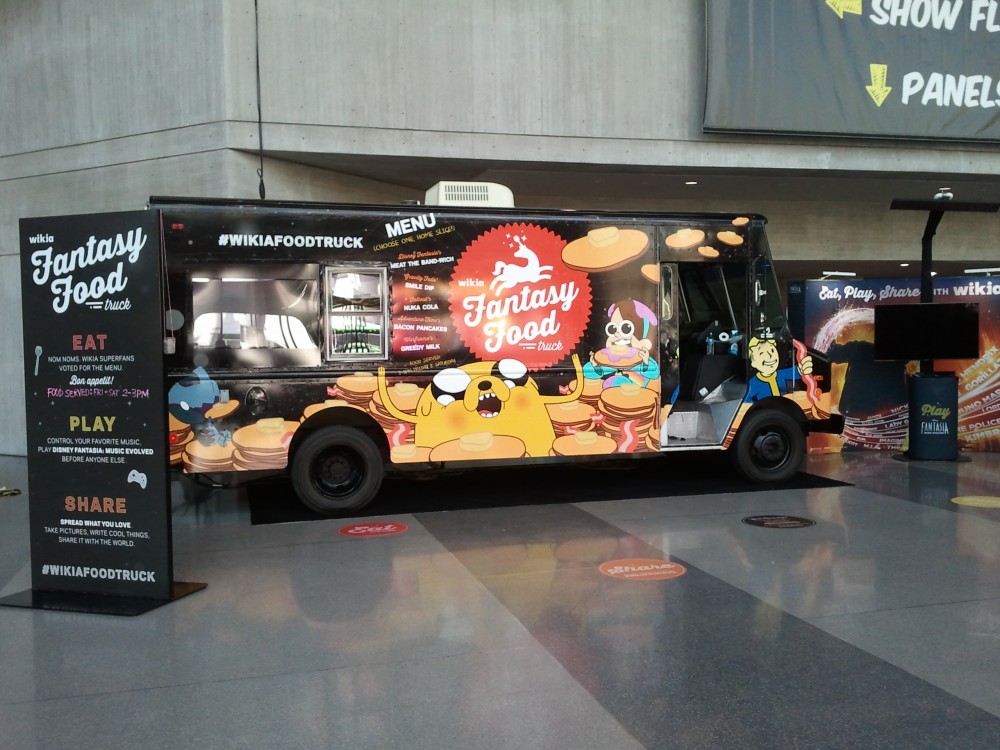 The final parking place. There were more food trucks outside, but I was never that hungry, or that rich.
The final parking place. There were more food trucks outside, but I was never that hungry, or that rich.
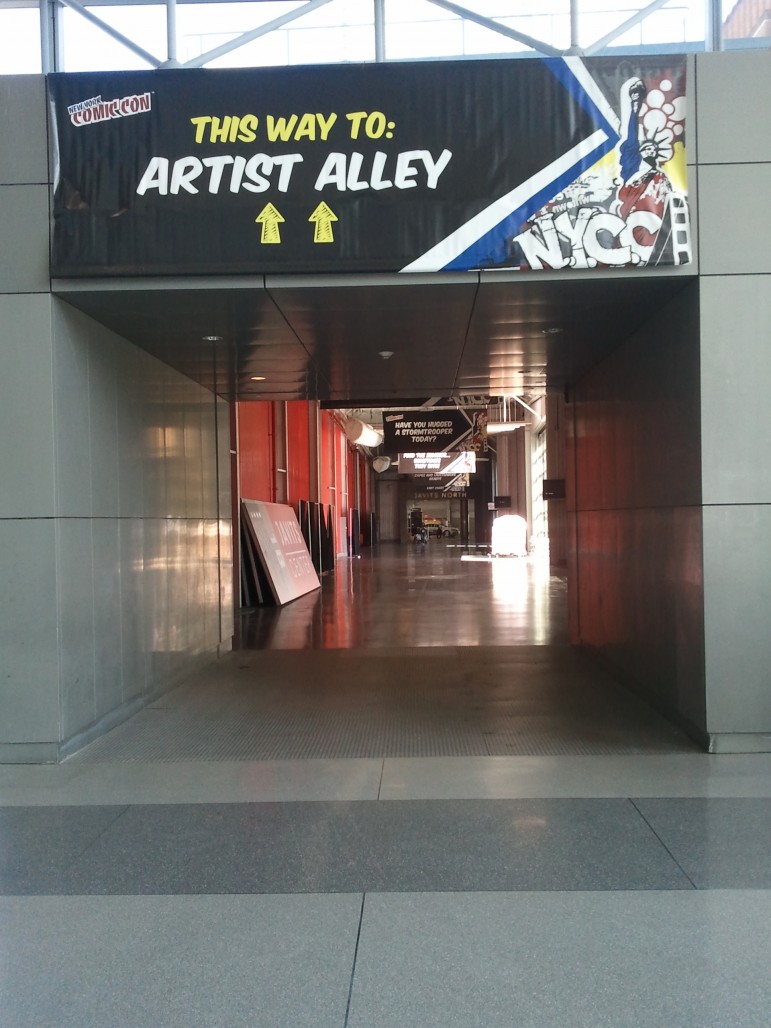
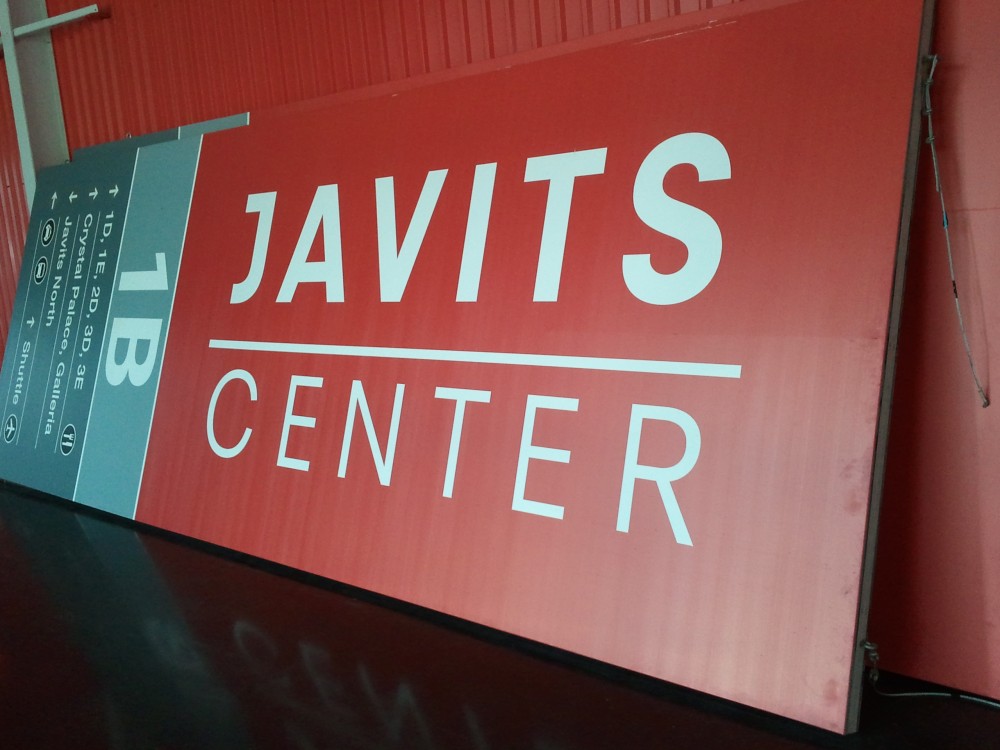
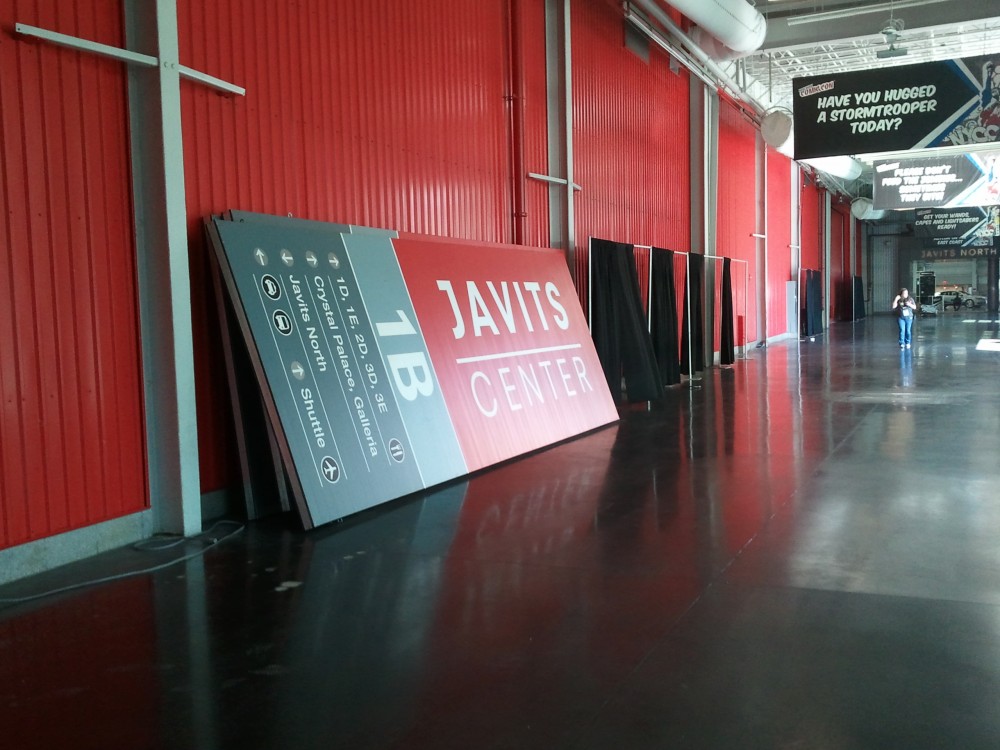 I guess they needed space for banners.
I guess they needed space for banners.
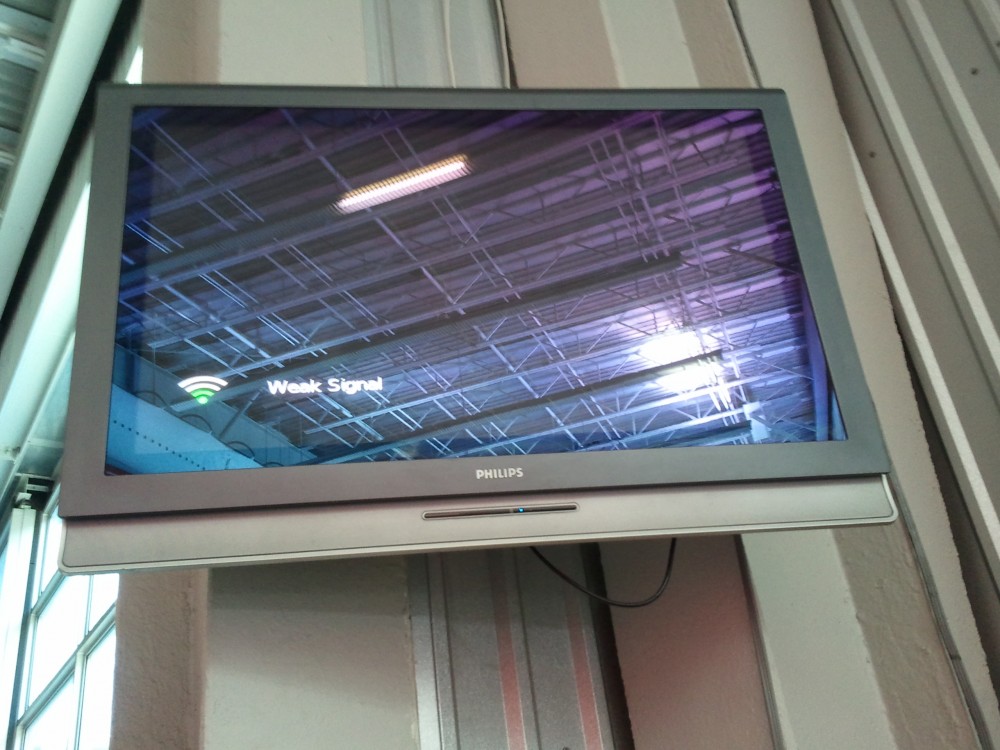 Not a good omen for the convention… If the Javits’ own TV monitors can’t find WiFi…
Not a good omen for the convention… If the Javits’ own TV monitors can’t find WiFi…
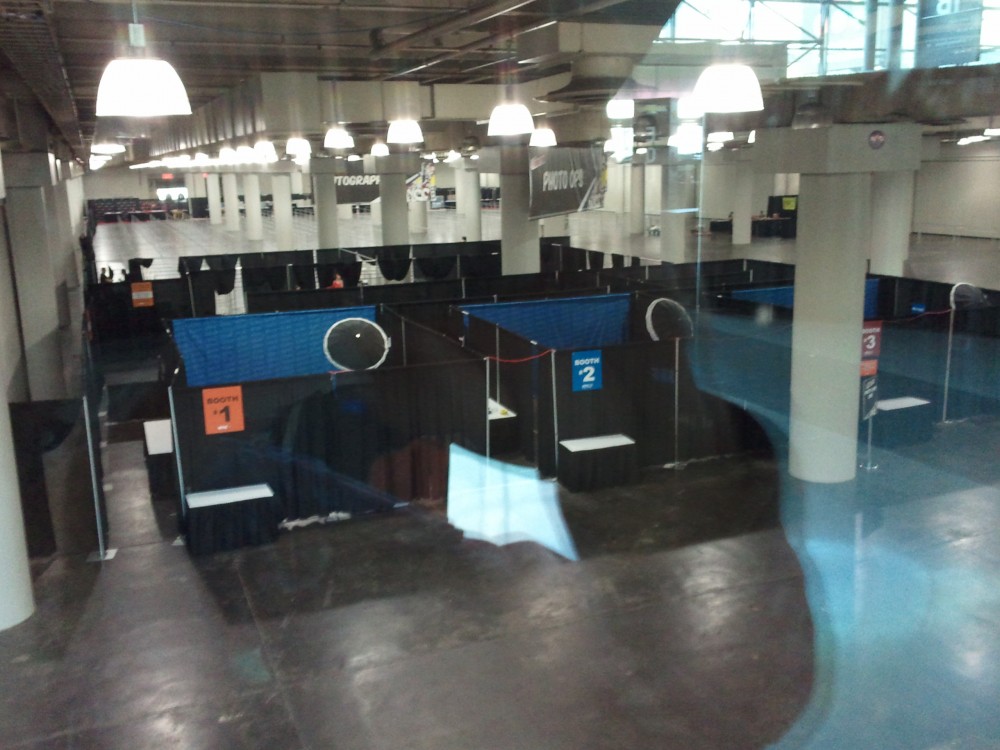 Autographing in Hall 1B.
Autographing in Hall 1B.
 What I call the “Stockyards”. This is the queue hall for events and the show floor every morning.
What I call the “Stockyards”. This is the queue hall for events and the show floor every morning.
The afternoon was spent at the ICV2 conference. But, at around 4PM, my stomach became unsettled, due to the bad Chinese I ate the night before. I hoped to clear my stomach, but something had taken root. I limped to the Abrams Comics Art reception, but had to give my regrets leaving early.
Finally, I awoke at 3 AM, and soon everything was okay.
Thursday
I got up early… Disney was opening the show with the first panel on the Main Stage (Hall 1-D), featuring “Big Hero Six” and “Tomorrowland”.
The lines opened at 10:30 AM (not too late), and it was easy to navigate downstairs to the queue hall. There we all waited in line for panels, and the room was packed by Noon, easily. (My view was a bit blocked, standing a few yards from the head of the line.)
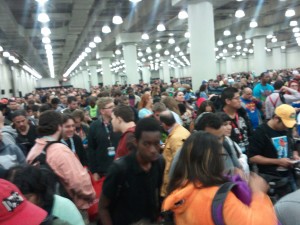 At 12:30, staff began handing out the wristbands, and were adamant about people wearing them. (I was trying to walk and band myself, and the staff made me stop and wristband.) Then we congregated at the big side door leading directly into 1-D. There was a small hiccup between letting the VIPs in before the hoi polloi, but it was all orderly. No running, but I hustled, and got a good seat right next to the microphone.
At 12:30, staff began handing out the wristbands, and were adamant about people wearing them. (I was trying to walk and band myself, and the staff made me stop and wristband.) Then we congregated at the big side door leading directly into 1-D. There was a small hiccup between letting the VIPs in before the hoi polloi, but it was all orderly. No running, but I hustled, and got a good seat right next to the microphone.
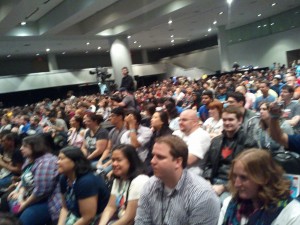
The crowd. There was an empty seat between me and a reporter from the Wall Street Journal. (We split the unclaimed swag. He took the print, I took the bag with the promo and button.)
 While we’re waiting, there was a DJ and comedian keeping us all entertained. They both did a great job, but it was early… dunno what they were feeling on Sunday!
While we’re waiting, there was a DJ and comedian keeping us all entertained. They both did a great job, but it was early… dunno what they were feeling on Sunday!
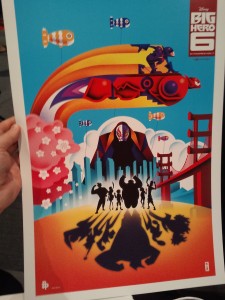
I made sure to sit right. next. to. the microphone. I wanted to ask Brad Bird (director of Tomorrowland) what advice Edna Mode had for cosplayers. Sadly (although it actually made for a better panel), there were no questions.
But right across the aisle… was the VIP section. I was forward enough that most of those seated were Disney execs. Guess who was sitting DIRECTLY across from me? Nobody very important… just Marvel’s Chief Creative Officer. “I don’t want to blow your cover,” I said, “but here’s my card.”
Once the festivities began, he was spotlighted along with one of the creators of Big Hero Six. Disney showed a lot of clips, including an amazing chase scene! They said Scott Adsit (Baymax) has made comics? (He is an agent of SHIELD in Marvel Comics.)
(And yes, even the Disney execs are subject to the “no cell phone” policy. One of the security agents was engaged in multiple conversations with one female exec. It seemed to have been politely settled.)
Then they brought out the Tomorrowland cast. Not much shown, as the aura of mystery was maintained.
The highlight, of course, was when George Clooney appeared. This was his first ever Comic Con event, joking that he was blacklisted for his version of Batman. He is EXTREMELY charming! He even talked his bosses into screening a clip from the movie, where Casey Newton meets Frank Walker, and everything goes helter-skelter.
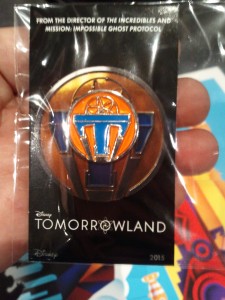
Leave it to Disney to feature pin trading in the new movie! (It is the inciting incident.)
Go see both. Big Hero Six is great animation, and Tomorrowland will feature big scenes and big ideas.

What’s this? Well, I wandered the middle of the show floor (“Times Squre”) where the huge booths were located, hoping to avoid them the rest of the show. This is a scale model of a Marvel’s new 4D virtual event which will travel across the country. More information here. By sheer coincidence, Mr. Quesada was just finishing up a presentation at the Marvel booth as I was taking this photo.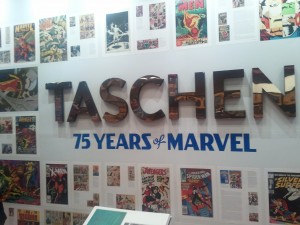
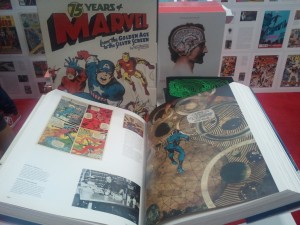
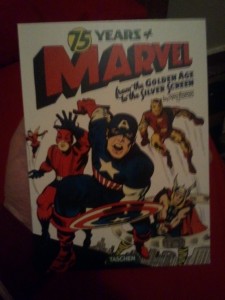
Remember that back-breaking DC book from a few years ago? This is the Marvel version, penned by Roy Thomas!
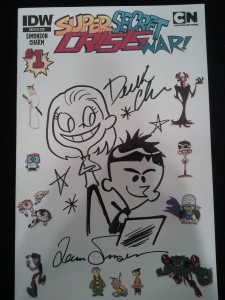 I try to get at least one sketch comic per show. Unlike most, I collect self-portraits of the cartoonists! I love this series, and it’s always a pleasure meeting Louise Simonson! Derek Charm then did the sketch, and Weezie immediately took a pic to spread far and wide!
I try to get at least one sketch comic per show. Unlike most, I collect self-portraits of the cartoonists! I love this series, and it’s always a pleasure meeting Louise Simonson! Derek Charm then did the sketch, and Weezie immediately took a pic to spread far and wide!

My co-worker is a hardcover Peanuts collector, and loves the holidays. I had promised her I would stop by the Hallmark booth to see if there were any reveals of new Peanuts ornaments, but everything was already revealed. While there, I got to chatting with one of Hallmark’s designers, Aden Chung, who was waiting for his event. He created the itty bittys plushies for Hallmark, which are quite adorable! His background was in animation, but worked previously on the greeting cards.
Yes, kids, you can be Batman! Just be sure to schedule a family night in the bad part of town! Too much trouble? There’s a Batgirl version as well. That one only requires your parents to get divorced. (I kid. I’ll be getting one for my niece.)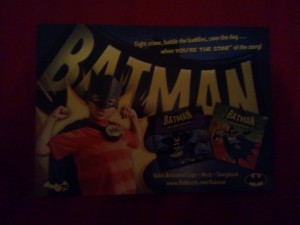
Over at Image, Kyle Higgins was signing the Con exclusive hardcover, so I bought a copy. I also bought the GSKFBS treasury, but didn’t realize that Eric Larsen was in artists alley, and I wasn’t going to lug it back the next day…
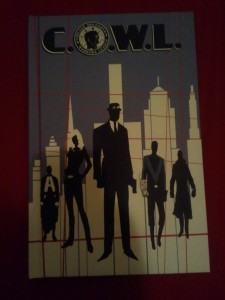

Rebellion/2000 AD is always a pleasure to talk with, and they had this little-known hardcover on sale. The U.S. edition will pub soon.
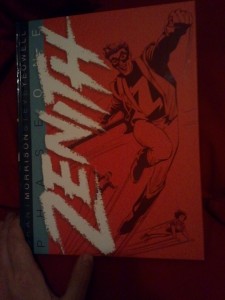
Random House hosted numerous signings during the weekend, and I did not have too long to wait. He wasn’t sketching, but did doodle a mushroom inside.
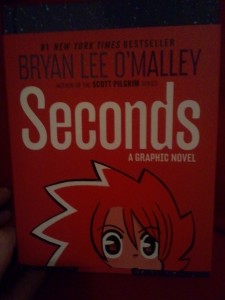 An actual print comic from Madefire. They were quite hospitable, inviting me to sit down and sample the reading app, which is quite robust! They also gave me a bottle of water, which was much appreciated!
An actual print comic from Madefire. They were quite hospitable, inviting me to sit down and sample the reading app, which is quite robust! They also gave me a bottle of water, which was much appreciated!

Not an actual comic book, but quite clever! I wonder if there’s a page that you can only access by cheating?
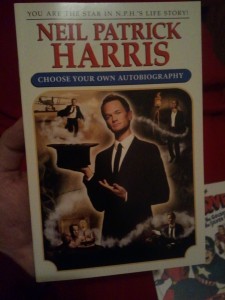
A bio-manga from Vertical!
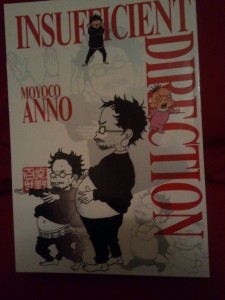
And the scene outside as the show floor closed, and I began shambling home.
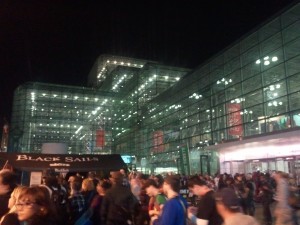
Friday
Got there bright and early, to cover the Marvel retailer panel.
After that, Abrams hosted a panel of their upcoming titles. The panelists:
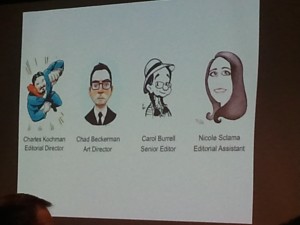 They brought up each creator one-by-one to talk about their books. All are amazing in different ways! (Finnish heavy metal band with a bear on drums. Simon and Kirby original art. El Deafo. The Kennedy Assassination. Squirrel Scout cookies.)
They brought up each creator one-by-one to talk about their books. All are amazing in different ways! (Finnish heavy metal band with a bear on drums. Simon and Kirby original art. El Deafo. The Kennedy Assassination. Squirrel Scout cookies.)
The final teaser:
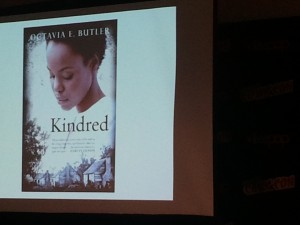
Yeah… they’re evil.
I then spent the rest of the day in Artist Alley, and got all but one aisle done!
A nice discovery, from Archaia.
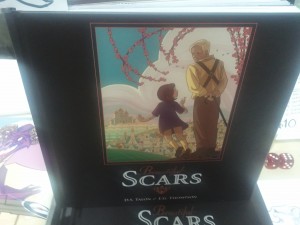
Clever cosplay! Jay P. Fosgitt signed and sketched himself, while Bodie Troll and Cholly keep himcompany.
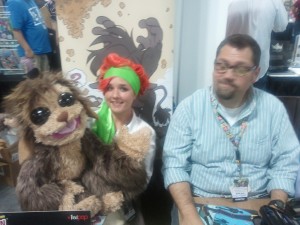
Ah… the Fillbach Brothers were there! Part of the ex-pat cornhusker comics confederation, they showed me a few sneak peaks of new stuff from First Comics! It’s modern western, with crazy stuff happening every other page! (See that cute little guy on the cover? You won’t believe his origin!) They’re loads of fun!
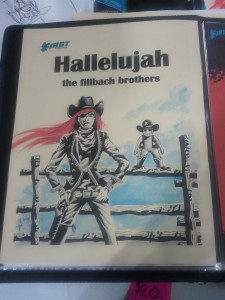
By sheer zen coincidence, I ran into them again on the way out, and after buying some medicine to combat con crud the next day, we went over to Beer Authority, where the staff were cosplaying in conjunction with Comic Con. I had two glasses before making my escape. If you enjoy beer, I recommend it; approximately twenty beers on tap. That Brooklyn Defender burger sounds pretty interesting…
Saturday
The plan: surf the outside aisles of the show floor, checking out the retailers and smaller vendors.
For example, the National Cartoonist Society, which was offering a cool t-shirt featuring caricatures of Batman done by various cartoonists!
 The Concourse, at approximately 2 PM. Yes, it was crowded, but I easily navigated this mass of humanity on the way to Artists Alley. Same on the show floor… a few pauses, but not too difficult to move around.
The Concourse, at approximately 2 PM. Yes, it was crowded, but I easily navigated this mass of humanity on the way to Artists Alley. Same on the show floor… a few pauses, but not too difficult to move around.
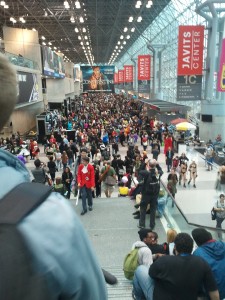
Bought some cool stuff, including original art. Made a few notes for my lottery list.
And on the way out that night…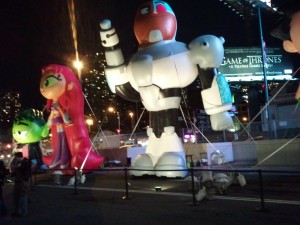
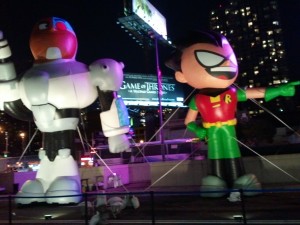
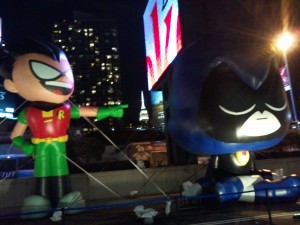
 Another panoramic:
Another panoramic:
Sunday
Nothing on the schedule, except some autographs, and trying to see anything I didn’t see the other three days!
Interesting flavored cookies, with a comic book inside!
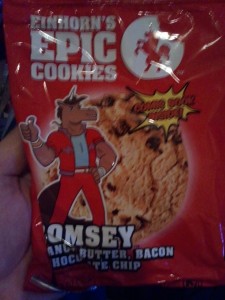
The exit.
 The view from the fourth floor cafe.
The view from the fourth floor cafe.
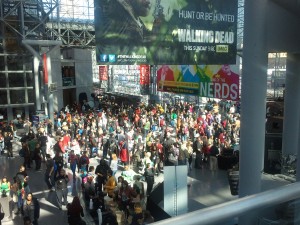 The view from the Galleria. The VIP staff were gracious in allowing me to photograph from the suite. They even asked me if I wanted in on the order of Chinese food they were organizing. I demured.
The view from the Galleria. The VIP staff were gracious in allowing me to photograph from the suite. They even asked me if I wanted in on the order of Chinese food they were organizing. I demured.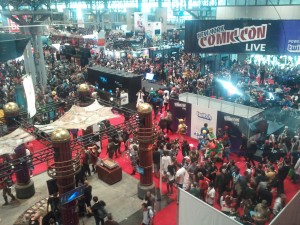

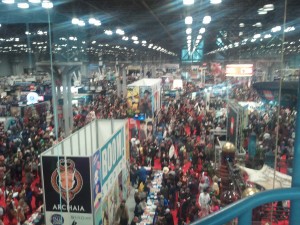
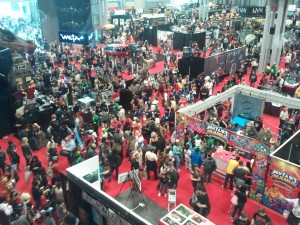
 Exiting the Galleria, I liked how the entrance framed the naked torso of American Dad!
Exiting the Galleria, I liked how the entrance framed the naked torso of American Dad! 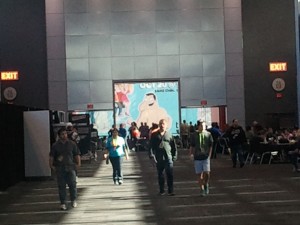
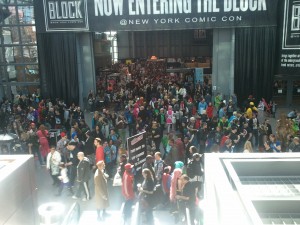
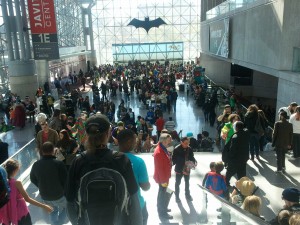 A Marx keychain from Fred Van Lente!
A Marx keychain from Fred Van Lente! 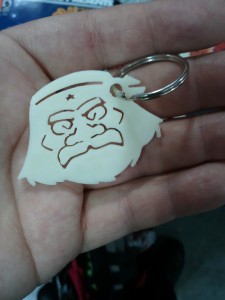 This was brilliant… Neal Adams bought four booths, and built a table fort! There was a small foyer right in front of him for people to line up, otherwise, everything else was on display!
This was brilliant… Neal Adams bought four booths, and built a table fort! There was a small foyer right in front of him for people to line up, otherwise, everything else was on display! 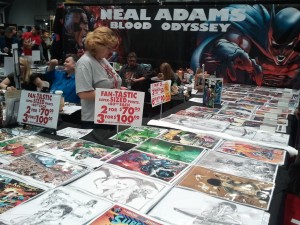
Picked up stuff in artists alley (including two “Big Book” pieces from Gary Fields), then witnessed the Q&A panel. I filed it from the FedEx Office shop, and by the time I left, Javits was as empty as it was on Wednesday. I wasn’t able to get any good photos of the teardown, but came across this on the way to the subway:
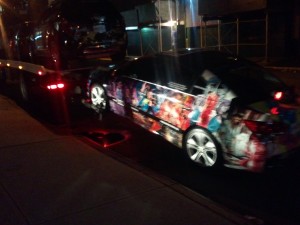 Those are all the Chevy’s that were on display.
Those are all the Chevy’s that were on display.
In a bit of synchronicity, just a block away:
 Five and a half days of Comics! I ended up spending my paycheck at Javits, although everything cost less than $100.
Five and a half days of Comics! I ended up spending my paycheck at Javits, although everything cost less than $100.
It was an enjoyable show. Not much stress (after the food poisoning), met lots of interesting people, and never felt wiped out at the end of the day. (I even WALKED back to the subway each night!) Next year: the TENTH show!
New York Comic Con is evolving nicely. I’m still hoping for this…

While the harassment problems seems to have been put under control, by and large, there are a rather alarming number of reports of theft from the show, including this one, about a hand painted “Dunny” statue worth $2000 being stolen from a booth. The culprit was caught on tape taking the items at 7:25 after the show closed and fled on foot.
Nick Curtis, an associate editor at the magazine, said the 20-inch, high-priced action figure had been hand-painted by artist Jon-Paul Kaiser during the event.
“What had been done is that an artist did a live painting of it during Comic Con, making it essentially a one-of-a-kind piece of art on a 3-D canvas,” he said.
The bunny-like figurines are typically 3-inches tall, mass-produced and retail for $15, Curtis said.
The thief also stole a Popaganda “TDY” figure worth $80 and a Goodley Toy action figure worth $100, police said.
I also saw tweets indicating that writer Amy Chu’s laptop was stolen, and there’s a report of an artist having some pages stolen as well.
Thievery doesn’t invite the same kind of “they were asking for it” response as other kinds of claims, but unfortunately, these incidents are a reminder that leaving valuable things lying around is not a good idea at a crowded con. It’s also a sad comment on an otherwise peaceful crowd.
I know of one creator who had his laptop stolen right off his table at a foreign show. (I also know of several people who had wallets stolen at comic book after partys over the years—enough so that I’d rather stand around with 20lbs of equipment on my shoulder than leave them unattended.) While these kind of thefts are not uncommon everywhere, there do seem to have been several at this year’s NYCC.
Anyway, keep an eye on valuables!
by Zachary Clemente
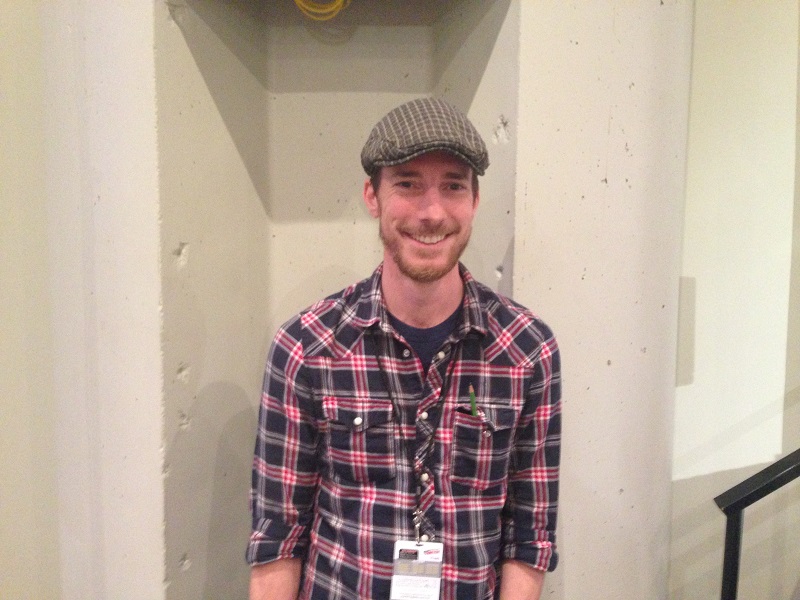
In the incredibly crowded Artist Alley of New York Comic-Con, I sat down with illustrator Wes Craig to talk about his work on Blackhand Comics and Deadly Class, both published in print by Image Comics. His work exhibits some of the most exciting paneling structures and dynamic representation of motion, at least to me. I’m pleased to say that our conversation was halted many times as eager attendees came up get copies of Deadly Class signed, buy a copy of Blackhand, or just share a few words. Craig was worked on Guardians of the Galaxy, Judge Dredd, T.H.U.N.D.E.R. Agents, Batman Annual, and many more.
Comics Beat: Like many, I first found your work in Deadly Class, then started look at Blackhand [Comics]. I found your panel structure and your ability to move the reader’s eye dynamic and fluid, even when panels doesn’t necessarily exist. How does your process begin and how does that looser form start taking place?
Wes Craig: For years in my sketchbook, I’ve been trying to think of different ways of presenting a page as something you maybe haven’t seen before. Deadly Class was kind of my first opportunity to do that for other people to see. I did a bit of it in Blackhand and my previous work for myself that no one really ever saw, but Deadly Class was the first public version of that.
I take what Rick [Remender] has in the script and I try to figure out what the scene is about. A lot of have people have brought up the first issue – it’s really just a flat-out chase scene. I know that you can’t present motion in comics and that’s a problem with comics: you can’t do music or motion – but I try to make the page dynamic and make it feel like it’s kind of moving. So, I go back to my sketchbooks to come up with as many ideas as I can like breaking the borders or having characters fall into the next panel, and all that kind of stuff helps with that feeling.
CB: With Blackhand, I didn’t realize how it was going to be published in print. It being an object with a horizontal format is exciting.
WC: Those started off as webcomics and I wasn’t sure at first if I was ever going to publish them – that’s why it’s kind of formatted like a computer screen. It makes for an interesting looking thing and not may books have those dimensions. It stands out in a stack of other comics.

Blackhand Comics – The Seed
CB: The three stories in Blackhand all exhibit very different paneling styles each a discussion on three different types of stories. When did you working on Blackhand?
WC: It started around the same time as Deadly Class, I forget exactly. I think I started it just before Rick initially emailed me to work on Deadly Class, so it’s been going on for a while. It just takes a while to get it done, obviously. I do it in between issues; there’s usually a little gap between when I finish an issue of Deadly Class and when the next script comes in. I’ll try to get in as many pages as a I can, sometimes on weekends or whatever. Most of my days are spent on Deadly Class so it’s kind of a slow process, but I still managed to release three stories in this book. I have two new stories online, and I’m working on the thumbnails of the third story. That’ll all hopefully be Blackhand Book 2, maybe next year or something.
CB: Will that be through Image as well?
WC: Yeah, I think this’ll [Blackhand Comics] do well enough that it’ll be good for everyone involved – they seem to be totally up for it.
CB: It does appear to be flying off your table.
WC: I actually had to go back to the Image booth to get more from them. They have so many books there, that this can get lost in the shuffle for them but for people specifically coming to see me, it’s right there. [Gestures to the sole remaining copy on his table]
CB: I couldn’t find a lot about your earlier career, what was the path you took?
WC: I’ve been working professionally for a little bit over 10 years–I keep saying that, but I’ve been saying it for two years now. So 12 years or whatever it may be, but it’s always been an issue of this here, an issue of that there. [I had] a little run on some Wildstorm stuff back in the day, a little run of Guardians of the Galaxy – so I’ve never been known as the guy who does that one thing. This convention’s a very different experience for me now because I’m the guy drawing Deadly Class so I have a constant stream of people that are into it here to see me.
The initial thing with Rick started when I did an issue with Lee [Loughridge] [for DC] – I’m a big fan of his work in Deadly Class and his work in general. I kept on bugging DC with working with with Lee, thinking we’d match up well together; it took a while to convince them, but when we finally got the chance with the Legends of the Dark Knight digital comic. [...] I think Rick used to live down the street from Lee and they’d get together, drink beers, and shoot the shit and when Lee was working on one of the Batman pages, Rick leaned over asking “who’s this guy?” It was pure coincidence – I’m a big Rick Remender fan and I’m a big fan of the artists he chooses to work with; I was flattered that he gave me the shot. We get along well now and it’s kind of the perfect situation.
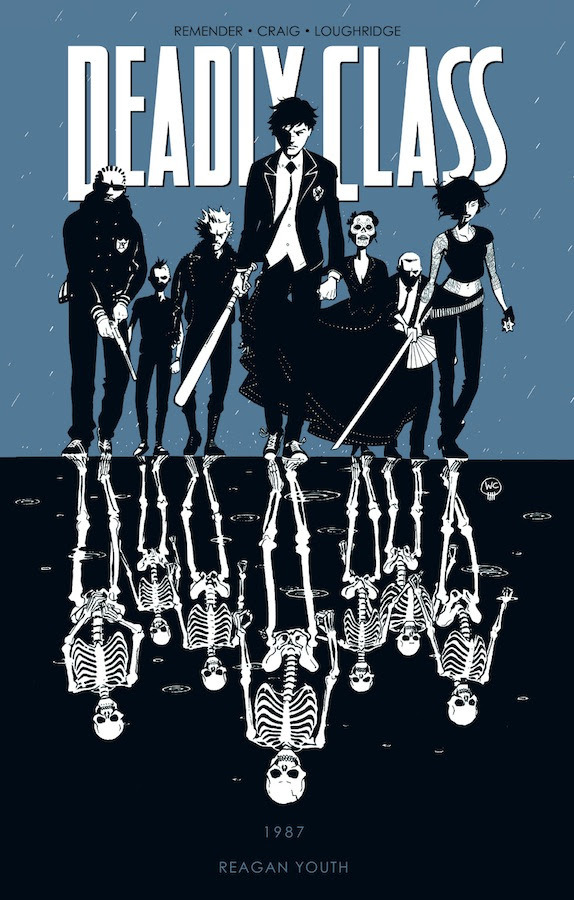
Volume 1 Cover
CB: It looks like you never really had any ownership in your previously published work. How is it having way more of an input within a full story?
WC: It’s great, man. You just feel more invested in it – all that experimental page composition stuff was always in the back of my mind, but I never tried it in the Marvel or DC stuff. People seem to love it and I wonder why I didn’t start doing it earlier, but you just don’t feel the same way. [...] You’re not sure you want to give them your best stuff because once you give them that, they own it. You don’t see as many characters being created for those companies anymore. If they have a great character, they’re going to do it themselves. Once I started Deadly Class, I felt more free to stretch out.
CB: What kind of input do you have on how the story of Deadly Class forms?
WC: That’s part of–not just being co-owners–but being invested. [...] He’ll do the plot, but we’ll talk out ideas a lot, informing what will become the next issues and we’ll talk out where we want to go with it. I feel like the other books that he’s working on are more structured in terms of where they’re gonna go, but with this one we don’t know for sure where we’re gonna end up; we wanted to be a bit more free with it. So he’ll call me up, we’ll talk through ideas figuring out what’s the most interesting way to go with it, he’ll write the script, then call me up again. I think his thing is that he likes to talk it out a few times with not just me until it’s really fully figured out in his mind; he can tell by our reactions what’s working and what’s not.
It’s weird working with him, actually. When I write my own stuff for Blackhand, I’m much more structured, deliberate, and I take my time whereas he’ll give me a scene and if it’s not working right he’ll want to fix it up, asking me what I want to do and I’ll have to be on my toes and come up with something on the spot. It’s not what I’m used to but it stretches a different muscle, spitting out ideas until you find something that works – it’s pretty collaborative.
CB: I feel that’s something we’re seeing with more Image titles than most; the divisions of writer/artist are necessarily as clean cut.
WC: For sure. I’m sure it’s different with each team but there’s a bunch of guys that I talk to who have a great back and forth.

Deadly Class – Issue 4 internal art
CB: In that same vein, does the conversational collaboration extend to working with Lee?
WC: Well, he’s amazing so I pretty much do let him do what he wants unless there’s something very specific that I have in mind. But when he’s finished with the colors, I might go in and tweak something; it’s very alive as we’re working on it. When Rick gives me the script, the dialogue is just the basic idea of what people say and when he gets the artwork, he goes in and write the actual dialogue. It’s always ongoing and forming as we’re working on it. When I’m working on the art, I have ideas for the colors, but since I like to be left alone and come up with my own ideas, I try to do the same thing for Lee. We set the tone for the colors in the beginning; looking at a Batman: Year One and 80’s colors – it was a good inspiration. I’m [also] a big fan of John Workman as a letterer, so when we’re talking to Rus Wooton, I was asking if he could do the thing with circular balloons with a clipped-off tail that’s kind of John Workman’s way of doing it–Alex Toth did balloons the same way. I thought that would be cool, but aside from that, once we set the tone its hands off and we let them do what they do.
CB: Something I love with Lee’s work on Deadly Class is that he has this amazing perceptive use of black tones.
WC: Yeah, like any good colorist, he understands how to tell a story with the color. He doesn’t like to color until it’s all the artwork is in which can get a little bit tight on the deadline, but just like how I don’t let getting script pages one at a time, he wants to be able to see the whole thing at once.
CB: For Rick, this is a very personal story where he’s bringing in a lot of his own youth. Does any of that happen to you?
WC: Yeah, visual-wise. I get to slip in the occasional thing that’s for me. None of it is obvious, just background things you may not pick up on. I’m a little bit younger than Rick; his teens years were late 80’s and mine were early 90’s, so I’m a bit more of a grunge Nirvana kind of a kid and he’s a punk guy. In that era, my experiences are a little more flowery and nice because I was just a kid with Saturday morning cartoons, but he was a teenager going through the kind of crazy stuff you go through. I just take what I went through as a teenager and relate it back to the 80’s version – it’s all the same thing. He was a punk growing up and I was more of a rockabilly kid, but that sort of comes from a punk thing so we both had very similar stuff happen to us there. His stories are way crazier, but we’ve both been jumped, both been in fights, both done…stuff. Drugs and whatever else.
CB: I think it’s important for people working together to be coming from a unique perspective – from a personal place.
WC: It takes a while to do that, but that’s how it works best. I’m not one of those people who would have a public facebook account for everyone to look at; I don’t put my personal life out there. But to have it matter, you definitely have to put a bit of yourself into the work or else it’s just kind of dry and unrealistic.
CB: Shifting gears a bit – one of the things that really draws people to Deadly Class is the covers. How does a cover form for you and how do you start making it?
WC: Well, Rick likes them to be traditional in style, where the covers have to do with something that’s going on in that issue. The covers need to be done way in advance of the actual pages, so I don’t find that works very well for me. We just need to have them thematically match up with season or that story arc or whatever it is, which is kind of the way it’s going right now. The covers I’m doing right now aren’t exactly about what’s going on in that issue, but they have to do with that time in the school. I come up with a lot of thumbnails–a lot of roughs–trying to think of something visually standout and interesting. I shoot them over to our editor Sebastian Griner and Rick and we talk about what’s hitting us – I obviously push the ones I like the most. The thing with this stuff is there’s no Superman or Batman or Spider-Man on the cover to sell the comic to people. I think a lot of the Image stuff is really interesting cover-wise because you have to do something to stand out from the bunch. Unless you’re Walking Dead or Saga, you have to do something to stand out, so a lot of people have very design-y covers so they don’t get lost in the pack of comics.

CB: It totally works, at least for me. When Deadly Class comes out, I put it on the top of my stack to say “look at this sweet-lookin’ book.”
WC: [Laughs] Yeah, that’s the idea. This is kind of a blood-dripping kind of theme [gesturing to his banner] but it could be paint, it could be blood; it’s just a dripping motif I try to incorporate into some of the covers and stories. I visualize that if it ever became a TV show, the would have to use it in the opening credits in some way.
CB: Along those lines, I’m curious about your use of recurring symbology in both Blackhand and Deadly Class. How conscious are you when creating these and making sure they serve their purpose.
WC: I’m pretty conscious of it. I don’t have as much control over it in Deadly Class since it’s Rick’s story, but if I can find a way to fit in a previously used symbol I will. For instance, when Marcus’s parents are killed, he lets go of a balloon and if you use that enough, it’ll mean something to the reader. You don’t have to show the whole flashback again, you can show just a little glimpse of the balloon and that means Marcus is thinking back about his parents. I saw it in David Mack’s Kabuki a lot; he would reuse these same symbols over and over again. Frank Miller did it a lot too; like the death scene in Dark Knight Returns, where his mom’s pearl necklace is snapped – you see it in slow motion and it becomes little circles. Then, three or four chapters later, all you have to show is that one little panel with those circles, and you know what he’s thinking.
It’s a strong thing that comics get to use, you can make a richer experience for the reader if you layer it that way. In Blackhand, I have full control of that so I try to have recurring elements a lot. It works better in a longer form like Deadly Class or a graphic novel where you have the pages to repeat, repeat, repeat until it means something to the reader. It’s like hitting notes [taps fingers on table], it becomes like a note in a song.
CB: Like hearing two seconds of a song and knowing exactly what it is?
WC: Yeah, there’s certain things we [comics] don’t have. We don’t have music, we don’t have motion. Music is a major thing that’s able to influence or manipulate people’s emotions; we can’t have that, but we can have other things like symbols. Not to hearken back to these 80’s comics, but Watchmen has these recurring elements that are really effective at hitting you. All of them become something more, and they get to play on it with variations, like there’s the bit with Dr. Manhattan with the smiley-face on Mars.
CB: It can add new perspectives to already an already touched-on theme.
WC: Especially with Deadly Class where the story is crazy and all-over-the-place, the use of recurring symbols can give it a form of cohesion.
CB: It’s successful visual storytelling.
WC: [Laughs] Thanks man.
CB: No Wes, thank you.
Wes Craig is an illustrator currently in Montreal and the artist on Deadly Class. You can also see his Blackhand Comics webcomic here.
The first volume of Deadly Class, “1987 – Reagan Youth” and the first volume of Blackhand Comics are available in print from Image Comics.
by Nicky Wheeler-Nicholson
One of my favorite events at New York Comic Con was the Thursday night tribute and presentation to Irwin Hasen, 96 years old. Irwin has been drawing comics since 1940 beginning at Harry A. Chesler’s shop and then going on to DC drawing The Green Hornet, The Flash, Wonder Woman, the Green Lantern and creating Wildcat. Irwin then went on to co-create the long-running newspaper strip Dondi. Irwin is much loved and revered in the comics community and it was a poignant moment for all of us there to see him honored.
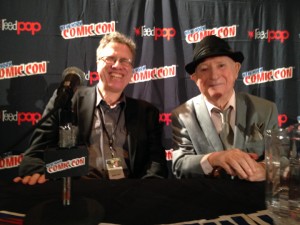
Danny Fingeroth and Irwin Hasen, comics legend.
Danny Fingeroth, comics scholar and editor at Marvel for many years was the emcee. Danny has written a number of how to books on comics as well as Superman on the Couch and Disguised as Clark Kent. Danny often presides over panels about comic book history and provides a solid background in the subject as well as a relaxed and fun atmosphere.
Paul Levitz was at DC for over 35 years and president there from 2002-2009. He’s considered by everyone in the industry to be a super comics scholar and he wrote 75 Years of DC. Paul spoke of Irwin’s accomplishments over the years and gave us a historical overview. Danny introduced Paul with the point that 75 Years of DC is a hernia-inducing book. It is a tome and one that is well written and leaves no stone unturned. You can see what kind of evening this was. There was no way this was going to be some solemn occasion with the constant kibitzing back and forth from Irwin to each of the panelists and the moderator and the audience erupting in frequent laughter.
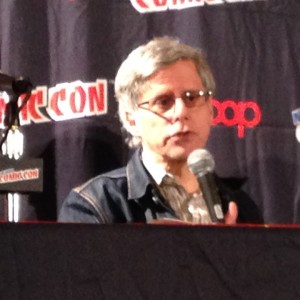
Paul Levitz, Comics historian and past president of DC Comics.
Dan Makara, a filmmaker who has produced a documentary of Irwin’s life, Irwin, a New York Story talked about why he decided to do the film and gave us some idea of how he worked with Irwin.
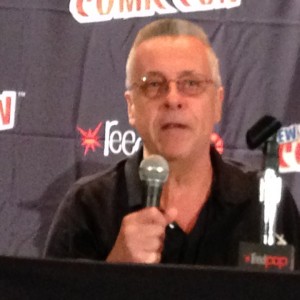
Dan Makara, filmmaker, Irwin, A New York Story
Michael Uslan, the producer of all the Batman movies and a writer of many comic book projects from Archie to Doc Savage spoke about Irwin’s accomplishments in comics and then presented the award to Irwin.
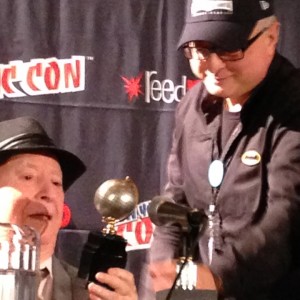
Michael Uslan presents the Eisner Award to Irwin Hasen.
Irwin was visibly moved and pleased to receive the Eisner and it was terrific to see someone of his age and length of time in comics able to enjoy this special moment.
The film was shown immediately after. Dan Makara has done a terrific job using fun ways of telling the story with animation and cartoons as well as the traditional voiceover and talking heads of the typical documentary. The ending is quite wonderful and I’m not going to give it away because you should see this tribute to Irwin for yourself wherever it’s shown.

By:
Heidi MacDonald,
on 10/15/2014
Blog:
PW -The Beat
(
Login to Add to MyJacketFlap)
JacketFlap tags:
Interviews,
Conventions,
First Second,
Breaking News,
Paul Pope,
Top News,
NYCC '14,
Battling Boy,
The Rise of Aurora West,
Add a tag
by Zachary Clemente
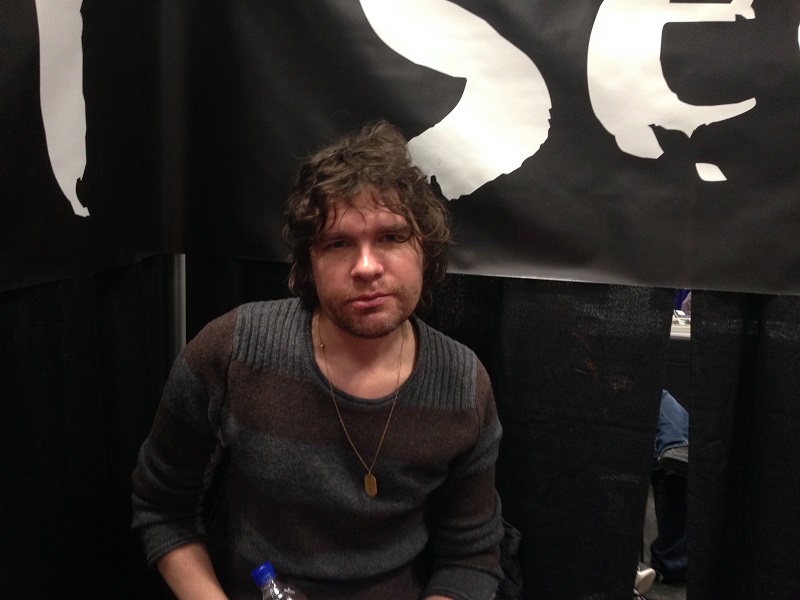 As the first day of New York Comic-Con came to close and exhibitors began shutting down their booths, I conducted my third interview with acclaimed cartoonist Paul Pope. This time we discussed his new entry in his Battling Boy series with First Second: The Rise of Aurora West, co-written by J.T. Petty and illustrated by David Rubín. Pope is an accomplished cartoonist, his published works including 100%, The One-Trick Ripoff, Escapo, Batman: Year 100, Heavy Liquid and is the recipient of multiple Eisner awards. It was a pleasure to speak with Pope again; you can find the first two interviews here and here.
As the first day of New York Comic-Con came to close and exhibitors began shutting down their booths, I conducted my third interview with acclaimed cartoonist Paul Pope. This time we discussed his new entry in his Battling Boy series with First Second: The Rise of Aurora West, co-written by J.T. Petty and illustrated by David Rubín. Pope is an accomplished cartoonist, his published works including 100%, The One-Trick Ripoff, Escapo, Batman: Year 100, Heavy Liquid and is the recipient of multiple Eisner awards. It was a pleasure to speak with Pope again; you can find the first two interviews here and here.
Comics Beat: Paul, have you had a chance to wander the floor or are you only here for the bits you need to be here for?
Paul Pope: That’s the unfortunate thing about working on this side of things, you don’t go as a far anymore. But whatever, it’s not I’m Samuel L. Jackson, I don’t need to sneak in wearing a costume or anything.
CB: So The Rise of Aurora West just came out, how’s the reception been for that so far?
PP: I don’t want to say surprisingly, but I’m very happy to say it’s been very positive. When it came out last Wednesday [9/30] I went out to the west coast and promptly got sick because the tour schedule can be punishing, especially when you’re in airports and schools and you’re not sleeping – it all caught up to me eventually. I was out there for APE but I just couldn’t finished the tour unfortunately, they sent me back and when I got home I slept for 2 days straight. I’ve been rescheduling with all the places I couldn’t get to, figuring out the best to time to get back soon. Hopefully it won’t be too much of a loss.
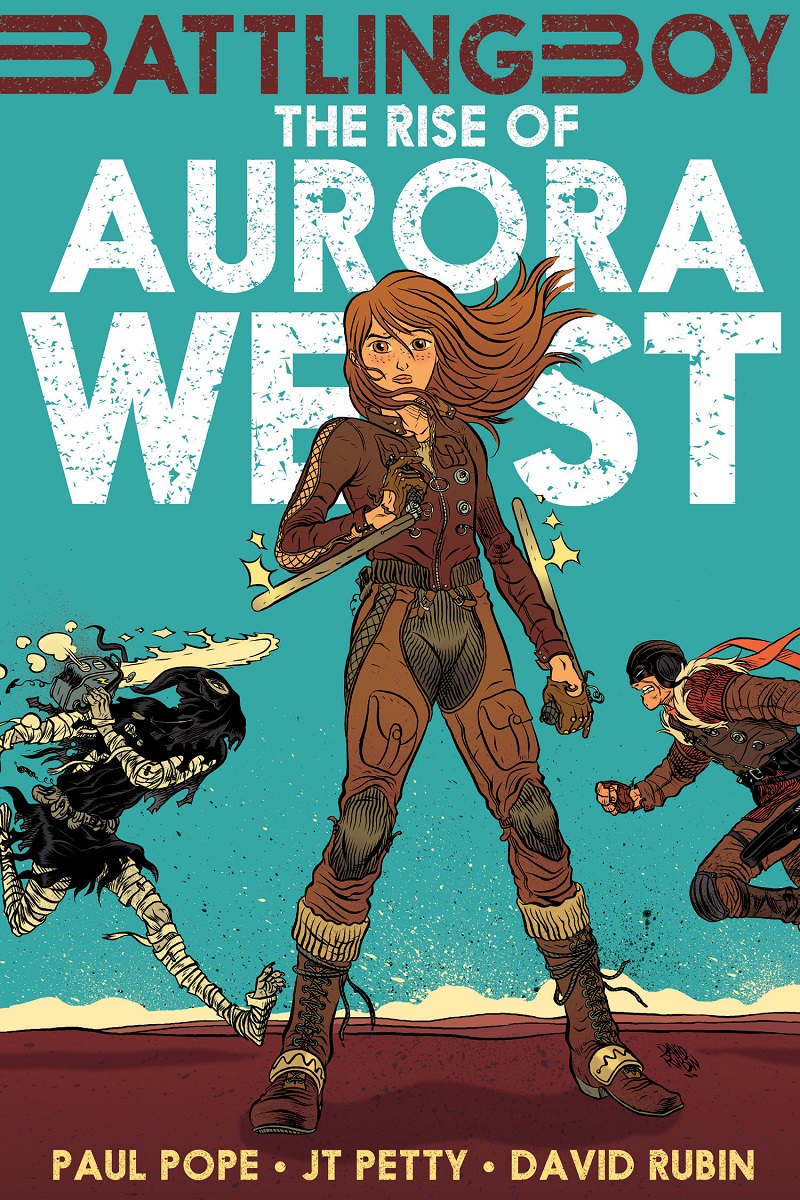
CB: With Aurora West, you’re choosing to let this world [of Battling Boy] into other creators’ hands. How is the process of – I don’t want to say “sacrifice” – collaboration within this world that you’ve been working on alone for so long?
PP: I talked to Mike Mignola about this not too long ago. [...] You know what he’s done with Hellboy has been great because he’s been able to invite other creators. It was pretty early on that it was looking like Battling Boy was going to be a hit, or at least it would warrant a second series. Since I’m still working on the second book and now promoting it, they asked if I had any ideas and I said we should do a series on Haggard West and Aurora – fill in all the gaps that are implied in the first book as I finish the second book, periodically leave town and come back again.
CB: So not only is it wise for world-building but also strategically a good thing for you.
PP: Yeah, also there is a larger backdrop to the characters and to the world; like, the monsters come from somewhere. In the Aurora series, we getting more of a sense of the mystery of where the monsters come from. It’s more of a pulp adventure.
CB: I thoroughly enjoyed it. It felt very rooted in manga with the printing format and art style.
PP: Well, J.T. understands horror and he gets pulp. David Rubín, like myself, comes from a sort of internationalist style and he likes manga a lot. He was able to keep it within a spectrum of style and approach that’s similar to mine and yet still be his own.
CB: It’s rare to see a very successful treatment of somebody else’s work by another artist who can inhabit both styles at once.
PP: Yeah, it was a lot of fun. He’s really fast too, which is great – he’s kicking my ass at the moment, I have to admit. I’m really happy with the results.
CB: Getting into the themes of the book, something I liked was taking the tropes of the “science” [super] hero idea and the consequence and responsibility of power. Haggard provided for this city for so long, when he turned inward, the city couldn’t handle itself. I found that best discussed in the scene with man on the bridge. How did this theme of power and consequence form?
PP: Well, it was one of the things J.T. and I talked about. I went in with my core idea based on the big, super-bible we wrote – we meaning me – for Battling Boy. We started talking about what the reality would be like, having your children stolen and we decided to try to do something where Haggard gets shaken out of his state of depression by having to help another father. I thought it was a good emotional bit – and it’s something we don’t typically see. [...] In Battling Boy, it’s a little more breezy and focused on the main five or six characters. You see more in the second book about other citizens, but for the most part it’s just Battling Boy, Aurora, and the city planners.
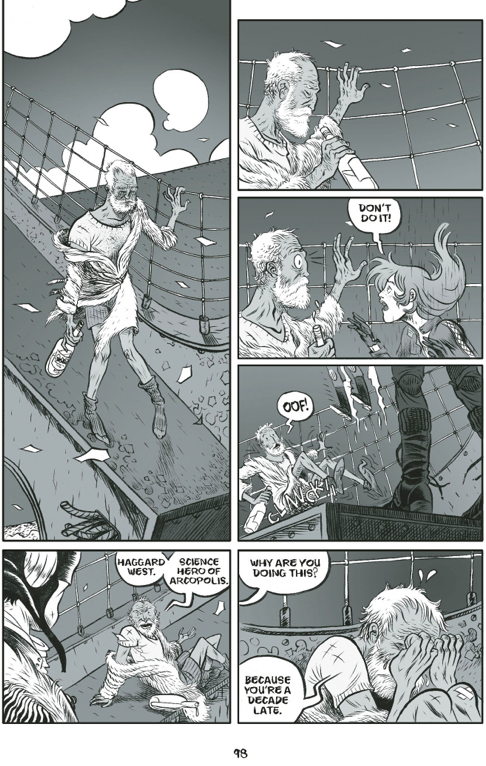
The Rise of Aurora West
CB: So now we’re getting a larger scope of what’s going on in Acropolis and how it’s dealing with its problems?
PP: Yeah, and obviously Battling Boy, as the name implies, is designed to have lots of explosions and fights and all kinds of stuff like that. Whereas Aurora was more psychological.
CB: It almost felt like the two different sides of Batman books. One’s very detective-based and the other is very action-based.
PP: That was plan going into it, actually. It’s frustrating though. Same with the character Dad in Battling Boy - there were a couple of scenes that I had to write out of Battling Boy that had to do with Dad just kicking ass because for one, that could be its own thing later. I also didn’t want to distract from the core of the story of Battling Boy which was the Boy’s coming of age. In Aurora, it’s the same. Luckily her version of Dad is Haggard; we get to see him without his mask and we get to see him in a family setup.
CB: That leads into my next question which is a big part of both books: would you call Haggard a good father?
PP: That’s a good question, you could ask the same of Dad. I think one of the things that attracted me to writing a story like this was thinking about how being a superhero or war god doesn’t leave you time to raise your kids – you’ll be busy. I’m interested in, fascinated and haunted by that idea of child soldiers. You hear about those types of things in Somalia; to have your child taken away from you. That’s something I find very sympathetic with Aurora and that’s something I wanted to explore with her character – how does she remain innocent?
CB: When we last talked, you said that you had things to say to children with Battling Boy; would you see Aurora as a continuation of that?
PP: One thing people seem to be picking up on with Aurora is that they’re really responding to her as a strong, female lead. She’s a teenage girl; she’s not a sexualized character, she’s not helpless; she’s a sidekick or protégé, but she’s got her own ideas and she does her own things. That’s kind of what her character requires and that’s the kind of personality the daughter of Haggard West would have. It’s been fun. [...] Battling Boy is more about–well, they’re both about abandonment in a sense, even though Battling Boy’s family is intact. I think Aurora’s story is more tragic, even though it’s kind of cloaked in this light, superhero, science-fiction setting. There’s archaeology and mysticism, but there isn’t any mythology in it. It’s the opposite in Battling Boy since he’s from the realm of gods.
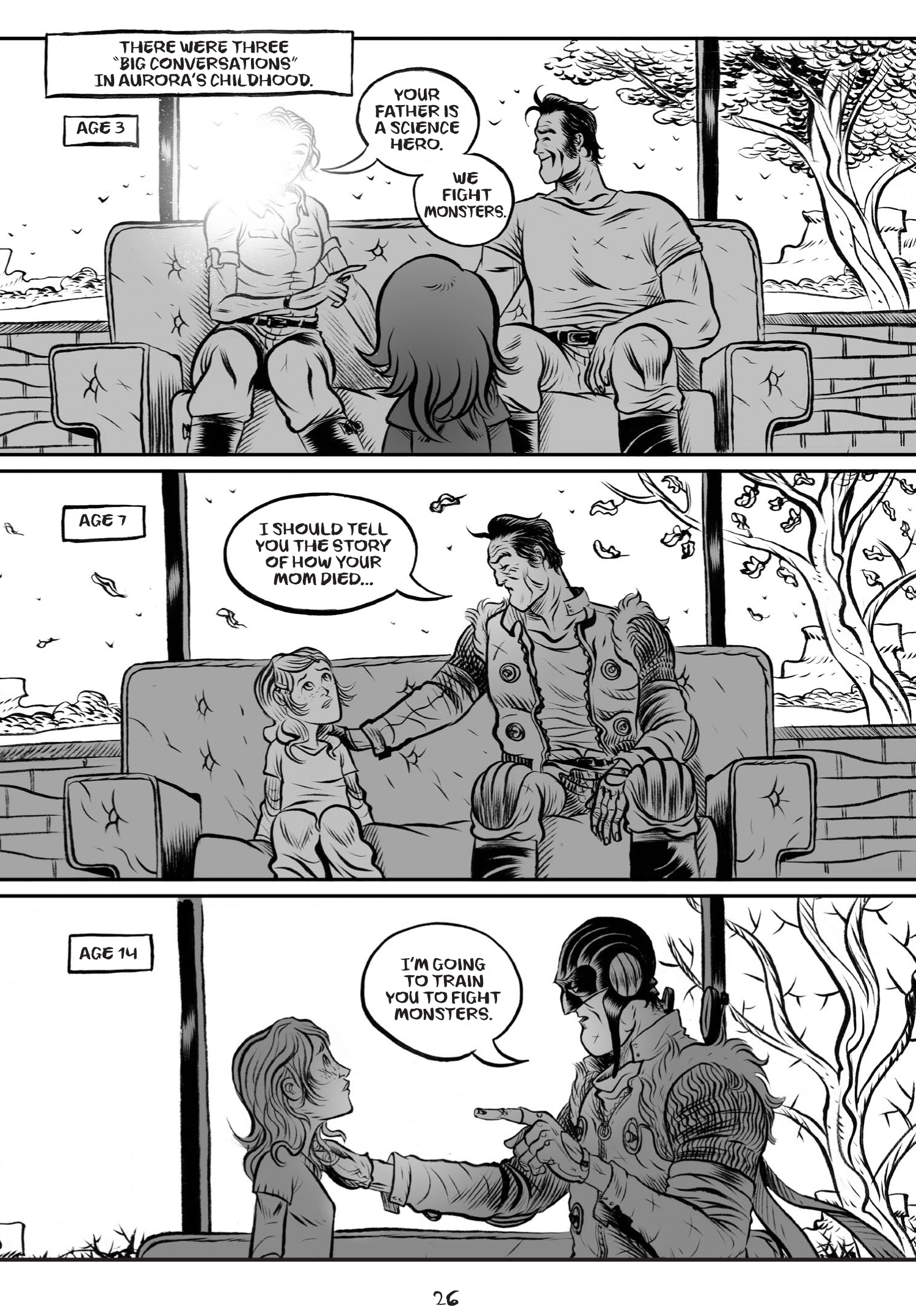
The Rise of Aurora West
CB: I feel like the archaeology in Aurora is the other side of the coin for Battling Boy‘s mythology. Aurora has this historical scope that I find interesting.
PP: When we went in with the initial pitch for the series, Haggard’s an archaeologist before he’s a hero, and he discovers evidence of an ancient city under the city we know in Battling Boy, and there might’ve been another Battling Boy. The kid is kind of a feral character – it’s implied that Battling Boy has siblings. Imagine, Dad is like a war-god, so he’s probably prolific in line with a lot of mythology. Like with Hercules and Zeus, they have tons and tons of kids. This god of war, god of conquest – he’s going to be busy fighting battles in the realm of gods, so he needs to have offspring to be able to send them to the realm of humans to take care of basically training-wheel problems. There’s a lot of interesting stuff going on in the background that’s coming out as the series develops.
CB: You touched on how the book came about, but how was the process of sharing the writing and where did duties lie?
PP: We did a sort of back and forth. It was his script and I gave him the liberty to write the voice of Haggard. [...] Part of my job now as being a story director as well as art director, so I don’t want to tell him how to do his job. He already knows what to do, he already knows how to direct movies and he writes video games and graphic novels – he’s really intelligent. It was more of us spending a few months really hammering out a story based on me saying “here’s what I really want to do.” We’d work on a core plot, knowing where the story begins and ends. At that point, I let him go and do his own thing. There were a few things though; his first draft was too violent because he likes horror. [...] There was some stuff with the characterization that I thought was a little off mark from what I was hoping for. Otherwise, I think the script came in really solid and it hit all the things I wanted. I try to give my collaborators room – I got that from Mignola because he told me that’s how he works with people.
CB: You did something like that with Vertigo anthology, Ghosts where you made the story but didn’t write the script.
PP: Oh you mean with Dave Lapham? Yeah, that was a good experiment. [...] I might be doing something else with another guy where I’m drawing something he’s gonna write. The way we worked on the space opera story was I said “here’s what I see: this mini-opera, there are the images I want.” Then we kicked around some ideas and he came up with some interesting stuff. That was more of a true collaboration in a sense because we wrote it together.

‘Treasure Lost’ in Ghosts #1
CB: How far are you willing to take this collaboration with the Battling Boy world?
PP: Well…it’s easier now after having worked on the film because there’s so many people involved; you can’t be a dictator when it comes to film. With the Battling Boy series that I have been writing and drawing, it’s pretty much my baby; I get minimal editorial input. With the colorist, Hilary Sycamore, she and I have a long conversation before she starts a large stretch of work. I always try to give her the sense of what I’m feeling for a scene. For example, the god realm is always in twilight, the human realm is always Mediterranean with terracotta and aquamarine colors, and the monster realm is like hell so it’s browns and reds.
The place I can be 100% myself is in Battling Boy and as we gradually expand on the series, I want to make sure to pick out people I like and respect and can work with and try to write or direct for their strengths, while being aware of their weaknesses. I think that’s the way to collaborate.
[Spoiler for Aurora West] CB: At the end of Aurora, the monster Coil mentioned that Aurora is his “animus” in the Jungian idea of one half of a whole inside the other and vice versa. Is that a discussion on the origin of monsters and their connection to the children in Battling Boy?
PP: [Laughs] You’re onto something there. Let’s just put it this way: the big boss that we see at the end of Battling Boy who Sadisto is working for is a scribble monster. It’s implied, by the time you hit Aurora, that these monsters might be very old, many of them aren’t even fully formed creatures yet. Yeah, there’s definitely a connection between that and that’ll be coming out as the series develops. Good call on that one.
CB: So, “The Fall of the House of West” – is that the second Battling Boy book itself?
PP: No, that’ll just be called Battling Boy 2. Ultimately, they’ll both be collected – I’m imagining Aurora as a two-parter: Rise of Aurora West and Fall of House West. It’s designed more around this kabuki stage set: tragedy and family. So act one is the rise and act two is the fall; that was definitely very conscious on our part. David wasn’t happy with the title at first; he thought, having come from film and a lover of westerns, he’s seen this type of thing a lot. Like with Battling Boy implies; it’s about a boy who’s fighting. Rise of Aurora West–first of all, it sounds alliterative and The Fall of the House of West has kind of a Shakespearean feel.
CB: I find that both Battling Boy and Aurora are well-described by their titles. As the stories utilize these touchstones in storytelling that people have come to expect, but works with them in such a unique way. The titles end up being evocative for their stories.
PP: Yeah, what’s really fun about it is meeting all these young readers. A lot of them are 10 or 12 years old and they’ve really never read comic books before. They might’ve read Adventure Time or Tintin, but this is the first time a lot of these kids, especially girls, are getting the sense of Kirby Krackle or Moebius. Certainly they know Ghibli’s movies like Spirited Away going into it, but for the first time they’re getting opened up to what we think of as Silver Age comics or awesome French comics from the 70’s.

The Rise of Aurora West
CB: We might be seeing a lot more of those Nausicaä boxed sets flying off the shelves soon.
PP: I love that film, though Laputa is my favorite, but it’s hard to say as there are so many good ones.
CB: I ultimately fall on Porco Rosso as my favorite.
PP: He [Hayao Miyazaki] said he made it for guys our age. Porco Rosso is a big influence on the coloring in Battling Boy.
CB: I totally see that. It’s all coastal, Mediterranean cities.
PP: I was Italy when I was writing Battling Boy, I just really fell in love with the south of Italy; the lighting and the colors, the way the sea looked on the Adriatic coast. At nighttime with the volcanoes in the distance, it’s so romantic and old. It fits with the ideas I had for Arcopolis; it isn’t like Berlin, 1945- dark and scummy. It’s this old and vibrant city that’s fallen on bad times.
CB: That makes sense with your work and European influences, I think. The recorded history there is just so much older.
PP: Even more so for Africa and Asia. That’s why, in Aurora, the analog for the oldest city is Egypt. I was thinking about all this stuff, but I wasn’t really able to put it across. Where Haggard lives in the city, his decor is very Pacific Northwest – it’s a lot of fun to draw.
CB: It’s got a very collector vibe to it, too.
PP: Yeah, something I noticed with some of the heroes from occult fiction, whether it’s Sherlock Holmes or Lamont Cranston – they collect a bunch of ancient artifacts and stuff. Indiana Jones is like that too, but he’s a thief.
CB: It has those classic Campbellian story elements; out of travel a hero is born.
PP: Actually, Haggard belongs to an explorers club like National Geographic and we’ll see more of those characters later. I’m going to do an annual portrait of Haggard with his compatriots, so in that sense, he’s a little like Doc Savage. Like in Buckaroo Bonzai, he’s got his gang if he needs a specialist in this or that.
CB: Wrapping up, other than Mignola’s “Hellboy-verse”, are there any other series with larger built-up worlds that have this kind of multi-thread publication structure that you’re inspired by?
PP: One big influence is definitely the RKO [Pictures] and Universal [Pictures] movie series from the 30’s and 40’s like Flash Gordon. [...] There’s always the classic Universal monster movies, German expressionism and early Soviet-era cinema; whether it’s Eisenstein or Fritz Lang – those are big influences. That’s the fun thing, in the same way that Battling Boy is full of my love of Kirby, Moebius, and Miyazaki, the same of true for Aurora. It’s like a flipped coin – the dark side like Boris Karloff, H.P. Lovecraft – these kind of things, it’s more of a vintage feel.
That works with J.T. because he directs horror movies; he’s writing The Walking Dead video game, I don’t know if you know that. He has a wicked sense of humor and a wicked sense of the wicked, and he also has two children. We got lunch a couple days ago after a signing and we had a long conversation; we got into some dark stuff. [In Aurora] monsters are kidnapping children and we started talking about some really gruesome stuff and it’s like “this is where it’s coming from.”
CB: Thank you very much Paul.
PP: Sure, thank you.
Paul Pope is an Eisner-winning cartoonist currently in Brooklyn, New York. He is actively working on his Battling Boy series with publisher First Second. You can find more of his work on his website.
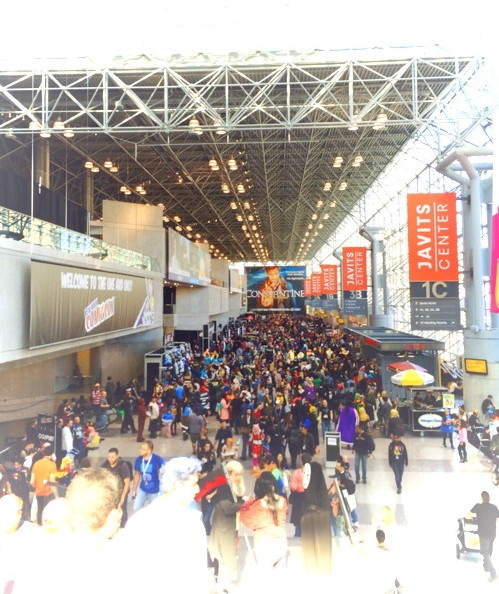
As you may have noticed, there were a lot of stories coming out of NYCC. Here’s a convenient list of what we covered, separated by publisher.
Archie
Archie Vs… Predator?
Archie’s Dark Circle Line Gives Out A Little More Info
Dark Horse
NYCC’14: CCP Games Enlist Dark Horse Comics For EVE: VALKYRIE
NYCC’14: Dark Horse Announces New Goon
NYCC’14: Dark Horse Announces GUN THEORY Hardcover
NYCC’14: Dark Horse Announce Tale of Tropical Epicness
Interview: Dark Horse Publish Sally Heathcote, Suffragette GN – Kate Charlesworth, Artist, Speaks!
NYCC’14: Dark Horse Announces Kabuki Collection
Dark Horse collects Matt Kindt’s Pistolwhip
NYCC’14: Dark Horse Continues Super Week Announcements With RESIDENT ALIEN
NYCC ’14: Dark Horse announces exclusives
DC
NYCC’14: “DC Digital First” New Titles Announced
Dynamite
Dynamite Acquires Mage Wars License, Launches With Prose Novel
Twilight Zone Has a New Ongoing Series
Dynamite’s Legenderry Spins Off Three Titles
The World’s Most Evil Button Returns – Smiley the Psychotic Button
Jim Butcher’s Dresden Files: Down Town Coming in Spring 2015
Nancy Collins On an Older Red Sonja in Vulture’s Circle
Bond, James Bond coming from Dynamite
Dynamite expands Art Editions line with Vampiralla, Battlestar Galactica and John Carter
IDW
NYCC’14: IDW Brings Chris Carter’s Other Show to Comics
NYCC’14: IDW Adds Spider-Man
NYCC ’14: IDW announces Signings with Simonson, Rodriguez and more
Image
NYCC ’14: Frank Quitely on Visual Process and Cyclical Influence
NYCC ’14: Teasers, terror and a few tears: Inside AMC’s Walking Dead Season 5 panel
“Where’s Michonne?” Robert Kirkman gives a behind the scenes look at the past, present and future of ‘The Walking Dead’ comic series at NYCC
Todd McFarlane Passing Spawn Over To Brian Wood
NYCC ’14: Image announces signings and Instagram contest
Marvel
NYCC’14: Marvel Spider-Announcements to Close the Show
NYCC ’14: Marvel finally confirms their Fantastic Four Cancellation: WWBGD?
NYCC’14: New Black Widow Project and Gamora Series
NYCC’14: New Ant-Man Book Coming From Marvel
NYCC’14: New Hawkeye Creative Team Announced
NYCC’14: Check out Marvel’s Daredevil Promotional Images
NYCC’14: Marvel’s Cup O’ Joe Panel Reveals a Black Vortex, Peggy Carter, and Star Wars Galore
NYCC’14: Retailer Exclusive: Meet Marvel! Marvel Teases Upcoming Events!
NYCC’14: Baby Groot Officially ‘Grooting’ to a Store Near You!
NYCC’14: Marvel Announces Spider-Gwen
Marvel Relaunching Secret Wars in 2015 “in a synergistic fashion across the Marvel brand”
Oni
NYCC ’14: Oni Press Shows Down With Upcoming Lineup
Valiant
NYCC’14: Valiant Declare Quantum and Woody Must Die
NYCC’14: Valiant Shows off The Valiant #1
Instagram Posts
NYCC 14: #comicsbeat #nycc Barf & Lonestar cosplay
NYCC 14: #comicsbeat #nycc WOW this Cassandra cosplay overwhelms me! #doctorwho
NYCC 14: #comicsbeat DRAGON BALL ADORABLE! #nycc
NYCC 14: #comicsbeat Dance magic dance! Stunning Jareth cosplay! #nycc
NYCC 14: #comicsbeat #nycc legend of korra cosplay
NYCC 14: #comicsbeat AWESOME HANNIBAL COSPLAY #nycc
NYCC 14: #comicsbeat HANNIBAL cosplay!
NYCC 14: #comicsbeat Joel & Tom Servo #mst3k #nycc
NYCC 14: #comicsbeat Awesome dark Phoenix
NYCC 14: #comicsbeat 80’s Storm-brilliant! #nycc
NYCC 14: #comicsbeat @betsyboowho in an amazing Captain Marvel @marvel #nycc
NYCC 14: #comicsbeat Mojo Jojo at #nycc
NYCC 14: #comicsbeat Adorable Steven Universe cosplay #nycc
NYCC 14: #comicsbeat Spot on Babs Tarr #batgirl cosplay at #nycc
NYCC 14: #comicsbeat That #kitemovie crew seemed like a beautiful and terrifying gang.
NYCC 14: #comicsbeat Watch out #nycc
NYCC 14: #comicsbeat Doctor Who cosplayers assemble! #nycc #doctorwho #cosplay
NYCC 14: #comicsbeat Cool #nycc special guests Naruto and R2D2
NYCC 14: #comicsbeat They say it’s made of wax but I dunno…keep your eye on this one.
NYCC 14: #comicsbeat Starting #NYCC off right with some Rocket Raccoon.
Misc
New York Comic Con 2014 was the biggest US comic con yet—and one of the most diverse
NYCC ’14: A Conversation with Marc Evan Jackson on the Detroit Creativity Project
Today’s Inside Edition to report on Comic-Con harassment
NYCC’14: NYCC Staff Q&A: Complaints, Compliments, and Concerns from Attendees
Her Universe and Ours
Cosplay, Consent and Signs of the Times
NYCC ’14: Trailer for Powers debuts
#Tweetfolio: Your Guide to the Perfect Portfolio Review
5 Things We Learned About Adam West at #NYCC
NYCC’14: Famous Author to be Adapted as a Graphic Novel!
Grant Morrison and Steve Niles Headline Black Mask’s Second Phase
NYCC ’14: Win $50 for your Halloween swag from Costume Supercenter
NYCC ’14: Day 0—A New Hope
NYCC ’14: Finally, we’ll find out what happens when you clear the room between panels
NYCC ’14 Nom Nom: the special foods of New York Comic Con
NYCC ’14: Comixology announces panels and party
NYCC ’14 — a safety guide
NYCC ’14: Hitch a ride with Uber in their Comic Cars
NYCC ’14: Hero Initiative announces activites including Denny O’Neil
NYCC ’14: Insight Editions offers turtles, assassins and lots more
NYCC ’14: Viz offers exclusives and Takeshi Obata

By:
Heidi MacDonald,
on 10/14/2014
Blog:
PW -The Beat
(
Login to Add to MyJacketFlap)
JacketFlap tags:
News,
Television,
Marvel,
Conventions,
Announcements,
Showbiz,
NYCC,
Top News,
Clark Gregg,
NYCC '14,
agent carter,
Agents of S.H.E.I.L.D.,
Jeff loeb,
Ming-Na Wen,
Add a tag
By Edie Nugent
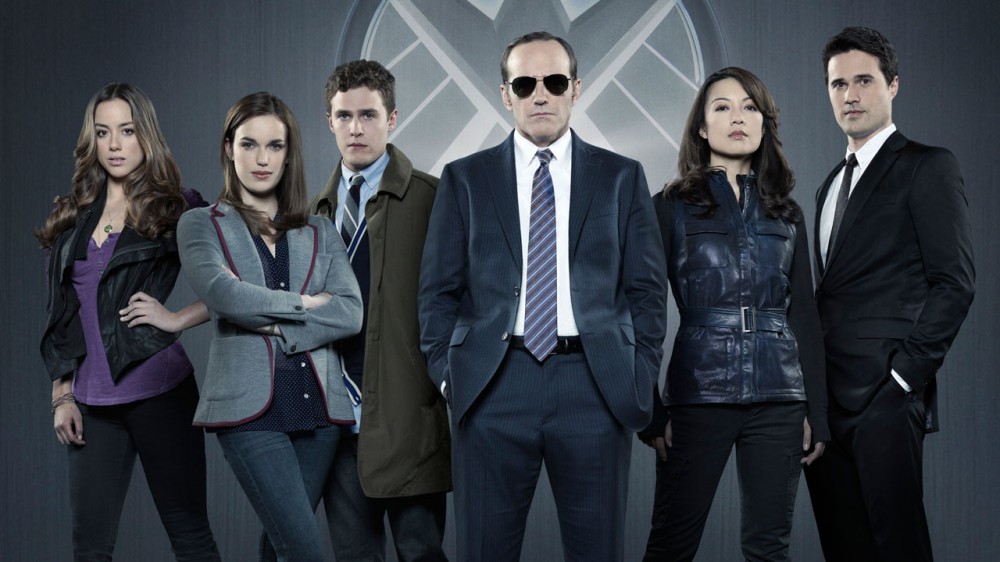
The cast of Agents of S.H.I.E.L.D. Photo Credit: ABC.Marvel Studios
If the response from the fans at NYCC is anything to go by, Marvel’s Agents of S.H.I.E.L.D. should delight viewers with “Face My Enemy,” the fourth episode of season two. Nearly 3,000 people lined up in advance of the Friday night screening to obtain bracelets allowing them to get an early look at the episode which airs tonight at 9pm on ABC. Once the doors closed to the exhibition hall, it wasn’t long before Jeff Loeb-Marvel’s Head of Television-stepped onto the stage. The fan response to the Eisner-award winning writer was warm, with extended applause from the crowd.
Loeb seemed genuinely excited to introduce the NYCC exclusive premiere of the episode, explaining that around the Marvel offices the Agents of S.H.I.E.L.D. franchise is referred to as “The Mothership.” When he expressed how proud he was that the show made it to a second season-something the show’s lackluster first season ratings in no way guaranteed-the cheering reached its’ zenith.
Loeb took full advantage of the atmosphere, saying “one of the things I hope that you learn about season one is, let’s put it this way: anyone can be Hydra.” Loeb opened his button-down shirt to reveal a Hydra logo-tee underneath. The audience booed and moaned, but their disapproval was short-lived. Actor Clark Gregg quickly jumped on stage and began yanking at Loeb’s shirt in disgust. The booing quickly turned to cheering as fans jumped to their feet to give the man who portrays fan-favorite Agent Coulson a standing ovation. Some even stood on their chairs and began a sweeping chant of “Coulson! Coulson!”
Gregg appeared to be humbled by the adulation. Loeb agreed with the response, saying: “the reason why we are here, the reason why there is an Agents of S.H.E.I.L.D. is because of the extraordinary talent of our friend Clark Gregg.” The actor shouted: “It’s good to be alive!” Whether he was speaking of his resurrection in Agents of S.H.E.I.L.D., his adoring fan base, or both was unclear. Gregg went on to thank his fans for sending emails and messages in support of his character following Agent Coulson’s death in Marvel’s The Avengers (2012).
Gregg revealed that when Loeb announced he’d be attending NYCC, Gregg begged to tag along. He explained that the announcement from “Jeff and Joss” that Coulson “wasn’t quite dead” was made at NYCC two years earlier, giving him a special feeling about the con. Gregg continued: “I love New York, I love this con…and my feelings have only gotten warmer because this is where I was resurrected.”
Gregg playfully teased Loeb for his Hydra t-shirt, prompting Loeb to offer to “make it up” to Gregg by showing “Face My Enemy” in its entirety to the crowd. As the episode played, the eager audience seemed to embrace the story at every turn, applauding when Agents May (Ming-Na Wen) and Coulson appeared on-screen. The episode continues SHEILD’s efforts to understand the strange carvings that both deceased Agent Garrett (Bill Paxton) and Agent Coulson created following their exposure to GH-325-the mysterious drug that brought Coulson back to life.
The audience reaction was one of deep emotional investment, by turns exuberant, amused, and-near the end of the episode-shocked. When Gregg and Loeb returned to the stage following the end credits, Loeb noted the crowd’s reaction and said: “I have to thank you, Clark and I were sitting back stage and your response to that was just extraordinary.” He also gave a shout-out to veteran television writer Drew Greenberg, of Buffy the Vampire Slayer and Smallville fame, who penned the episode.
Gregg pestered Loeb further, asking “can we show them something from Agent Carter?” The resounding cheers spurred Loeb to comment that the series, had only begun shooting earlier that week. Agent Carter follows the life of Peggy Carter (Hayley Atwell), founder of S.H.E.I.L.D, last seen in Marvel’s Captain America: The Winter Solider (2014). Gregg then produced a CD allegedly containing some of the shows early footage. Moments later a short clip appeared on screen, which found Carter partnering with Howard Stark (Dominic Cooper), inventor, father of Iron Man Tony Stark & founder of Stark Industries. The teaser also saw Carter’s introduction to Edwin Jarvis (James D’Arcy), butler to the Stark family and inspiration for Tony’s Starks’ invention of J.A.R.V.I.S. Artificial Intelligence.
“Face My Enemy” premieres tonight, but fans will have to wait until January 2015 to see the premiere of Agent Carter. While the audience reaction to the early footage was overwhelmingly positive, whether Marvel Television can keep fans engaged and tuning into both of their S.H.E.I.L.D-based shows remains to be seen.

With attendance of 151,000, this year’s NYCC is now the biggest reported North American comics convention, surpassing the San Diego Comic Con’s 130,000. According to show runner Lance Fensterman, the increase of 20,000 from last year was due to selling tickets for a full day Thursday, which was previously a half-day “pro day.
I’m told neither number includes pros and exhibitors and ‘industry support” however, so the exact number of numb and yet enthused people wandering the halls of either Comic-Con has not been released. Given the number of lookie-loos who hang around in San Diego, that event would still seem to be the biggest.
Many people wondered how NYCC could be bigger than SDCC when the Javits Center is smaller than the San Diego Convention Center. I’m sure Torsten can give us the exact dimensions, but on most lists I’ve ever seen, the Javits is actually larger than SD Convetion Center. This stat is misleading however.
According to Wikipedia, the Javits has 840,000 sq ft of exhibition space and 1,800,000 sq ft of total space.
The San Diego Convention Center has a mere 615,700 sq ft of exhibition space but 2,600,000 sq ft of total space.
The Javits floor is obviously much smaller than THE TOTAL SPACE at SDCC where we spend so much time wandering around. The Javits total exhibit space includes the “Galleria” area on the fourth floor which was used this year as the press room, VIP area and media interview space. It’s a huge area the equal of Hall H that most people never even see. And of course, the SDCC was actually designed with a lot of people in mind, whereas the Javits is a dank rabbit warren of tunnels and low-ceilinged cattle pens. Okay not really, but it isn’t the best.
I did not feel that the Javits was dangerously crowded this year, mostly due to the genial disposition of the gentle mob. However some adjustments are going to be made, as I will reveal in my story for Publishers Weekly to be published tomorrow.
Now a few observations on the show from the meta standpoint. It was absolutely and without question The Year of the Woman. Not only were there numerous announcements of books with female talent, but a dozen panels on diversity and representation drew huge crowds, and the harassment policy was widely considered a success. I’ll have more to say about all this tomorrow, but a few links:
• The diversity panels were PACKED. All 12 of them.
• Writer and commentator John Scalzi was pleased with the creation and display of NYCC’s harassment policy:
This is, pretty much, how an anti-harassment policy should be implemented.
And as a result, did the floor of the Javits Center become a politically correct dystopia upon which the blood of innocent The True (and Therefore Male) Geeks was spilled by legions of Social Justice Warriors, who hooted their feminist victory to the rafters? Well, no. The floor of the Javits Center looked pretty much like the floor of any really large media convention — people wandering about, looking at stuff, wearing and/or admiring costumes and generally having a bunch of geeky fun. Which is to say that as far as I could see the policy didn’t stop anyone from enjoying themselves; it simply gave them assurance that they could enjoy themselves, or get the problem dealt with if someone went out of their way to wreck their fun.
• According to
Isha Aran at Jezebel
New York Comic Con Was All About Diversity This Year
• James Whitbrook thinks that How New York Comic Con has shown us a wonderful future for Comics with the announcement of many female led projects:
The fact that these weren’t just throwaway announcements either, but some of the biggest news for DC and Marvel out of the Con, speaks to the importance for getting a wider variety and diversity of characters out into fans hands. The fact that they’re tentpole releases (Wonder Woman ’77 itself will head the vanguard for the latest batch of DC Digital releases, another welcome trend of Comic’s embrace of the digital age), accompanied by madly popular panels devoted to the women of comics and the industry itself from both DC and Marvel goes to show how they are slowly but surely getting better at nurturing their female fanbases as well. Lord knows they’ve both screwed up lately, but it’s nice to see positive news on this front for once.
• Laura Mandanas at Autostraddle has a positive review of the LGBT events at the con, although there could be more programming for this group.
• And a couple more including a representative overview by Jay Deitcher at Unleash the Fanboy:
• And not really to the point of this artuicle but I thought it was funny: Marvel even leads DC in preventing leaked footage.

By:
Heidi MacDonald,
on 10/14/2014
Blog:
PW -The Beat
(
Login to Add to MyJacketFlap)
JacketFlap tags:
Interviews,
Conventions,
Process,
Image,
Breaking News,
Grant Morrison,
Frank Quitely,
Top News,
NYCC '14,
Jupiter's Legacy,
Multiversity,
Add a tag
by Zachary Clemente
 On the extremely busy Saturday of this past weekend’s New York Comic-Con, I had the sublime honor of interviewing Frank Quitely (pen name for Scottish artist Vincent Deighan) about his visual narrative process, the cycle of artistic influence, and his once and future work. This was a wild treat for me as Quitely stands as one of my favorite artists in comics. Quitely has worked on We3, Sandman: Endless Nights, Flex Mentallo, New X-Men, JLA: Earth 2, Batman & Robin, Jupiter’s Legacy, All-Star Superman and many more.
On the extremely busy Saturday of this past weekend’s New York Comic-Con, I had the sublime honor of interviewing Frank Quitely (pen name for Scottish artist Vincent Deighan) about his visual narrative process, the cycle of artistic influence, and his once and future work. This was a wild treat for me as Quitely stands as one of my favorite artists in comics. Quitely has worked on We3, Sandman: Endless Nights, Flex Mentallo, New X-Men, JLA: Earth 2, Batman & Robin, Jupiter’s Legacy, All-Star Superman and many more.
Comics Beat: Frank, you’re currently working on Jupiter’s Legacy [with Mark Millar] which is ending after 10 issues?
Frank Quitely: It’s actually two volumes, both five and five.
CB: I see. Something I’ve always loved about your work is how versatile your storytelling can be. Hearkening back to Flex Mentallo, there’s some interesting panel layouts, All-Star Superman is a little more cinematic and straightforward, and We3 deviates a lot. I’m wondering how you approach that you want to train the reader’s eye the way you start talking about the story through your art and panels.
FQ: When I started out, I didn’t know a lot about storytelling because I never got a formal training in comics. It ended up being kind of intuitive and my main thing was about trying to make it clear and interesting. You know, I wasn’t really thinking in terms of narrative flow, it was more just about clarity and trying to make it as good as possible. Gradually, over the years, I just became more interested in storytelling. There was a DC editor I worked with named Dan Raspler – the Lobo editor amongst other things. He was my editor on JLA: Earth 2 and before I did JLA, I did a short Lobo story for them and it was the first mainstream DC thing I’d done; I’d been working for Vertigo and Paradox for a couple years. I sent him the pencils and it was the best thing I’d done up to that point and I thought “he’s going to phone me back and tell me how good this is” and he didn’t phone for a week. I was really panicking by the time he phoned; he started the conversation with “dude, I don’t know how to tell you this…”
Basically what he said was my drawings were really lovely, but my storytelling was really boring. He went through and told me what I should be thinking about and that was kind of a real milestone. As it was, that book never came out for different reasons. For JLA: Earth 2, he made me fax a rough for every page because he wanted to see that I could do art that makes sense in rough with a sharpie, then I could do it properly.
CB: Sort of like doing thumbnails?
FQ: Yeah. In fact, the new version of [JLA:] Earth 2 has those thumbnails in it. That was a big leap for me.
CB: There’s a couple panels I’d like to ask you about, the first from We3. The one where it looks like the panel begins to turn across the page.
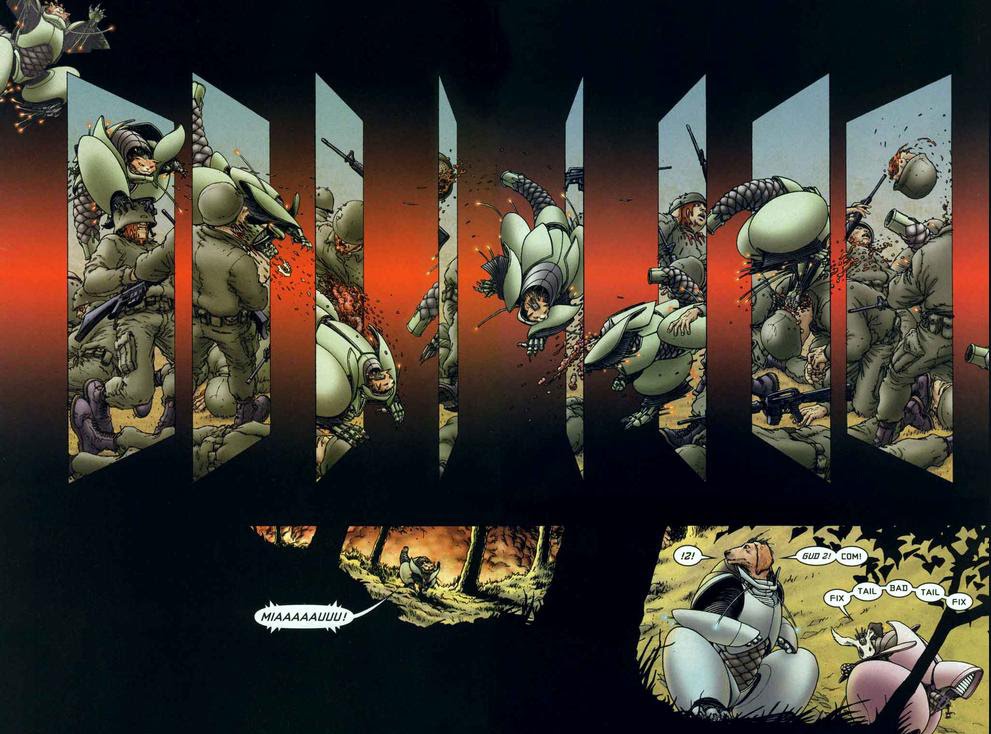
We3 by Frank Quitely & Grant Morrison
FQ: With the cat leaping through?
CB: Yes!
FQ: Grant [Morrison] and I sat together, both of us with pencils, trying to work out a way of doing this. [...] That kind of “turning the panels” was almost like windows that the cat was going though – that didn’t come right until the last minute because Grant was describing something to me but it was like he knew there was something there we could do but he couldn’t quite visualize it. It was just a case of me sitting, drawing stuff and then asking if we were getting closer – it was very collaborative.
CB: Do you think that kind of collaboration is where you find the best of your work coming out?
FQ: Um, sometimes. Sometimes it works that way and sometimes it’s nice just to be left alone and work it out myself. Like in Jupiter’s Legacy, in the first issue there’s kind of cube thing. In the script, Mark said something like “he puts them in this cell” and I got thinking about “cel” as in animation cel as well as “cell” like a prison cell and it just kind of came together very, very organically in a relatively short time. It really goes both ways.
CB: I actually wanted to ask about that panel. It’s beautiful how it breaks down all the way to the linework and builds it back up again. I find it an interesting visual discussion on comics.
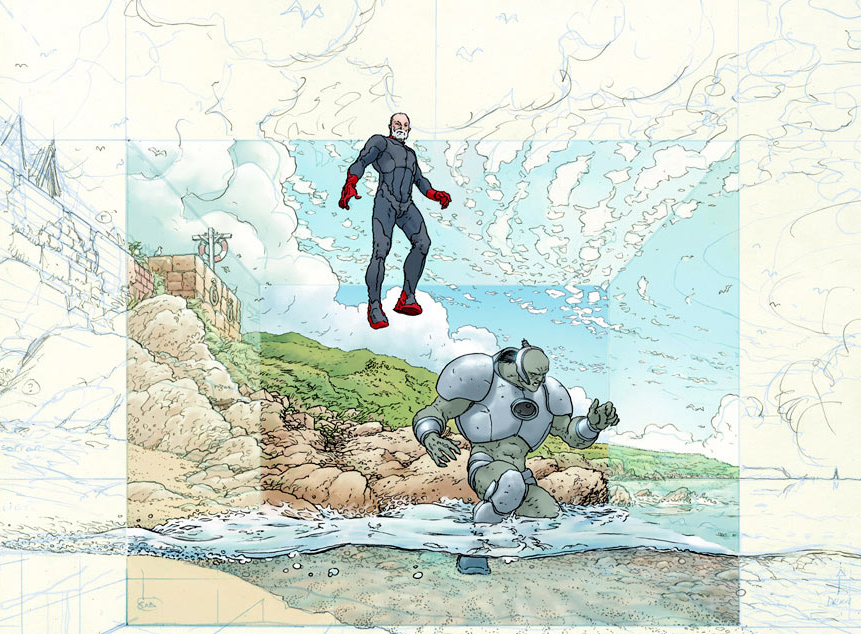
Jupiter’s Legacy by Frank Quitely & Mark Millar
CB: Changing gears a bit, I’m curious about your influences. Not necessarily artistic influences, but what comics have influenced the way you want to do comics, the way your approach working on comics?
FQ: An early one was Hard Boiled by Frank Miller and Geof Darrow. I set out when I was maybe 20-something and when I saw that, I was really blown away by that. More recently Chris Ware’s Building Stories, it’s a masterpiece – the guy’s a genius. I’ve gone plenty – Akira, the big black and white collections of Akira. Moebius, particularly [his] short stories.
CB: The sheer breadth of his influence is remarkable and that’s something I wanted to touch on with you. In my opinion, you and your work occupy a peculiar place in the comics “family tree” where your catalog is intensely influential for many contemporary creators, but it’s not like you’ve gone away, you’re still pushing yourself. Do you find yourself in something of a loop, being influenced by people you might have influenced?
FQ: Oh, yeah.
CB: What is that like?
FQ: It’s really cool. It’s actually really cool. Two artist who work I really like a lot who’re younger than me are Amy Reeder and Becky Cloonan and both of them, in some way, found something in my work that they liked and there’s now something in their work that I like. With Amy in particular, she started off at Tokyopop and she was only interested in manga. Brandon Montclare, who she’s working with now [on Rocketgirl], was an editor at Tokyopop at the time and he gave her a bunch of comics that he wanted her to look at to kind of broaden her horizons a bit. When she first saw it, she didn’t like my work at all; there was nothing there that she liked. Brandon told her to ignore that she didn’t like my drawing but to look at was I was doing because I was going about it a different way from her. After a while, she did actually start liking it and that’s the kind of funny thing – she didn’t like it at all at first but once she kind of get into it, she got something from it and now her recent work on Rocketgirl is just phenomenal.
When I see stuff like that, I always feel slightly threatened by a lot of younger artists. Because to me, a lot of this stuff seems really fresh and I keep thinking “shit, man, I’m going to have to up my game.”
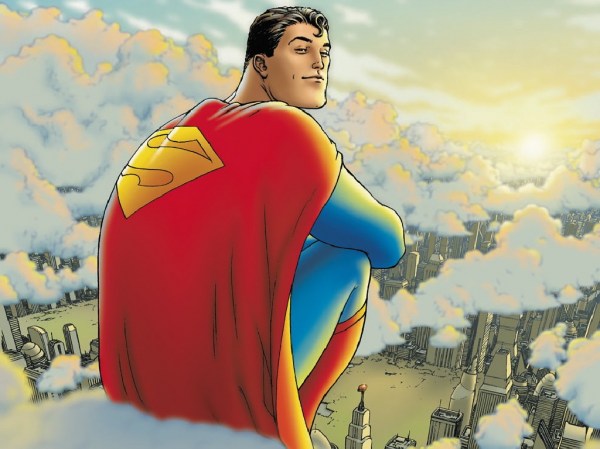
All-Star Superman by Frank Quitely & Grant Morrison
CB: Can that be a little thrilling?
FQ: Yeah – absolutely. I don’t want to get to a stage where I’m kind of quite happy with what I’m doing. Like every other artist I know, I see the mistakes in my work more than the good parts. Even things that work quite well, it always looks slightly better in my head. Every page I start I think “this is going to be the best one yet!” So I don’t want to get to a stage where I’m not influenced or threatened by other peoples’ work.
CB: That’s a very remarkable way to stay relevant. Though something I noticed is your lack of online presence. It seems being active on social media outlets is a big part for many comics creators. Is this something that’s never interested you?
FQ: You know, the thing is I can’t answer all my emails as it is, I answer maybe a quarter of my emails or something. So what’s the point of having Facebook? I’m already insulting enough people by not getting back to them. If I had a Facebook presence, I would never talk to anybody – I’d just never get back to them. Either you just that kind of person or you’re not, you know.
CB: Heading to the end, Jupiter’s Legacy will be wrapping up, what’s next?
FQ: “Pax Americana” – one of the Multiversity books at DC.
CB: And are there any dream projects? Characters you want to work on, people you want to work with, or your own stories you’d like to make?
FQ: I have written a bunch of short stories and some of them are thumbnailed. So at some point I want to get a collection out of just my own dumb stuff.
CB: That sound wonderful Frank, thanks for sitting down to chat.
FQ: Not a problem – thank you.
Frank Quitely lives in Scotland and draws some of the most amazing comics around. I encourage you to watch the 30-minute feature about him, part of a series called “What Artists Do All Day” produced by BBC4. His upcoming works are the next 6 issues of Jupiter’s Legacy and an issue of DC’s Multiversity called “Pax Americana.”
by Zachary Clemente
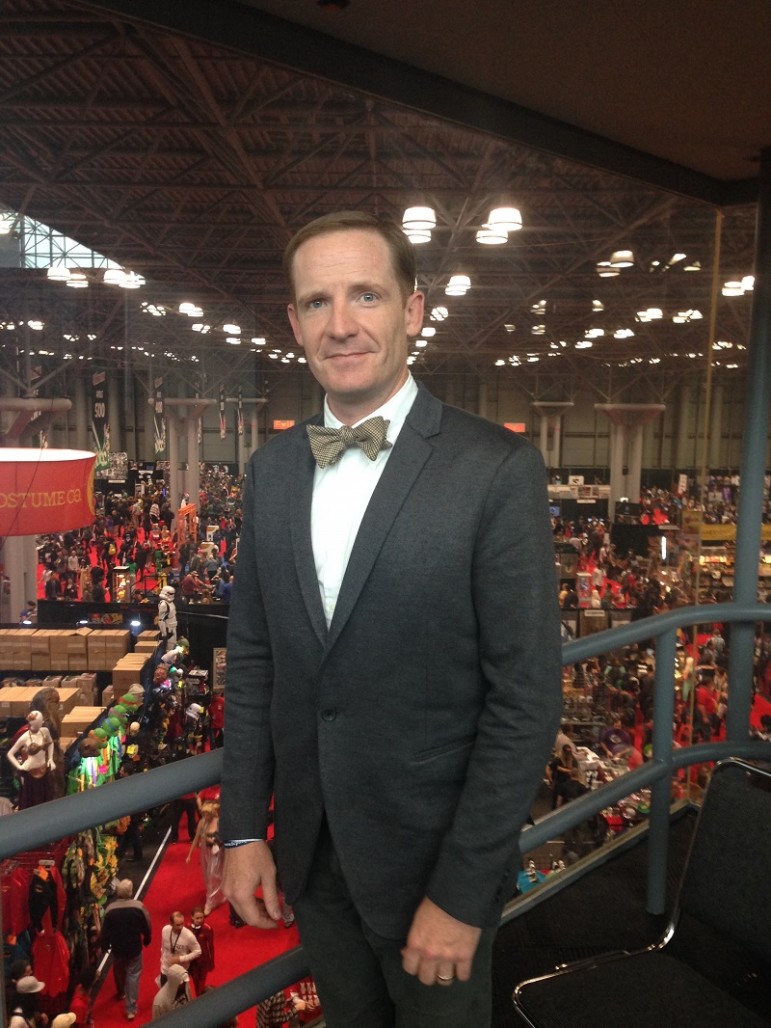 Above and away from the crowds of this year’s New York Comic-Con, I had the pleasure of sitting down with Marc Evan Jackson (known for his roles in Brooklyn 99, 22 Jump Street, Kings of Summer, & Drones as well as his role as Sparks Nevada Marshall on Mars in the Thrilling Adventure Hour) who is promoting The 2nd Annual Detroit Party to benefit the Detroit Creativity Project, where he serves as President. This was personally quite a thrill for me being a fan of TAH and hailing from Detroit. Bits where we went off-topic reminiscing about The Hunter House or the Woodward Dream Cruise have been removed, but know they at least happened.
Above and away from the crowds of this year’s New York Comic-Con, I had the pleasure of sitting down with Marc Evan Jackson (known for his roles in Brooklyn 99, 22 Jump Street, Kings of Summer, & Drones as well as his role as Sparks Nevada Marshall on Mars in the Thrilling Adventure Hour) who is promoting The 2nd Annual Detroit Party to benefit the Detroit Creativity Project, where he serves as President. This was personally quite a thrill for me being a fan of TAH and hailing from Detroit. Bits where we went off-topic reminiscing about The Hunter House or the Woodward Dream Cruise have been removed, but know they at least happened.
The Detroit Creativity Project (DPC) is a group of working actors, writers, directors, and musicians whose roots are in Detroit. The roster includes artists from across the spectrum of the performing arts: a musical director for a Grammy award-winning pop artist, a rising young film director, and the creators and stars of popular television comedy shows. We are alumni of The Second City Detroit and graduates of Wayne State University. For so many of us, Detroit was the launching pad for our careers in entertainment. We are committed to giving back to the city that gave us so much.
Comics Beat: This is actually very personal to me as I was born and raised near Detroit.
Marc Evan Jackson: Really, where from?
CB: I was little outside in Bloomfield Hills, but moved away when I was 12.
MEJ: That’s not a little outside, my wife is from Bloomfield Hills. Did your family work in the auto industry?
CB: Sort of. My dad worked for a company that worked closely with GM, but we left before some of the major flops; around 2002.
MEJ: I love that you talk about a time very recent as though it were classic.
CB: Well, I’m 24…
MEJ: Gosh, are you really? Good for you. Get me my wheelchair. [Laughs]
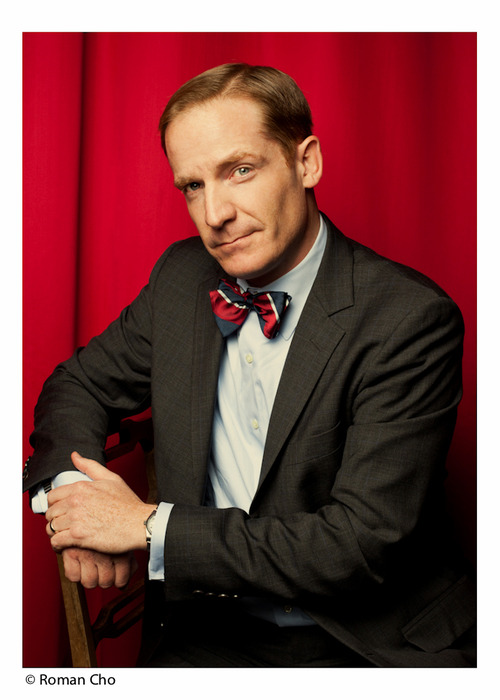
CB: What about Detroit is so important to you and what is your connection to it?
MEJ: I don’t know if you witnessed this in the 12 years that you were there, but there’s something about Detroit; it has a spirit or vibe. I only lived there for about three and a half years; I moved to Detroit to join the Second City and in that three and a half years it became home. I grew up in Buffalo, NY, I went to school in Grand Rapids, MI; I then lived all over Michigan and Maine briefly after college. Only when I moved to Detroit did I feel that draw, that pull; there’s just this underground heartbeat to Detroit. There’s a pulse of vibrance, coolness, and expression of creativity.
So Detroit is a place that has suffered a lot of egress; a lot of people have left. They took a census right before I left and they were hoping not to fall below 1,000,000 people and it ended up being 720,000, so they missed it by more than 25% – there’s just been a lot of flight of every stripe out of Detroit. But there are still students in Detroit and arts funding has gotten cut and cut; Detroit has been so good to me and to my friends and the arts have been so good to me and my friends that we wanted to give back. In 2012, my wife Beth Hagenlocker and I, as well as people I was in the Second City cast with – Marybeth Monroe from Workaholics, Keegan-Michael Key from Key & Peele, Larry Joe Campbell from According to Jim - we got together and asked “what could we to give back to Detroit?”
Our background is in improvisation and that’s what has gotten each of us our careers, and we decided one easy way to give back is to offer improv instruction free of charge in middle and high schools in Detroit. We started out flagship program, The Improv Project to do just that: to offer this instruction. One big caveat is that we’re not hoping to create more actors or comedians or writers necessarily. Improv is a skill for everybody. In order to improvise well, you have to listen and respect those you’re working with, you have to use your imagination and show up with energy, you have to find yourself saying a lot of “yes” and being overwhelmingly positive, and you have to work well as a team – it’s a great skill set for anybody. Whether you’re going to go be a doctor, a teacher, or anything at all.
Comics Beat: It’s a skill that seems like it can open doors you never thought were in front of you?
MEJ: It absolutely does. It also makes you see doors that you might’ve not been aware of otherwise. It takes the pressure off everything being perfect, it takes the pressure off having the right answer – it spurs curiosity. [...] You’ll do an improv scene about something and realize when you’re done that you may not know much about that subject and find yourself researching it. It inspires a confidence and a communication skill. [...] When you’re in middle and high school, the stakes seem high; everything seems important. There’s such an impetus to be cool or tough or whatever and especially in a hard-bitten place like Detroit that’s the case. Improv erases a lot of that, it makes you feel fine about saying “I don’t know the answer, could you tell me about that?” rather than going “I know.” Instead of the knee-jerking with “you can’t teach me anything,” it puts you in the other direction and makes you think that it doesn’t make you dumb to ask a question.
“Tell me about what you do, I don’t know anything about that. I’m 13 years old, why would I know about that?”
CB: So it can take down that front that people feel they need to put up?
MEJ: Exactly. It crashes through that barrier, in crashes through those obstacles that we put in front of ourselves. The ones that keep you from talking to people, that keep you from asserting an opinion, from finding yourself. It’s such a good communication skill, and again, it’s overwhelmingly positive, it’s good for interviewing skills for jobs or colleges. We are working on measuring our results; doing incoming and exiting surveys with our students, seeing how it affects their test scores. All the schools want to know that this has correlates to the Common Core Curriculum. It really does though, [improv] will make you a better learner; a more curious, more interesting, and more interested person.
CB: How does it feel to lend credence to an enterprise for good with your name and career?
MEJ: My career and my name has become whatever it is currently so gradually that it doesn’t feel like there’s anything to offer. This is something I’d care about whether I was in the public eye or not, it’s a total no-brainer. I think far more drastic a name are people like Keegan-Michael Key. When we go back to Detroit, we were there last in August for the improv festival; the performances go: middle school, high school, my group The 313 (the area code of the city of Detroit and features Keegan-Michael Key, Larry Joe Campbell, Joshua Funk, Nyima Funk, Andy Cobb, Maribeth Monroe, and Jaime Moyer), and then we had the kids come back and perform with us. To watch these middle and high school students perform with Keegan was something I’ll never forget as long as I live.
For myself and for people far more famous than I’ll ever be, it’s easy. It’s such a good thing to watch the transformation in these kids and I can’t imagine not doing it.
CB: While I’ve never been back, I kind of think that underground pulse you mentioned is expressed in a hope for Detroit. Sort of the certainty that it’ll come back?
MEJ: I think that a Detroit renaissance is inevitable, but if it doesn’t happen now with all that’s going on – all the focus, all the dollars, all the energy – then it never will. My wife and I, representing the DCP, were back in Detroit just a few weeks ago for the 1st Annual Detroit Homecoming. They reached out to expats all around in business, entertainment, sports, government, everything, to come back to Detroit for a summit. They said “let us take you around Detroit, let us show you the changes that have taken place already, and have your input on what you can do.” Beth and I were back as liaisons, sort of, to the Hollywood community, but Warren Buffet was there – there people there that were billionaires who run companies that can decide to put a call center in Detroit, they can decide to open a branch in Detroit, they can look into manufacturing their next product there.
It was encouraging to know that it wasn’t just some underground, improv theatre, artistic thing. People from all walks of life that got their start in Detroit or went to school in Detroit – anybody who has any connection to it looks back and says “I want to be part of the conversation in Detroit, I want to help with what’s next and see what I can do.” This meeting was powerful; so good for connections and networking. We were able to match-make for people who should know each other and people did that for us and it’s been pretty great.
CB: I have some friends who are interested in urban development and urban planning and it’s been such a foundational place for them to go.
MEJ: It’s a laboratory, right? There’s nowhere else like it right now.
CB: People have the opportunity to almost beta-test infrastructure systems like urban farming.
MEJ: Sure, like communal living. I mean, you can buy a house there for $5,000 right now.
CB: Yeah, but you will have to remove the tree.
MEJ: Oh sure, the one’s that’s growing inside your house? No, that’s true. They’re calling it the new Berlin, but they’re also calling it the next Silicon Valley. Companies are moving there because there’s skilled work forces, housing is cheap, and there’s an awful lot of land around.
There’s nothing like Detroit. You have an idea, you’ve been there, but for people that haven’t it’s so hard to describe Detroit and what it looked like. Even in the late 90’s when I was there…to describe the block-after-block of burned out buildings that had been burned since 1967 and nobody’s touched it. It’s hard to convey that to people who haven’t gone.
CB: Looks like we have some overlap, time-wise.
MEJ: Yes, but you were likely in diapers.
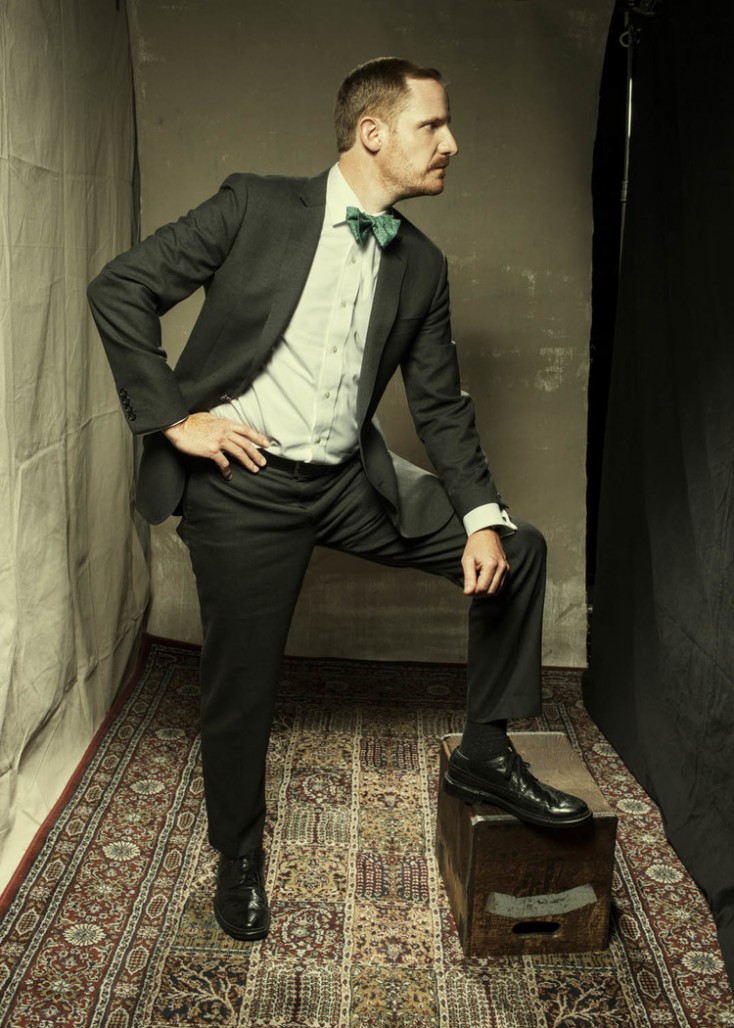
Credit: Roman Cho
CB: One of the things about DCP that really excites me is that it reminds me of the little movements that ended up spawning things like Motown; these beautiful things that could have only come out of Detroit.
MEJ: I’ll tell you what: this Detroit Homecoming made us aware of other groups doing similar things that we’re doing, people doing complementary things – a lot of puzzle pieces got put together. We’ve met groups of people that are literally doing expatriate fundraising for Detroit. There’s a group called Born and Raised Detroit and there are a number of groups like that without this homecoming, we would’ve never known existed.
CB: Thank you so much Marc for discussing this project.
MEJ: Of course, and thank you.
Marc Evan Jackson is a improv performer, voice, TV, and film actor currently in Los Angeles. He is the voice of Spark Nevada, Marshall on Mars on the monthly live radio show, Thrilling Adventure Hour and is one of the founders of the Detroit Creativity Project, where he serves as President. Find more information on the Detroit Creative Project here.
Find tickets for the 2nd Annual Detroit Party benefiting the DCP, hosted by Second City Detroit alum Keegan-Michael Key from Key & Peele here.
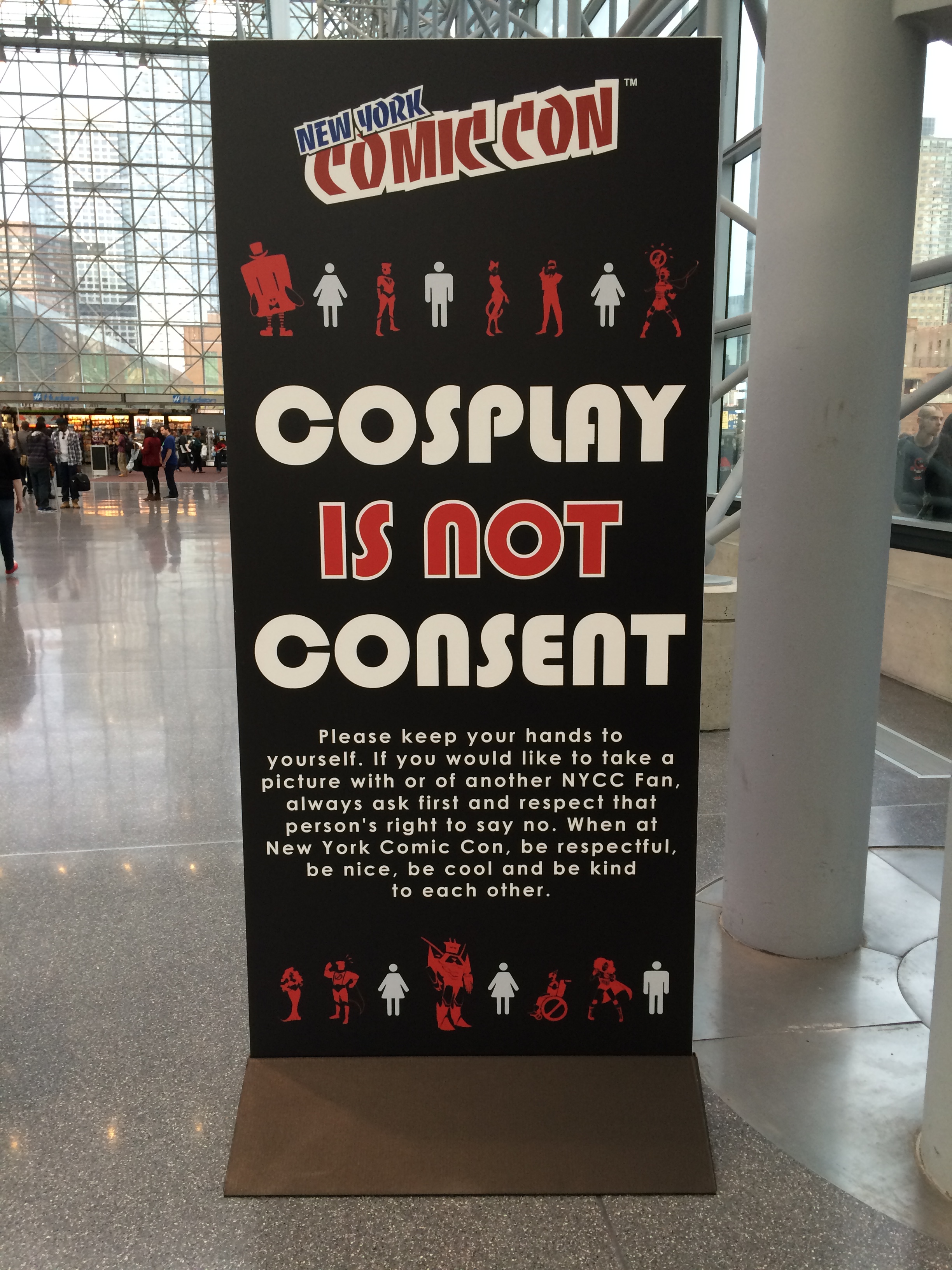 Once again, Lance Fensterman and staff appeared at the end of the show to hear feedback from attendees.
Once again, Lance Fensterman and staff appeared at the end of the show to hear feedback from attendees.
For the first time, there was a queue before the actual panel, and the room had a good attendance.
Who else was on the panel?
- Jackie Williams, Brand Marketing Manager
- Peter Tatara, International Director, Content and Marketing (responsible for panels)
- Brian Stevenson, Brand Marketing Director (responsible for Merchandise and Fan Experience
- Matt Wasowski, Festival Director of New York Super Week
- Jenny Martin, Account Executive (Sales Team)
So, this year’s Zeitgeists:
Main Stage and Empire Stage
At a previous Q&A, an informal poll was taking of clearing the halls. An online survey showed a 70% approval for clearing the halls. Overall, attendees appreciated the new system, and it worked well. However, there was a problem with the Empire Stage (Hall 1E). There is no room for queuing people for upcoming panels outside the hall. (1D is connected to the stockyards in 1C, and can feed directly into the hall.)
The Walking Dead panel is always the most popular, and it caused the most concerns with security, communication, and safety.
One attendee suggested that there be a better system for allowing people in those halls easier access to restroom during the event. (Another example of better security communication.)
100+ security guards were added to the show contingent over last year, and ReedPOP always tries to improve communication.
Reed is open to better streaming of the events, perhaps increasing the number and distribution of screens around Javits.
Some armbands had similar colors. Reed did use every color available from their supplier.
General Panels
Many attendees criticized the difficulty of attending the panels in 1A.
Camping for those panels is now as problematic as the camping which once occurred in the big media panels.
Some people were observed as sneaking in via side doors.
It was suggested that the RFID badges be used to make reservations (which generated a mixed response from the audience). Lotteries, wristbands, clearing the room are all possible solutions which will be considered.
Also, it would help if the mobile app updated the occupancy status for each panel.
Cosplay
One of the problems which actually hit the web during the show: the new weapon policy, and Reed’s policing, causing many cosplayers to be disarmed.
Why are retailers allowed to sell blades if such weapons would be in violation of the show’s rules? The answer: the vendors must sell items boxed and sealed. Once an attendee opens that box, the weapon will be quarantined.
Ticketing
Why were 3-Day and 1-Day tickets both sold simultaneously? Reed decided to couple the option to reduce disappointment. 4-Day tickets sold out fast, and then customers had to wait for the next sale. By offering both 3- and 1-Day tickets, Reed didn’t want customers to have to wait for single-day tickets to go on sale at a later date.
Lance quashed many rumors about the site crashing:
- No VIP tickets were sold until the site went live.
- While the NYCC website did crash, the separate ticketing site did not.
- 22 (26?) people were accidentally kicked out of the ticketing queue, but all were contacted.
- The ticketing queue moved slowly (up to a two hour wait), but it did move
- Reed hates scalpers as much as attendees. They reduced the number of tickets per order from 10 to 6. Orders were scanned for possible multiplicity, and those orders were cancelled.
- They try to go after eBay sellers, but it’s a cat-and-mouse situation.
Some comics retailers did sell tickets before the publicized hour posted by Reed. Reed is aware, and is working to correct this next year. Apparently, the downtown store of Midtown Comics caused a small riot with an early sale of tickets.
One attendee had tickets lost in the mail, and lauded the excellent customer service provided in getting replacement badges. That department handled twice the number of calls from last year.
Programming
Can exhibitors do a better job of advertising the guests signing at the booths? Yes. They are encouraged to share the information, although some have short notices.
Can more Golden Age / Silver Age / underground / legendary comics creators be invited to the show? Yes. Special Edition was created to help meet this demand.
More physical maps of Artists Alley in the rows would be appreciated, as would accessibility on the mobile app.
Super Week
Why were Super Week cards automatically added to multi-day sales? Can it be separated? Yes. Reed wanted to promote the event this year.
What were the perks? Why did the Hammerstein Ballroom charge $39-$175 for an event which was also scheduled for NYCC? Reed wanted to offer the opportunity to those who could not attend the event (or wish to stand in line to get in).
Tally: 110 events, 25 venues, 10 days.
Other Stuff
Reed was lauded for partnering with The Mary Sue regarding the new harassment policy, and the Geek Girl Headquarters in 1E02. Also, the Brooklyn Defender beer was tasty. (I did not sample it, but did drink at The Beer Authority, which did partner with Reed. Recommended…a great selection of varietals!)
One fan was confused about the posted signs.
One fan was disappointed that there was not a NYCC collector pin this year, and that his collection was thus interrupted. They’ll consider a retroactive pin, and perhaps offer one for next year.
How well did the new notification system work via the mobile app? There were less than ten complaints (as of Saturday), and security handled each incident quickly and efficiently. (I can’t find any incidents online.)
In Closing…
Javits staff closed down the panel at 6:10 pm, but Lance and company continued to interact one-on-one with attendees as the room was dismantled.
My con diary will be available as soon as I recover from everything, yet I found that this show ran extremely well given the 151,000 tickets sold. I think most will laud the show. Aside from the “new normal” of instant sell-outs and high demand for programming, it seems that ReedPOP has worked out most of the problems of previous shows. There will always be new policies and challenges, but Reed always strives to improve with each show. Reed will be sending out surveys soon, and you can reach most of the staff via their bio page.
Feel free to comment below. What did you like or dislike about the show? What was your mileage?

By:
Heidi MacDonald,
on 10/12/2014
Blog:
PW -The Beat
(
Login to Add to MyJacketFlap)
JacketFlap tags:
Spider-Man,
NYCC,
silk,
Top News,
Spider-Verse,
NYCC '14,
spider-gwen,
Comics,
Marvel,
Breaking News,
Add a tag
By David Nieves
Marvel saved some big reveals for their NYCC curtain call. Among the top of those announcements is the creative team on Spider-Gwen #1. The ongoing series will be written by Jason Latour with Robbi Rodriguez and Rico Renz. Introduced in Edge of the Spider-Verse #2, Gwen Stacy Spidey has become an overnight fan favorite and the series was a no brainer for Marvel. Spider-Gwen ongoing will debut in February 2015.
Nick Lowe announced Spider-Woman #1 with the creative team of Dennis Hopeless and art by Greg Land in November.
Also announced on the panel was the Slik ongoing series launching February after Spider-Verse. Starring Cindy Moon, the character recently introduced inAmazing Spider-Man who was bitten by the same radioactive spider that gave Peter Parker his powers. Supernatural writer Robbie Thompson pens the book, while artist Stacey Lee draws them and Eisner Award winner Dave Johnson provides the covers.
We’ll update more as it comes in but in the meantime enjoy these gorgeous cover reveals.
UPDATE: Marvel announces Scarlet Spiders, a three-issue miniseries written by Mike Costa and drawn by Paco Diaz. Spider-Verse Team-Up will be coming in November. Each issue has two stories in it, pairing classic Spidey writers and artist with newcomers.


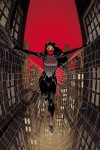

By:
Heidi MacDonald,
on 10/12/2014
Blog:
PW -The Beat
(
Login to Add to MyJacketFlap)
JacketFlap tags:
Jack Kirby,
Fantastic Four,
Top News,
James Robinson,
Top Comics,
NYCC '14,
Comics,
Marvel,
Publishers,
Add a tag
 by Alexander Jones
by Alexander Jones
What would Ben Grimm do?
After a few months of truly bizarre speculation across the internet, and denial from the publisher, Marvel confirmed this morning at their Axel-In-Charge panel at New York Comic-Con that they are indeed canceling their main Fantastic Four title. The publisher seems like they are planning something new for their roster of Fantastic Four characters, but this is mere speculation at this point. The comic is ending in 2015. CBR ran a quote from the panel that featured current author of the title James Robinson speaking on the surprise cancellation of the comic.
“That’s the thing — everyone’s upset now because the book is going away,” Robinson said. “Are they buying the book? I don’t know if they are. A lot of it is just people like to get online and moan and complain. I guarantee you if you kill of any character, the most obscure character, you’ll get one angry person that claims it was their favorite character. Jack Frost, golden age character, they’ve done something to him. Where’s the razor blades, I’m slashing my wrists. People do that on the internet, so you have to take that with a grain of salt.”
The author deserves some massive props for talking about his run on the title so honestly. Hopefully this coming change for the Fantastic Four will be what is necessary to get the book boosted into the top 50 of the Diamond Sales charts. Marvel’s first family deserves it after all.

By:
Heidi MacDonald,
on 10/12/2014
Blog:
PW -The Beat
(
Login to Add to MyJacketFlap)
JacketFlap tags:
Wonder Woman,
DC Comics,
mortal kombat,
Top News,
NYCC '14,
telltale games,
Comics,
DC,
Breaking News,
Fables,
Digital,
Add a tag
By David Nieves
Today during DC’s “Download This!” panel new books were announced that will expand the publisher’s digital comics universe. Wonder Woman 77 will be written Marc Andreyko with cover art contributed by Nicola Scott. No story details or interior artist were mentioned, but the comic will debut as a six-part weekly series in December with print editions to follow. The series follows Lynda Carter’s TV Wonder Woman and is a natural extension of what the publisher started when they launched Batman 66.
Fables: The Wolf Among Us spins out of the popular Telltale games series which was originally based on the Bill Willingham Fables series. The creative team on the digital comic will include Matthew Sturges who will co-write with Dave Justus with art by Steve Sadowski, Travis Moore, and Shawn McManus. Covers will be by Chrissie Zullo. This will be Vertigo’s first digital series.
Mortal Kombat X will be written Shawn Kittelsen and drawn by Dexter Soy with covers by Ivan Reis. The series serves is a prequel to the highly anticipated game of the same name by NetherRealm Studios and Warner Interactive Entertainment. The story takes place 25 years after the events of 2011’s Mortal Kombat game and will tell the stories of characters both new and old.



By David Nieves
During Marvel’s “Women of Marvel” panel it was revealed popular YA author Margaret Stohl will be writing a new YA novel style Black Widow book for 2015. When talking about the project Stohl had this to say, “This is the badassiest thing I’ve ever been asked to work on in my life. Black Widow is the very best hot mess I know. She kicks ass, she’s more of a Wolverine than a Captain America.”
Also on the panel was Stacey Lee, who is working on something that will be announced at the Spider-Verse panel at 4 PM later! Which could in fact be the recent Spider-Gwen book announced earlier this week.
To round out the announcement side, the panel revealed a new Gamora series written by Nicole Perlman (Guardians of the Galaxy Movie) and the cover for issue 1 is by Francesco Mattina. Pearlman said, “It delves into who Gamora is, see her relationships with everyone, struggling with her past – it’s going to be amazing and I’m so excited.”

By:
Heidi MacDonald,
on 10/12/2014
Blog:
PW -The Beat
(
Login to Add to MyJacketFlap)
JacketFlap tags:
Fandom,
Cosplay,
Top News,
The Legal View,
NYCC '14,
design,
Conventions,
Culture,
Commentary,
style,
Fashion,
Add a tag
 Signs aren’t the only thing greeting attendees at the entrance to New York Comicon. Amidst the registration booths and all too quickly emptied bins for lanyards ReedPOP has its own boutique, featuring the geek-chic fashion of Ashley Eckstein’s Her Universe line.
Signs aren’t the only thing greeting attendees at the entrance to New York Comicon. Amidst the registration booths and all too quickly emptied bins for lanyards ReedPOP has its own boutique, featuring the geek-chic fashion of Ashley Eckstein’s Her Universe line.
Her Universe has become a significant presence at both the San Diego and New York conventions, which in turn reflects as place as a market leader in pop-culture inspired fashion. I had the pleasure of speaking at length with Ashley back at SDCC after her successful geek couture fashion show, and as an attorney I have to say that she is a role model for anyone who wants to incorporate copyrighted and trademarked material in their line. In a world where “it’s better to ask forgiveness than permission” has led any number of creators astray, she has from the outset been conscientious (and ambitious!) in licensing characters for Her Universe clothes.
But that’s not the only way in which Her Universe reflects the better angels of geek community’s nature. Besides integrating the participatory spirit of comics-related media discussed in my last post, Ashley has also been a prominent advocate of geek fashion’s capacity to empower those who wear it, both through her clothes and her anti-bullying activism. Create, speak, show others who you are with fear – where the less imaginative may just see licensed properties, her community sees freedom woven into her designs.
Which brings us to the future of geek couture and its role in the community’s future. Walk around San Diego and New York Comic-Cons and you’ll see expressive fashion everywhere, from handcrafted TARDIS earrings and comic-related t-shirts carried in the ubiquitous TARDIS bag to sophisticated cosplay and brands such as Her Universe itself. As the Her Universe show embodied back at San Diego, the key to the future is to go beyond prints and other reproductions of licensed material to transformative geek-inspired design – in fact, for a useful indication of where things are going, watch the development of the co-branded Marvel line announced last July.
As I discuss in my Fashion Ethics, Sustainability and Development class for the Fashion Law Institute, when we wear clothes we wear ourselves – our values, our aspirations, our communities.* It should, then, come as no surprise that when we look at geek couture, we see the future.
*Check out Professor Susan Scafidi’s “Fashion as Information Technology” for more on this.
By David Nieves
Next year will be a big year for Ant-Man as the character gets ready to hit the big screen in next Summer’s Marvel Studios film. Announced today at New York Comic Con was a new Ant-Man title written by Avengers World scribe Nick Spencer and drawn by Ramon Rosanes.
This book will feature Scott Lang in the costume. Spencer talked a little about the upcoming book saying, “Scott is a character I really connect with, Scott wants to be a hero and he wants to be a good guy, but he’s got a checkered past, he has a tendency to take shortcuts and get in his own way… all these marks of a great Marvel character.”
Spencer said that if readers enjoyed Superior Foes of Spider-Man or Cloak and Dagger, they would enjoy the laughs and drama of this book. Ant-Man will launch January 2015.
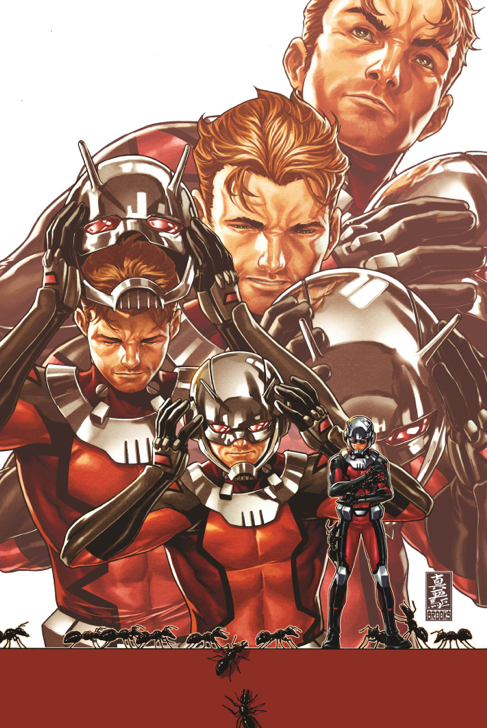
By David Nieves
During Marvel’s “Axel-in-Charge” panel at NYCC, the publisher’s editor-in-chief Axel Alonzo announced that Spring would see a brand new creative team on Hawkeye Vol.2. Marvel enlisted the creative team of Jeff Lemire and Ramon Perez.
Lemire was quoted on the panel as saying, “I think it’s a high water mark for modern comics. I cannot hope to replicate their (Fraction and Aja) success, but I can hope that I can tell my story as best I can… I’m really, really proud of what we’re doing.”
Hawkeye #1 by Lemire and Perez is scheduled for a March 2015 release.

By David Nieves
Saturday, following Dark Horse Comics recent success with video game adaptation comics (The Last of Us: American Dreams); the publisher announced a partnership with CCP Games for a new mini-series based on the upcoming EVE: Valkyrie game.
In development at CCP’s Newcastle studio, EVE: Valkyrie is a multiplayer dogfighting shooter set in the EVE universe that uses virtual reality to give players the sense of being real pilots in EVE Online spaceships. It is based on the EVE-VR tech demo that won several major awards at E3 2013.
This four-issue mini-series will be written by Brian Wood (Star Wars, DMZ) and illustrated by Eduardo Francisco (Captain Midnight). It’s been a busy week for Wood, who was announced as the new writer on Spawn and gave details on ending his book The Massive.
Eve: Valkyrie #1 is on sale June 3, 2015

by Edie Nugent

AMC’s The Walking Dead panel was packed nearly past capacity on Saturday afternoon at NYCC. When the 3500 floor seats of the main stage hall were filled, fans stood along the sides of the room-shunning available balcony seating to be that much closer to their favorite TV stars. The panel was moderated by Talking Dead host and perennial fanboy Chris Hardwick who was red-faced with excitement as he introduced an exclusive clip showing the first few minutes of the season five premiere. Hardwick was joined by Greg Nicotero, director of the season five premiere, showrunner Scott Gimple, executive producer Gale Anne Hurd and executive producer and series creator Robert Kirkman.
Season five picked up right where season four left off, with Rick and the remaining survivors of his group being held prisoner in a boxcar inside the Terminus compound. They are ripping their clothes apart, fashioning weapons out of belt buckles and shoe laces. The group hears movement outside of the container, and all assume defensive positions near its entrance. Suddenly, the boxcar opens from above and a cannister is dropped inside leaking knockout gas. After succumbing to the fumes, the group awakens to find themselves bound and are made to kneel before a draining sink used for livestock slaughter. Terminus, it seems, is indeed a colony of cannibals.
The clip ended abruptly, and Hardwick remarked how much fun is was to listen to the shocked audience reaction live, joking: “we should get together as a group and watch it every week.” Director Greg Nicotero remarked that, as someone who has directed several premiere episodes of Walking Dead, it was nice to continue the momentum of the end of last season into the beginning of season five. He also mentioned he wanted to make the season opener “super intense…I’ve seen it ten times, and I still get chills.”
Hardwick asked Gimple if season five might unlock more of the backstories of the group- finding out more about who they were before the zombie apocalypse. Gimple said to expect to discover about the more recent past of the characters, “in some very deep ways, we’re also going to play with time a bit.”
Kirkman teased that there are “a lot of big moments from the comic book series that will be pulled into the show this season…we’re still going to be changing things up a bit…I think it’s safe to say this season is going to follow the comics much closer than we have in the past.”
When asked to describe the season in a few words, Hurd replied: “Kick-ass, utterly relentless, and totally heart-breaking.” She went on to announce that the second half of season five will premiere on February 8th, 2015.
Hardwick then brought out the cast one by one. The applause, screams and cheers that went up throughout the main stage hall were deafening. Present for the panel were: Andrew Lincoln (Rick), Steven Yeun (Glenn), Lauren Cohan (Maggie), Michael Cudlitz (Abraham), Danai Gurira (Michonne), Melissa McBride (Carol), Chad Coleman (Tyrese), Sonequa Martin-Green (Sasha) and Norman Reedus (Daryl).
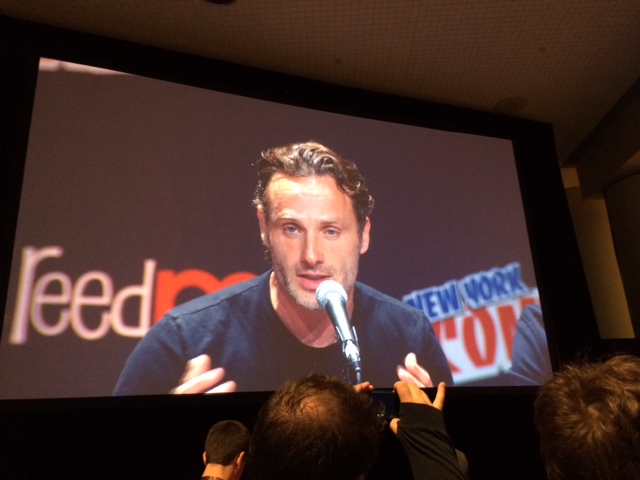
Hardwick began his series of cast questions by addressing Lincoln: “We finally at the end of last season saw the transformative moment when Rick came back.” Lincoln agreed, saying “I think you meet a man very much at the peak of his powers. I mean, he just bit a guys’ throat out. I think it’s safe to say I’ve been listening to a lot of Prodigy and death metal.”
When Hardwick asked Yuen where his character was emotionally following the events of season four, Yuen explained that Glenn “woke up in a prison with all his loved ones gone. He has a moment to himself and says: ‘eff this-I’m going to go find everybody’ and he treks out and finds everybody.” Co-star Lauren Cohan added: “the amazing thing at the end of season four is that we found each other,” looking at Yuen, “ I felt like he was a soldier coming back from war.” Yuen asserted that he felt Cohan’s Maggie was “equally a soldier.” She went on to say that the next step for Maggie would be to find her sister Beth, and “keep everyone fortified.”

Michael Cudlitz emphasized that every character in the world of The Walking Dead has suffered massive loss: “so what we’re dealing with day after day is dealing with loss on top of loss” and that the supportive, safe environment the cast and crew create is essential to making those performances “ring true.”
Gurira thanked Kirkman and Gimple for imbuing her character Michonne with an “unapologetic strength to her, and you see that with a lot of the women characters on this show, which is really exciting.” She added that she felt Michonne’s strength hadn’t shifted through the events of the show, but rather but had gone through a transition because of her relationships with the group.
The deep, emotional connections the actors had with their characters was especially clear as McBride spoke of her experience playing Carol, saying “it’s something I’m so proud of, and for the character it’s been something I never saw coming, and I think I’m going to cry-because I love her.” Her eyes filled with tears, prompting Reedus to walk down the panel to hand her a tissue.
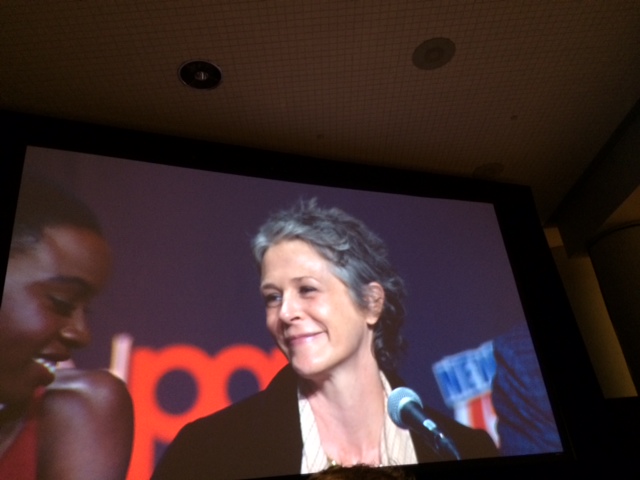
“Without the children, where is our future?” Coleman asked, explaining how his character Tyrese and Carol had gone through such a terrible experience in attempting to protect Lizzie, Micah and baby Judith in season four. “He’s hurting tremendously,” he added, saying that he felt Tyrese had forgive Carol for her decision to kill Lizzie after she murdered Mika-but that Carol was “on shaky ground.”
Martin-Green was proud of what she felt were “the prevailing messages being taught on a show like this, of hope and survival and family and love-making it through adversity.” These themes were especially resonant to her now, she said, as she is pregnant with her first child-due in January.
“A lot of times when Daryl has been killing things, he’s been crying while he’s doing it,” Reedus said, speaking to Hardwick about how his character had opened up over the previous season. “We really feel connected to these characters and feel connected to each other-we really care about each other-so teetering on that line of being ferocious and being vulnerable-it’s a real teeter-totter. Everything feels really real.”

It was clearly also “really real” to the thousands of fans in attendance-some of whom were moved to share their feelings with the cast during the fan Q&A portion of the panel. One such fan, Michael, told the of how he was badly injured while coming to the aid of a neighbor who was being attacked. He told the panel that the strength of the shows characters had helped him to have the courage to move forward in his life and recovery. Cohan was visibly moved hearing his story as was Guira who addressed the fan directly, saying: “to know that there’s any sort of message we’re conveying that gives you hope and courage-it makes it unbearable how wonderful it is to do what we do-to know that it resonates to you and emboldens you is really a blessing to us. You are the true survivor.”
by Zachary Clemente
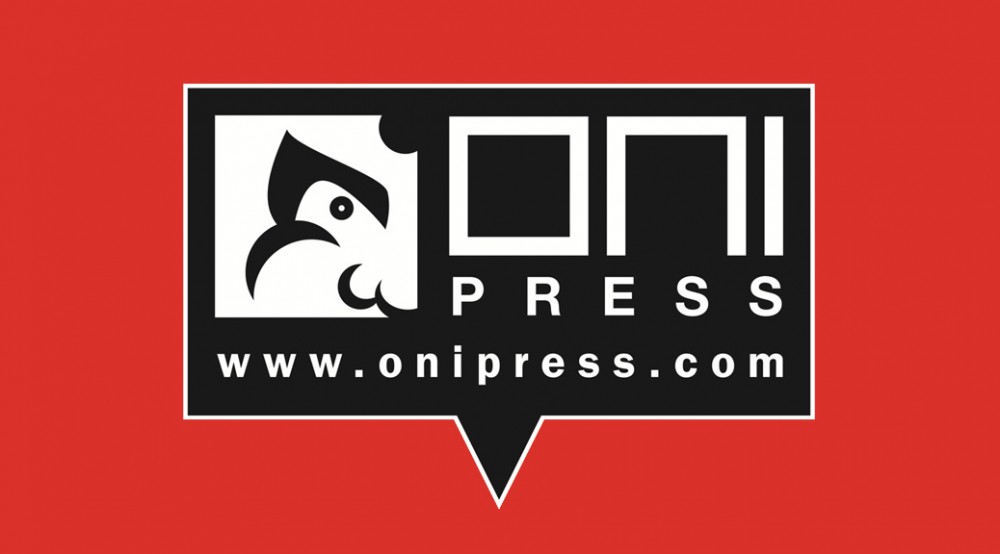 NYCC started all a-bluster with large announcements, crazy crowds, fantastic costuming, crowds, swathes of booths manned by insightful and fun comics publishers ready to show off their books; also crowds. I swung by The Oni Press Comicstravaganza panel to see what Oni Director of Publicity John Schork had in store for us and safe to say, he did not disappoint.
NYCC started all a-bluster with large announcements, crazy crowds, fantastic costuming, crowds, swathes of booths manned by insightful and fun comics publishers ready to show off their books; also crowds. I swung by The Oni Press Comicstravaganza panel to see what Oni Director of Publicity John Schork had in store for us and safe to say, he did not disappoint.
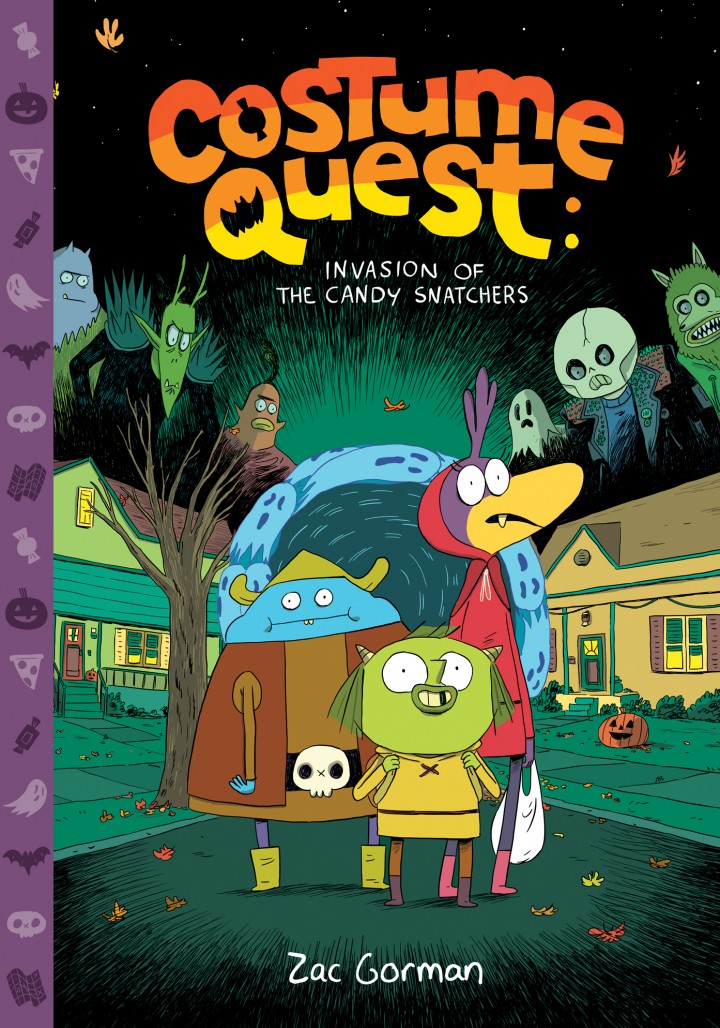 If you haven’t played Doublefine’s Costume Quest, stop reading and go play it right now. Filled to burst with Doublefine’s usual wit and charm, cartoonist extraordinaire Zac Gorman brings a fun tale in time for Halloween of a monster in a child-stealing society who only wants to hang out with his friends and eat candy. Gorman’s work is a personal favorite of mine and I’m really rather excited to see him work on this property!
If you haven’t played Doublefine’s Costume Quest, stop reading and go play it right now. Filled to burst with Doublefine’s usual wit and charm, cartoonist extraordinaire Zac Gorman brings a fun tale in time for Halloween of a monster in a child-stealing society who only wants to hang out with his friends and eat candy. Gorman’s work is a personal favorite of mine and I’m really rather excited to see him work on this property!
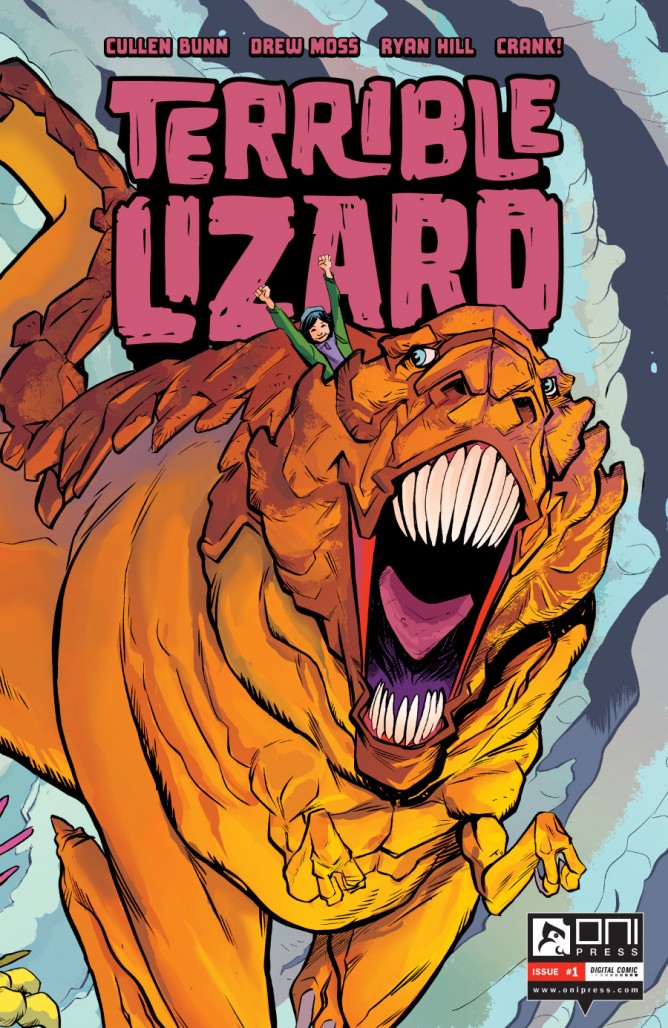 No matter how much work Cullen Bunn gets at Marvel, the writer of one of Oni’s most successful titles, The Sixth Gun can’t seem to stay away. His new series Terrible Lizard, featuring artist Drew Moss, colorist Ryan Hill, and letterer Crank! looks to surprise and excite when it hits the stands. A young girl befriends a time-shifted dinosaur and together, they fight giant monsters. Safe to say, I’m sold.
No matter how much work Cullen Bunn gets at Marvel, the writer of one of Oni’s most successful titles, The Sixth Gun can’t seem to stay away. His new series Terrible Lizard, featuring artist Drew Moss, colorist Ryan Hill, and letterer Crank! looks to surprise and excite when it hits the stands. A young girl befriends a time-shifted dinosaur and together, they fight giant monsters. Safe to say, I’m sold.

Page from “Kaiju Max” by Zander Cannon
It looks like Oni is going whole hog with giant monsters with their next new series Kaiju Max. Zander Cannon, known for working on Top 10 and Smax with Allen Moore, now writing for himself (as well as coloring and lettering) brings us the battles and romps in a top-secret prison island for dangerous Kaiju inmates, kept in line by their Sentai, mech-weilding guards. I haven’t been following Cannon’s career too carefully, but now I wish I had!

B&W Cover for “The Sixth Gun: Dust to Dust”
Man, Bunn is all over the place! Hot on the heels of the Sixth Gun series and Terrible Lizard is a new miniseries in the Sixth Gun world; Dust to Dust. According to Schork, this book, while guaranteed to please any and all fans of the series, is particularly a treat for readers who are fond of character Billjohn O’Henry.
John Schork was a fun and charismatic host who, after the announcements were said and done, used the rest of the time to field questions from the audience and play a little game which involved attendees stating a non-Oni title they’re enjoying and Schork recommending an Oni title would also enjoy as well as providing them with a free copy. Books such as Charles Soule’s Letter 44, Joshua Fialkov’ The Bunker, Cullen Bunn’s The Sixth Gun, Rick Spears’ The Auteur, and Ted Naifeh’s Princess Ugg were recommended. I am not ashamed in saying that I took advantage of the system by naming James Stokoe’s Orc Stain specifically to receive a free copy of his Oni book, Wonton Soup. I wouldn’t try it though, Schork’s onto us. Oni is a publisher that too often flies under the radar of many a reader, but that definitely appears to be changing and I look forward to seeing more of their line!
View Next 25 Posts



















 “In my day, we called it “Nickelodeon”. And when they signed off at 8 PM, we switched over and watched the scrambled Playboy Channel feed.”
“In my day, we called it “Nickelodeon”. And when they signed off at 8 PM, we switched over and watched the scrambled Playboy Channel feed.”




















 At 12:30, staff began handing out the wristbands, and were adamant about people wearing them. (I was trying to walk and band myself, and the staff made me stop and wristband.) Then we congregated at the big side door leading directly into 1-D. There was a small hiccup between letting the VIPs in before the hoi polloi, but it was all orderly. No running, but I hustled, and got a good seat right next to the microphone.
At 12:30, staff began handing out the wristbands, and were adamant about people wearing them. (I was trying to walk and band myself, and the staff made me stop and wristband.) Then we congregated at the big side door leading directly into 1-D. There was a small hiccup between letting the VIPs in before the hoi polloi, but it was all orderly. No running, but I hustled, and got a good seat right next to the microphone.
 While we’re waiting, there was a DJ and comedian keeping us all entertained. They both did a great job, but it was early… dunno what they were feeling on Sunday!
While we’re waiting, there was a DJ and comedian keeping us all entertained. They both did a great job, but it was early… dunno what they were feeling on Sunday!
















 They brought up each creator one-by-one to talk about their books. All are amazing in different ways! (Finnish heavy metal band with a bear on drums. Simon and Kirby original art. El Deafo. The Kennedy Assassination. Squirrel Scout cookies.)
They brought up each creator one-by-one to talk about their books. All are amazing in different ways! (Finnish heavy metal band with a bear on drums. Simon and Kirby original art. El Deafo. The Kennedy Assassination. Squirrel Scout cookies.)







































































“….In fact, someone is camped out for the 2015 TeenWolf panel right now!”
“In fact”… Seriously? Please tell me this is not true. They haven’t even announced programming, right? I want photos, a live blog, twitter, and a podcast of this person. Hahaha!
I think the best panels at the con were thrown by BUDDY SCALERA for his series of art school panels. Every one was a standing room only panel, so I think maybe next year, they should move them to bigger rooms. That and the Comixology panels were packed. I thought this year, NYCC was just amazing overall.
In the past, changing rooms were located in the 2-D area. Many of these rooms are used as green rooms by exhibitors, and FedEx Office has a location there as well. The best solution? Set up a tent outside like at Fashion Week. Those models are changing backstage, so use whatever tent/setup they use. Have Michaels or Jo-Ann sponsor the tent. Charge a small service fee for anyone who wishes to use the tent.
I was near the front of the line for the Disney panel on Thursday morning, and had no problem standing in line, getting a wristband, and getting in and out of Hall 1-D (Main Stage).
Yes, people will stand in line for anything, at any time, EVEN if they have the wristband already, because they’ll want a good seat. (My goal was a seat next to the microphone, as I had a very cool question for Brad Bird. But there was no Q&A.)
I’m on the side of wristbands and emptying the hall. That means:
more people getting to see something
more actual fans attending, not campers
less time wasted standing in line
easier line security (as only those in line have wristbands, not standby, reducing crowds)
easier crowd safety (you only line up an hour before the panel, or you line up in a stockyard away from traffic.)
It looks like ReedPOP will expand the wristband system to the other large panels next year (1-A, 1-E).
Can’t clear Hall H of 6000 people in 5 minutes? Then the fire marshall should shut it down. Looking at the plans and the street view on Google Maps, Hall H has 20 doors which open onto the plaza, and 9 which open onto the lobby. (As well as exits behind the bathrooms, which I suspect are used for celebrities.) One security guard at each set of doors on the outside, a few more on the inside.
Have people camp out in one of the PetCo parking lots overnight for wristbands, and while waiting for the panel during the day. Leave the Plaza clear for clearing the rooms. Maybe you have the hordes enter via the 30-foot door, and allow special needs, VIP, Media to use the lobby entrance.